

The Saint
Storm Éowyn Hits St Andrews

SOFIA PANEK News Writer
On 24 January, Storm Éowyn ravaged across Scotland with record-breaking wind speeds of over 100mph. This made it the strongest windstorm in the UK in over a decade. Ramifications of the storm ranged from inconvenient travel disruptions to costly material damages, impacting local communities and small businesses.
The storm imposed significant damage on Scottish infrastructure, interrupting power lines and leaving 300,000 Scottish residents without electricity. Scottish railways were disrupted for several days due to fallen trees obstructing train tracks. With the Met Office issuing a red weather warning on 24 January, people were advised not to travel on roads between the hours of 10am and 5pm. Edinburgh Airport was
forced to limit its operations as many airlines made the decision to suspend flights.
Storm Éowyn struck just as students were returning to St Andrews for the Candlemas semester, subjecting travelers to flight delays, cancellations, and lengthy layovers. Ainsley, a third-year student from Texas, recounted the story of her flight cancellation on the day preceding the storm: “I was en route to the Austin airport when I received the message that my flight from New Jersey to Edinburgh was cancelled, so it was a bit of a scramble to get my connecting flight rebooked.”
Although she faced an severe bout of last-minute rescheduling and two protracted layovers, Ainsley remarked that she was grateful to have had an extra day to spend with her family. “There are definitely other people out there who have suffered much worse from Storm Eowyn,” she commented.
Meanwhile, in St Andrews, the Har-
bour Trust moved vessels to its inner harbour as a precaution. Since Éowyn was a south-westerly storm, the hills of Fife protected the Harbour from damage that would typically occur during a north-easterly storm. This meant that, compared to the devastation of Storm Babet in 2023, the Harbour did not sustain serious damage.
While students experienced travel disruptions and St Andrews locals witnessed the total or partial closure of shops and cafes, the effects of the storm were particularly severe for small businesses in the local community. One such small business is East Neuk Market Garden, a four-acre farm located in Bowhouse, St Monans, in the East Neuk of Fife. East Neuk Market Garden supplies vegetables and seasonal produce to various local restaurants and cafés, including the popular St Andrews lunch spot Five Acres, to whom they provide fresh ingredients for the seed-to-plate canteen’s
InFocus: Professor Andrew Brierley
by Celeste Chave
At coordinates -45.407989; -60.661392, on the southern coast of Coronation Island in Antarctica’s South Orkney archipelago, lies a bay that now bears the name of a distinguished scientist. Brierley Bay, recently renamed in honour of the late Professor Andrew Brierley of the University of St Andrews, stands as a tribute to his remarkable contributions to marine science. Read on Page 6.
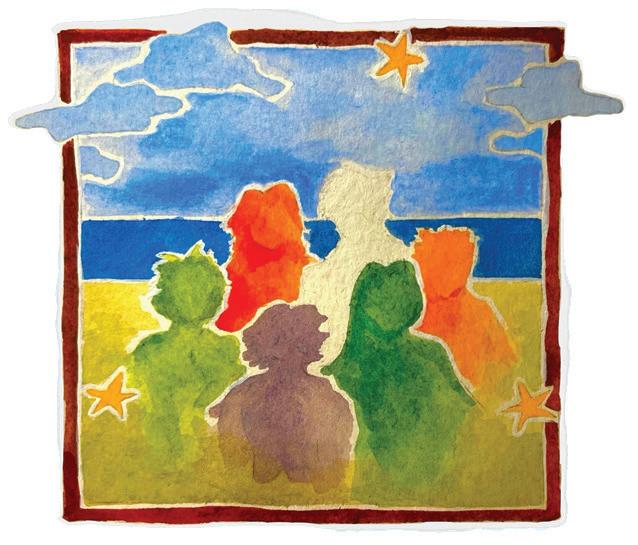
“I Don’t Want A Man in the Process”
by Celia Irving
Creating an academic family is always a bit stressful: you’ve got to organise pre-drinks, dinners, Raisin, and more — all in a modest effort to win over eager first-years. While many of us remember the hazy mayhem and nostalgia of our academic childhoods (though some of us don’t remember a thing), not all academic families are perfect. Read on Page 15.

What’s Inside?
Welcome back! After that dreadfully long winter break, we hope you’ve settled in, navigated your timetable, and left all your Martinmas dramas at the Candlemas doorstep. Though you may not realise it, we’re rather lucky to have two semesters: one to settle and another to thrive. In the time that has passed from last semester, The Saint has gone from strength to strength. We were dubbed the Best Publication, Best Digital (yes, those TikToks were worth it), and our Photo Editor Alden was awarded Best Photographer. So yes, perhaps last semester was Riley and I’s period to settle and now is our time to thrive. Issue 286 contains stellar pieces such as our front-page article on Storm Éowyn, the science behind hugs, and a surprisingly interesting feature on absent academic fathers.
And as week three begins to take hold, the event all singletons dread appears. Tomorrow is, of course, Valentines Day — queue resounding “eurghs”. And if you’re like me, you’ll be celebrating its sister event ‘Galentines’ — queue shrill ‘yasses’ and ‘slays’. Let’s be honest, it’s not the same and that’s not to say I dislike my friends (the single ones of course) but Valentine’s day is one day of the year centred on everything I’m not. Happily in love. And yes, I’m sure the time will come as my friends (the one’s in love) will tell me and yes ‘Galentines’ is arguably more fun and you can watch Bridget Jones amidst a new level of

relatability. But if anything, take immense joy in the fact that Valentine’s Day is a mere 24 hours and you can continue jibes at your coupled friends on the 15th. All joking aside, “love is all around” and yes that was an attempt at Hugh-Grant-inspired wisdom. But it is true. It’s in a cup of tea made by your flatmate. It’s a compliment from your mother. It’s even a simple “how are you?” from a friend you’ve not spoken to in a while. Love is threaded through every aspect of life. And loving someone in a relationship is born out of these shared experiences with others. You’ll never be able to love another if you can’t find love in the little things, and most importantly, yourself.
Yes, it sounds a lot like a t-shirt from George at Asda but you simply must find love in yourself and admittedly it can be the hardest medium of love to find. And don’t take it from me, take it from everyone’s favourite situationship-drawn-gal: Carrie Bradshaw, whose parting words in the final episode of Sex And The City are as relevant in 2025 as they were eleven years ago.
“The most exciting, challenging, and significant relationship of all is the one you have with yourself. And if you find someone to love the you you love, well, that’s just fabulous.” Enjoy Issue 286, it’s loverly. David.
David Buchan Editor-in-Chief
Riley Raab Editor-in-Chief
Pietro Barbini Business Manager
Mary Henderson News Editor
Georges Toulouse Viewpoint Editor
Simon Ezra-Jackson Features Editor
Alex Le Sage Puzzles Editor
Alden Arnold Photography Editor
Arnaz Mallick The Relic Editor
Quote of the Issue:
“Come back to St. Andrews! Before you went away You said you would be wretched where you could not see the Bay, The East sands and the West sands and the castle in the sea Come back to St. Andrews — St. Andrews and me.” - Robert Fuller Murray
Ilaria Freccia Deputy Editor-in-Chief
Hannah Shiblaq Deputy Editor-in-Chief
Olga Alonso Blanco Events Editor
Ana-Lucia Chalmers Science & Technology Editor
Mahaley Wise Sport Editor
Isabelle Holloway Head of Illustration
Armaan Madanmohan Senior Copy Editor
Natalie Olofsson Podcast Editor
Maria Ebrahim Head of Web & Social Media

EDITOR: MARY HENDERSON
University’s 2023-2024 Report Demonstrates Sustainability Progress
ELSPETH SCHOONOVER News Writer
The University of St Andrews has released its 2023-24 Sustainability Report, highlighting the institution’s commitment and progress towards its target of net zero by 2035, a goal set in January 2021. The University’s Environmental Sustainability Strategy focuses on environmental research, innovation, and community collaboration.These efforts align with the United Nations Sustainable Development Goals (UN SDGs) around the themes of climate science, renewable energy solutions, and resource conservation.
Responding to obligations for increased carbon reporting, the Sustainability Report marks the first year that the University’s measured carbon emissions have declined since 2020. Three greenhouse gas scopes were determined, a reporting method intended to enable a holistic evaluation of environmental impact. The report notes a decline in Scope 1 emissions, which include direct greenhouse gas emissions from sources owned or controlled by the University, a decrease in Scope 2 emissions from purchased electricity, heat, and steam, and a slight decline in Scope 3 emissions, which cover all other indirect greenhouse
gas emissions such as employee and student commuting. Scope 3 has recently been extended to include emissions generated by student travel at the start and end of the academic year. The report concludes by offering plans for the introduction of more renewable energy resources and developing a travel policy to reduce flight emissions.
The report also highlights Professor Venkataraman Thangadurai’s appointment in July 2024 to the newly created position of Chair in Energy as a key step in developing sustainable energy solutions. With over 30 years of experience in clean energy technologies, Professor Thangadurai envisions St Andrews playing a pivotal role in advancing Scotland’s renewable energy future.
“Scotland supports very rich and renewable renewable energies, specifically wind for example,” he said. “We would love to develop the technologies that can integrate into acquiring the renewable energies on a faster scale and also distributed widely.”
Professor Thangadurai added that Scotland’s geography enhances its potential for clean energy development: “General[ly], Scotland is a very small country [where] within a couple of hours of driving you can really access various resources available in the area of clean energy technologies.”
Looking ahead, Professor
Thangadurai sees a future where sustainable energy solutions are central to addressing global energy challenges.
The report also emphasised food sustainability efforts, aligning with the UN goal of zero hunger. It details several initiatives aimed at addressing food security and responsible consumption, including the work of Transition St Andrews, an organisation dedicated to community-led climate action through students, staff, and local residents.
Anya Hart Dyke, Transition St Andrews’ Project Officer and Skill Share Coordinator, said the group supports community action, including smaller individual efforts. One project Transition runs is Edible Campus, a network of gardens across campus that anyone can contribute to and harvest from throughout the year.
“This is small ‘c’ climate action, meaning it’s practical steps that you can take in your own personal life to reduce your impact and have a positive social impact,” she said.
Beyond food sustainability, Transition also promotes reuse and repair through initiatives such as StAndReuse, which aims to redistribute unwanted items and hold skillsharing workshops and monthly Repair Cafés.
“Partnering with student societies, other organizations, the community hub, and having these face-to-face conversations
with people — it’s just amazing. That’s where you get transformation, that’s where you get behavior change, that’s where you get movement [towards] meeting sustainability goals,” she said.
Looking forward, Transition aims to expand its successful initiatives, including the Repair Cafés, climate outreach programmes, and reuse projects. The organisation is also working to scale up its pre-loved sustainable bedding bundle initiative, which offers second-hand laundered bedding to reduce waste from student accommodation. They hope to engage halls of residence to expand the programme.
“The more we collaborate, the more visible our work becomes, the more people get involved, and everything grows,” Dyke said.
With measurable progress in reducing carbon emissions across all three scopes, the University is demonstrating tangible steps towards its environmental targets. The appointment of Professor Thangadurai further strengthens St Andrews’ role in advancing clean energy solutions, leveraging Scotland’s renewable energy potential. Community-driven initiatives like those led by Transition St Andrews emphasise the power of grassroots action in fostering sustainability.
National Focus Stories from Scotland
ROWAN HOOVER News Writer
Extra £144m Allocated to Scots Councils Among National Insurance Hike
The Scottish Government will allocate an additional £144m to support councils facing national insurance hikes imposed by Westminster. Finance Secretary Shona Robison criticised the UK Government for failing to fully cover the costs, which she estimates to exceed £700m, warning that local authorities could struggle to manage the financial burden without further support. Chancellor Rachel Reeves announced funding protections for England’s public sector, with Scotland expected to receive between £290m and £350m. However, Robison argues this is insufficient, emphasising that Scotland’s public services should not be penalised for
prioritising fair wages and service improvements. She also stressed that the UK Treasury must fully fund Scotland’s share of public sector costs rather than offer only a partial solution. Critics heed warning of financial risks, citing concerns about long-term sustainability and growing welfare costs.
Action to Reduce Scottish Prison Population
A new law aimed at reducing Scotland’s prison population will take effect on 11 February. The Prisoners Early Release Scotland Act will lower the automatic release point for those serving sentences under four years wfrom 50 per cent to 40 per cent of their term. The Scottish Government expects a five per cent drop in the sentenced prison population. Around 260 to 390 eligible prisoners will be released in three phases between February and March. However, the law does not apply to those convicted of
“The Act [...] aims to balance rehabilitation with community protection.”
domestic abuse or sexual offences. Justice Secretary Angela Constance emphasised the need to ensure public safety while easing pressure on prisons. Victims will continue receiving updates through the Victim Notification Scheme. The Act, backed by prison officers and governors, aims to balance rehabilitation with community protection.
National Minimum Wage Rises
More than three million UK workers in re-
tail, hospitality, and other sectors will receive a wage increase from April. The UK Government will confirm legislation, setting the National Minimum Wage at £10 per hour and the National Living Wage at £12.21. Announced in last year’s Budget, the 6.7 per cent rise means eligible full-time workers will gain an extra £1,400 annually. The minimum wage for 18-20 year-olds will rise by £1.40, to £10 per hour, boosting their earnings by up to £2,500 a year. Scotland Office Minister Kirsty McNeill said, “Our Plan for Change will grow the economy and put more money in people’s pockets, starting with a pay rise for the lowest paid Scots. The new minimum wage will take account of the cost of living — a change that will benefit hundreds of thousands of full-time workers in Scotland.” Over six years, these reforms are expected to put £1.8bn into workers’ pockets, improving financial security across the UK.
Continued from page 1 highly coveted salads and stews. They also operate a ‘veg bag’ scheme, for which they grow over 150 different varieties of vegetables, providing customers with diverse, environmentally-friendly produce. This also operates under a solidarity scheme in which higher income customers can subisdise vegetable bags for those with lower incomes.
Storm Éowyn damaged East Neuk Market Garden’s largest polytunnel, resulting in damages that will cost between £10,000 to £20,000 to repair. Scottish agricultural businesses utilise polytunnels to create a microclimate for produce such as tomatoes, cucumbers, and basil to thrive while protected from harsh weather conditions. They
are essential for extending the shoulder seasons for produce, allowing East Neuk Market Garden to grow produce like rainbow chard and fennel during winter to be harvested in spring. Connie, co-founder of East Neuk Market Garden, described polytunnels as “absolutely integral to feed[ing] people in Scotland.” Meanwhile, their business partner Falkland Kitchen Farm’s shed was also destroyed by the storm.
Connie explained how the storm damage poses a unique economic burden, since the Market Garden cannot claim any funds from insurance to repair the damage on the polytunnels. This prompted East Neuk Market Garden to begin crowdfunding to raise
money to repair the tunnel, which they are hoping to restore by May in preparation of the summer season. They stated that “helping us to rebuild this tunnel ensures that we can continue to feed our local community.”
“We feed lots of people nearby with really good food,” Connie stated. “I think we should recognise that it’s important work and we should invest well in it.”
While this has been a difficult time for the Market Garden, they expressed whole-hearted gratitude to the local community for showing solidarity towards them. Connie stated, “We’ve been overwhelmed by the support and generosity that we’ve received from people in the
local community. It’s really helped and has made us feel valued and appreciated.” They are intent on repairing the damage to ensure that the polytunnel is as durable as possible in the future, recognising that “storms of this intensity are only likely to become more frequent.” Historic Environment Scotland forecasts that Scotland will experience more extreme weather in the future due to climate change.
StAnza Festival Returns to St Andrews
ZEYNEP KAYRA YILDRIM News Writer
The award-winning StAnza Poetry Festival once again returns to St Andrews. Held annually in St Andrews since 1998, the festival runs between 14 and 16 March, offering the biggest names in international poetry and budding creatives alike a chance to explore this year’s central theme, ‘How We Feel’. Headliners include winners of international poetry prizes, former Scottish Makars, and collaborations with local communities and art groups.
Dubbed by The Times as “the country’s leading poetry festival”, StAnza will bring colour to various venues in town. The Byre Theatre will host headliner shows in the auditorium, and a series of creative writing workshops will be held both in-person and online. For those interested in a more visual experience, rolling poetry films will be screened as part of a competition, and there
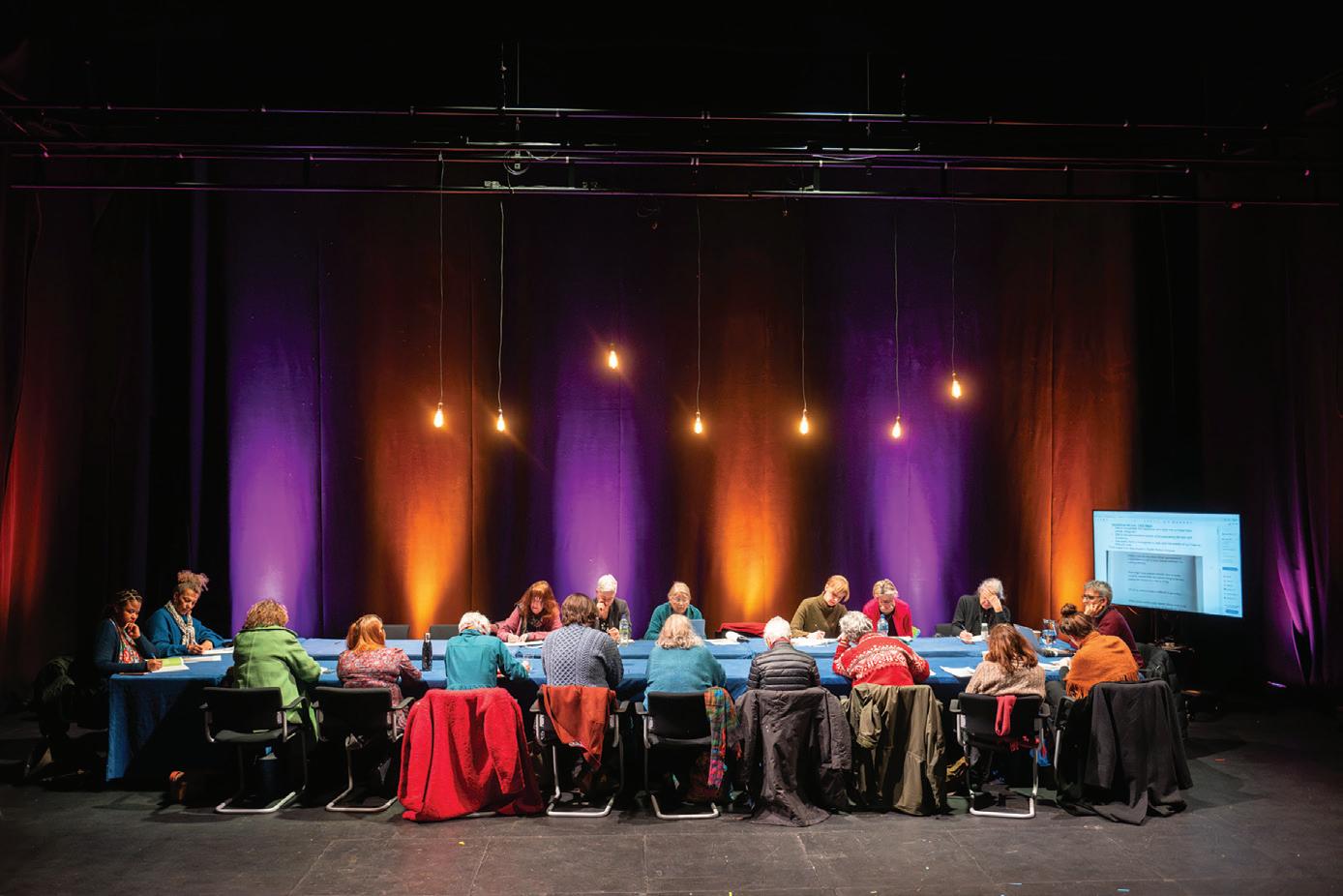
will be an exhibition in the Byre Theatre. Parliament Hall will host a poetry marketplace with exhibiting poetry presses,
magazines, and artists. The North East Fife Community Hub will also host a sharing event, where people are invited to bring
their own poems along. Wardlaw Museum will host poets responding to the latest exhibition in the museum, while the Town Hall will offer bookbinding workshops. Furthermore, various open mic events will be organised, welcoming new and emerging voices from Scotland. On Saturday night, following the ‘Stupid Sexy Poem Show’, there will be an open mic event, where students can share their work. There will be a wide online range of free and ticketed events, with special offers for students. Ryan Van Winkle, the second-time Artistic Director of the festival, has invited everyone to expect “a festival of feeling” with a program packed full of skilled authors engaging in “a range of emotions in poetry and conversation”. Van Winkle also drew light on the presence of “sensory elements” throughout the festival, stating: “We don’t just get moved by words, but also have our senses tingled by sound, touch, and scent.”
University Wins £100k Court Case Against Former Employee
IONA CARRUTH News Writer
The University of St Andrews has won its £100,000 case against former employee Dr Akali Omeni. The case focused on Dr Omeni’s four complaints: unfair constructive dismissal, direct race discrimination, harassment related to race, and discriminatory constructive dismissal.
Dr Akali Omeni is a counter-terrorism expert and was a lecturer in the School of International Relations until his resignation in March 2024. Throughout the six-day employee tribunal held at Dundee Tribunal Hearing Centre in November, Dr Omeni represented himself, seeking £58,700 due to “injury to his feelings,” £16,277 for twenty-one weeks of lost pay, and pension contributions. Tribunal judge Jennifer
McCluskey oversaw the case and stated, “We were satisfied that no racial motivation, conscious or unconscious could be inferred.”
Some of the central issues raised were Dr Omeni’s claims that he was being “tone policed”, that his mental health was not taken seriously, and that the University did not reduce his workload to be the same as his white colleagues. One of the complaints was that Dr Omeni had to teach for two semesters in his first year of teaching, instead of just one, like fellow staff members.
University lawyer Mandy Armstrong drew attention to the fact that the School of International Relations was undergoing a period of change at the time of Dr Omeni’s complaints, stating, “This is something that was being applied across the whole school. You were not being singled out.”
Ultimately, Dr Omeni’s complaints
were dismissed at the end of the hearing with the conclusion that his arguments were not well-founded. In an article published by The Courier, a University spokesperson gave the following statement:
“We welcome the outcome of the Employment Tribunal rejecting Dr Omeni’s claims against the University of discriminatory and unfair constructive dismissal, direct racial discrimination and harassment related to race.
“St Andrews is committed to advancing equality and addressing all forms of discrimination and we are pleased that the Tribunal found no case to answer.
“The case has been deeply distressing for our staff who were on the receiving end of these serious allegations, who have been fully vindicated by the verdict. We also recognise the case has been difficult
and challenging for Dr Omeni, and we wish him well in his future career.”
“We were satisfied that no racial motivation [...] could be inferred.”
According to The Courier, Dr Omeni will not be appealing the verdict. However, he stated, “As a black man, I have been told by an all-white tribunal, who supported all-white witnesses, what racism is not.”
Photo Provided by StAnza
500-Year-Old Manuscript Joins the Shelves of the University’s Rare Books Library
MORVEN BOYD News Writer
The historic St Andrews Chronicles manuscript has found its permanent home on the shelves of the University of St Andrews Rare Books Library.
The St Andrews Chronicles is a handwritten copy of History of Greater Britain by John Mair. The sixteenthcentury manuscript is a detailed history of both Scotland and England, and the accompanying hand-copied pamphlet contains new information about key figures and items in earlier Scottish history, such as William Wallace and the Stone of Destiny.
Professor Dauvit Broun — Professor of Scottish History at the University of Glasgow — described the Chronicles as “giv[ing] us access to the way people […] were thinking about the kingdom’s history.” As a hand-written document shared amongst many people, sections of text that could have been added or removed reveal the interests of its various owners and their interactions with history.
Accordingly, Professor Broun described the additional pamphlet as “a personal summary of Scottish history,” explaining that the author of the manuscript removed Mair’s version of the early history of Scotland, replaced it with the pre-existing pamphlet, and clearly “didn’t approve of Mair’s
treatment” of the period. Professor Broun also highlighted that “it is very, very rare to have a survival” of such a personal item.
Further emphasising the importance of readership of the manuscript, Elizabeth Henderson — Rare Books Librarian at the University of St Andrews — stated, “The provenance of this manuscript shows that successive sixteenth-century owners, several of whom are not currently known as book owners in any other context, valued these texts, pointing to a wider readership than was previously known.”
“It’s really important that a manuscript like this is held in a public institution like St Andrews where it can be cared for in perpetuity and also where it can be made accessible for research,” she added. “It’s a Scottish manuscript about the history of and origins of Scotland and it’s been through a succession of Scottish owners since the sixteenth century, so there’s a real resonance having it back in a Scottish institution.”
Henderson went on to describe the care taken by the University’s Rare Books Library to safely preserve such a precious document: “The basic essential care for important manuscripts like this includes secure storage, in controlled environmental conditions, with a suitable box to protect it made from conservation-grade materials.”
This is not the first time the manuscript has been connected to the University.
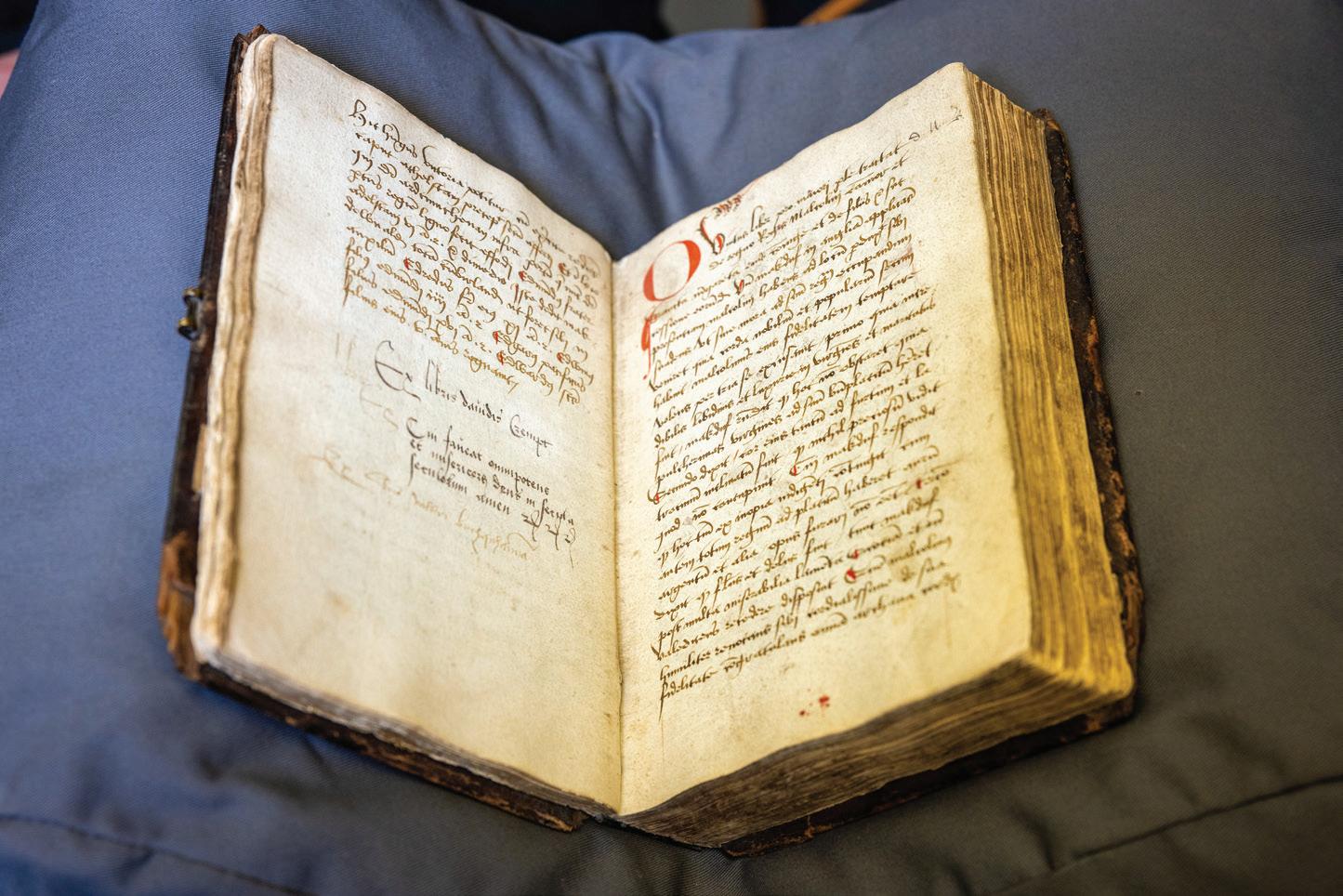
“I am absolutely delighted that the manuscript has come back to Scotland and particularly to a place with which it has real associations,” said Principal and Vice-Chancellor Dame Sally Mapstone. “John Mair taught at our University in the 1520s. The manuscript was also owned during the later sixteenth century by John Lindsay of Balcarres, a notable Fife noble and secretary of state.”
The University’s purchase of the Chronicles was generously supported by Dr William Zachs and by the Friends of
the Nations’ Libraries. The manuscript has now been digitised and is accessible to wider readership through the University Library collections website. The Chronicles itself will be displayed at the Wardlaw Museum in 2025, offering scholars, students, and the public an opportunity to learn more about Scottish and English history. The manuscript has found a permanent home in a town to which it has long been connected.
Plaque Dedicated to Allan Robertson Unveiled on Golf Place
SANDY WALLS News Writer
A commemorative plaque honouring the golfing legend Allan Robertson has been unveiled outside 22 Golf Place. Planning permissions were approved by Fife Council in late January. This project was proposed by the St Andrews Pilgrim Foundation, who have successfully campaigned for three golfing icons to be honoured in St Andrews. As well as Allan Roberston, Tom Morris and Jamie Anderson are also being memorialised with plaques outside the sites of their former residences.
The plaque reads, “Allan Robertson (18151859): Champion golfer, lived in a house on
“Innovations introduced by Robertson are still evident in [...] the golfing world today.”
this site.” Its design is inspired by the English “blue plaque scheme,” which aims to display details of significant figures to the public. This inscription is one of several monuments dedicated to Robertson around St Andrews; others include the R&A equipment testing facility named Allan Robertson House and Allan Robertson Road Drive.
Allan Roberston grew up surrounded by the sport, first working for his familyowned golf ball business. He and his father would go on to hold the title of champion golfer for a total of twenty-four years between 1830 and 1859. In the wake of Robertson’s sudden death in 1859 at the age of 43, the Open Championship was created. This tournament, which has run almost every year since 1860, is set to return to the ‘Home of Golf’ in 2027.
Moreover, Robertson’s scientific approach has lived on through his technical contributions to the game. When The Saint asked for insight from the St Andrews Golf Society on Robertson’s legacy, a spokesperson stated that “several of the innovations introduced by Robertson are still evident in St Andrews and the golfing world today.” Such innovations include the
first use of iron clubs. The spokesperson also emphasised Robertson’s reshaping of the Old Course itself, stating that he is the reason why the course has a double green which is “now one of its most recognisable features.”
The St Andrews Pilgrim Foundation is a charitable organisation which aims to “conserve, improve, and develop” the town’s heritage for public enjoyment. Many passionate volunteers help run this foundation, including golf historian Roger McStravick, who wrote the book Allan Robertson of St Andrews, the King of Clubs, 1815-1859. This biography is set to chronologise Robertson’s golfing career and return him, as the author puts it, to his “rightful place as the peerless and indisputable King of Clubs.”
On behalf of the St Andrews Pilgrim Foundation, McStravick spoke to The Saint about the cultural and historical significance of Allan Robertson. “Allan was the game’s first superstar,” he stated. Robertson was even the first professional golfer to be photographed, emphasising his claim to stardom. “He was a St Andrean through and through,” McStravick noted, “and we, in St Andrews (and golf), are all the richer for it.”
Indeed, Robertson’s legacy also lives on in his golfing mentee Tom Morris, colloquially known as ‘Old Tom Morris’ and ‘the Grand Old Man of Golf’. In October 2024, a bronze statue of his likeness, designed by Scottish sculptor David Annand, was ceremonially revealed on The Scores. While the statue has immortalised this proclaimed hero of the sport, it has been repeatedly vandalised since its erection: first in November 2024, and again in February. Both incidents led to the detachment of the statue’s accompanying golf club. McStravick is leading efforts to restore the sculpture and prevent further damages through a GoFundMe page. In an X post from 5 February, McStravick shared a link to this fundraiser and vowed to match each donation made in the first 48 hours. McStravick wrote that “with the club head stolen, this is going to be an expensive fix,” as the piece will need to be recast. He also proposed affixing the club to the statue’s coat to safeguard it from future attacks. It is clear that the continued honouring of local figures remains a relevant and important issue in St Andrews, and this new plaque signifies the continuation of such traditions.
Photo by the University of St Andrews
InFocus Professor Andrew Brierley: The Man Whose Name is Etched in Antarctic Ice
CELESTE CHAVE News Writer
At coordinates -45.407989; -60.661392, on the southern coast of Coronation Island in Antarctica’s South Orkney archipelago, lies a bay that now bears the name of a distinguished scientist. Brierley Bay, recently renamed in honour of the late Professor Andrew Brierley of the University of St Andrews, stands as a tribute to his remarkable contributions to marine science. This decision, made by the UK Antarctic Place-Names Committee as part of the British Antarctic Territory organisation, recognises Brierley’s exceptional impact on Antarctic research and his enduring legacy in the field of marine ecology.
“For such an honour, individuals must have made exceptional contributions.”
As Antarctica has no indigenous populations to name landmarks, geographical features in Antarctica are named according to international principles and procedures. Elena Field, a Geographic Information System and Web Mapping Specialist at the British Antarctic Survey, underscores the importance of naming for navigation, safety, and scientific communication. “It allows for a feature to be unambiguously identified,” she explains. Official names ensure that locations are consistently referenced in research, operational documents, and conservation policies. This also permits better operational safety and environmental protection of the designated area.
To be considered for such an honour, individuals must have made exceptional contributions to Antarctic science, governance, or exploration. Brierley’s colleagues at the British Antarctic Survey — Professor Geraint Tarling, Dr Sally Thorpe, and Dr Nadine Johnston — submitted the proposal, recognising his profound influence on Southern Ocean ecosystem science. Born in Rugby, England, in 1967, Andrew Stuart Brierley demonstrated an early passion for marine biology. As a dedicated student, he earned his undergraduate degree from Bangor University in 1987 before pursuing a PhD in squid genetics at the University of Liverpool’s Port Erin
Marine Laboratory on the Isle of Man. His early research focused on the population genetics of squid species in the Atlantic and Southern Oceans, laying the foundation for his future work in marine ecology.
Despite suffering from asthma and being advised against diving, Brierley was undeterred. Driven by his insatiable curiosity and determination, he logged over 1,000 dives, exploring underwater ecosystems and co-authoring a local dive guide for the Calf of Man. He also played a role in salvaging parts from the wreck of the Dom Bosco fishing vessel, a vessel that began taking on water and sank due to poor weather conditions, further showcasing his adventurous spirit.
Brierley’s career took him to South America for fisheries surveys before he joined the British Antarctic Survey in Cambridge in 1995. His research focused on krill, a keystone species in the Southern Ocean’s ecosystem. This interest led to his pioneering work in fisheries acoustics, using sound waves to study marine life distributions.
the first to demonstrate the critical role of sea ice in the life cycle of Antarctic krill.
In 2001, Brierley joined the University of St Andrews as a lecturer in the School of Biology. He quickly established himself as a dynamic researcher and mentor, inspiring students and colleagues alike. His work extended beyond polar ecosystems, as he also explored marine acoustics in tropical waters, from Palau to Diego Garcia, and investigated the search behavior of marine predators.
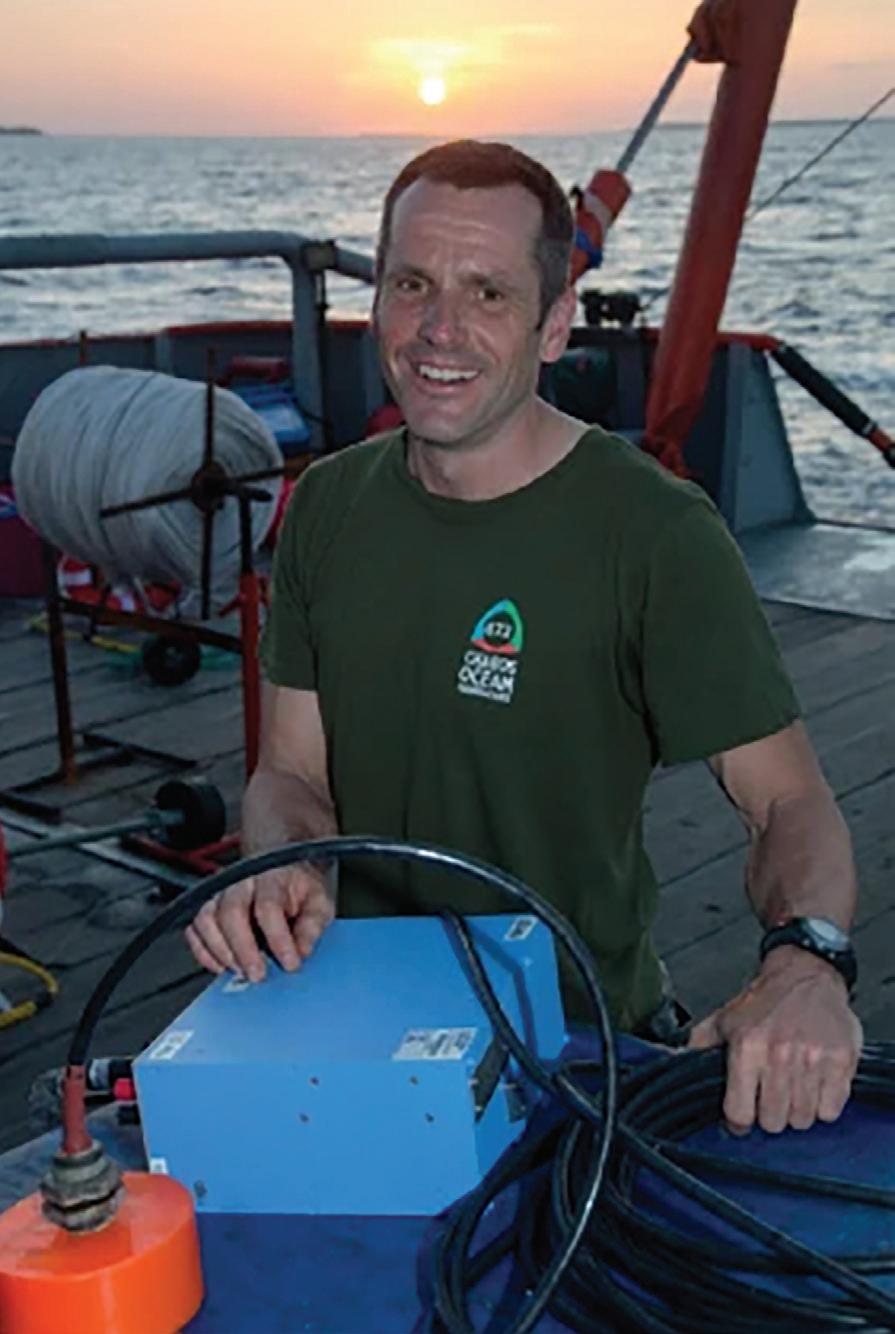
In 1990, alongside his longtime colleague Paul Fernandes, Brierley secured funding to launch the world’s first Autonomous Underwater Vehicle (AUV) in the Southern Ocean. Initially deployed in the North Sea to study how fish evade ships, the AUV was later sent beneath the ice of the Southern Ocean. This groundbreaking mission uncovered dense bands of krill thriving several kilometres beneath the sea ice, suggesting that these hidden depths provide a refuge from marine predators. Their findings, published in the peer-reviewed journal Science, were
In 2008, he was promoted to full-time professor. He led the Pelagic Ecology Research Group at the Scottish Oceans Institute and was elected as a Fellow of the Royal Geographical Society in recognition of his research in the Galápagos. His academic output was prolific — Google Scholar lists over 200 articles to his name, accumulating more than 11,500 citations. He also played an active role in international environmental debates, publishing letters in the science journal Nature which criticised Japanese whaling activities that the country attributed to scientific research.
Beyond his fieldwork, Brierley co-founded the Scientific Committee on Antarctic Research Krill Expert Group in 2017, fostering collaboration between scientists and policymakers at the Commission for the Conservation of Antarctic Marine Living Resources. His work directly influenced conservation efforts aimed at protecting krill populations, which form the foundation of the Antarctic food web. In 2021, he was appointed Director of Research for the University’s School of Biology, reflecting his growing influence in marine science.
While Brierley was deeply committed to science, he was also a devoted father, an
endurance sports enthusiast, and a close friend to many. He was a triathlete and Ironman competitor, qualifying for and competing in five of Hawaii’s annual Ironman World Championships. He achieved a marathon personal best of two hours and 42 minutes in Florence. His adventurous side also saw him engage in deep-water diving, paragliding, skiing, hiking, and mountaineering. When an injury prevented him from competing on a standard bike, he took up the unusual sport of stand-up biking (ElliptiGO), competing at the 2022 World Championships where he placed eighth.
“The renaming of this Antarctic bay ensures that Brierley’s name will live on.”
His colleague and friend Paul Fernandes remembers him as “an entertaining, goodhumored friend to me and many.” His sudden passing in February 2023 was a profound loss to the scientific community, but his influence endures. “Andy would have been flabbergasted by the news but deeply honoured that there is a place in the world named after him,” said Kirsti Sharratt, Professor Brierley’s partner.
Brierley Bay not only commemorates a scientist whose work reshaped our understanding of Antarctic ecosystems but also symbolises the importance of continued research in a rapidly changing environment. With climate change driving unprecedented shifts in Antarctica — with melting ice, expanding vegetation, and record-breaking heat waves — such scientific exploration offers insights into the implications of such transformations, as well as providing potential strategies for their mitigation.
The renaming of this Antarctic bay ensures that Brierley’s name will live on, forever linked to the icy waters he dedicated his life to studying, while also cementing the legacy of the University of St Andrews in Antarctic research. His contributions will continue to inspire future generations of marine scientists, consolidating the University’s impact on marine science and its place in history.
Photo by Kip Evans
Viewpoint
SUNAA AHMED
Viewpoint Writer

EDITOR: GEORGES TOULOUSE
Swiping Left to ‘I Do’ Is the silver wedding anniversary a dying breed?
As I write this article, my parents sit handin-hand, speeding across the English countryside courtesy of LNER Azuma, on their way to celebrate a relationship milestone. This week, they will have been married for 25 years. When I pause to think about it, the number is immense. They have been together three years longer than I have walked the planet, seen the rise and fall of seven Prime Ministers, the birth of almost fifteen royal babies, and the spectacle of half a dozen Olympic games.
This milestone is not unique to them. When I informed my friends of the upcoming anniversary, I found most of their parents had beaten mine to it. The majority had been Mr and Mrs for upwards of 30 years, a number I found astonishing when compared to my own limited experience in the world of dating. As I tried to imagine myself in the same position, zooming across the Midlands with my own partner on whatever futuristic contraption British Transport may dream up in the next 30 years, I drew a blank. Having grown up in a world where trends and technologies change with the seasons, is a life shared with one person even a possibility for our generation?
Marriage has been subject to immense change since the rise of feminism in the 1960s. As women’s attitudes to their personal freedom and economic independence evolved, so did their views on relationships. This change is reflected in the figures. Marriage rates in the UK have been in steady decline from the ’60s onwards, and in the past 30 years alone have dropped by over twenty per cent. Conversely, divorce rates are on the rise. We have all heard the somewhat crushing statement that one in two marriages end in divorce, perhaps we have even bitterly uttered it to ourselves when passing a particular smug couple in the run-up to Valentine’s Day. The figure is actually a little less than half, standing at 42 per cent. Yet what the numbers show is that marriage has been an endangered species long before the 21st Century, its environment changing by the continual decline of long-held societal values and traditions. Yet arguably never have societal values stood in such stark opposition to long-
term relationships as they do now. For Gen Z, the first generation to grow up with advanced, ever-changing technology at their fingertips, long-term commitments of any kind arguably prove challenging. One only has to look at the flickering trends, the TikTok videos, and ten-second Snapchats to see how fast-paced life is for our generation. To be interesting is to be
multiple people, sometimes at the same time, has been largely acceptable in most parts of the Western world for some time, the sense of distance that arises from dating through a screen is entirely new. If falling in love is as simple as swiping left and right, isn’t falling out of love just as easy?

punchy, flashing into our consciousness for one Mayfly-like day of glory before being blasted out by the next big thing.
The pattern is one reflected in our attitudes to dating. Take Tinder for example, which turns dating into a kind of Subway-Surfers-esque game, more a form of entertainment than any kind of meaningful social interaction. Players may swipe through dozens, if not hundreds of hopeful candidates in one sitting, chatting to any number of them, and in turn being one in a list of many. This form of dating, the norm for many in my generation, simply did not exist in the time of our parents and grandparents. Though dating many and
Yet it is not only our alarmingly short attention spans that have altered Gen Z’s attitude to relationships. In many ways, increasingly positive changes in both lifestyle and mindset have made a silver wedding anniversary unlikely for any of us. For one thing, we are a remarkably introspective group, with more members of Gen Z attending therapy than that of any other generation. We read self-help books, practice mindfulness and meditation, binge podcasts that encourage us to understand the more difficult parts of ourselves. As a generation that values self-love and improvement more than any other, it follows that we are likely to have higher standards when it comes to relationships. Where our parents and grandparents
may have swept conflicts and differences under the rug, we are more than happy to confront them head-on, and unafraid to walk away should we deem the strain on ourselves far too great. Emma Watson, though her phrasing is somewhat ridiculous, recently declared she is ‘married to herself’, and she is one in a long line of celebrities putting her relationship to Number One before any other. In many ways, any person prioritising their own self-fulfilment over pressures to enter in a relationship should be celebrated. Yet I also think it fair to say that this mindset may be something that holds our generation back. The ups and downs of a relationship can be a unique way of getting to know ourselves, bringing out qualities we did not know we possessed until called on by another person.
That is not to say we are a generation incapable of showing empathy and loyalty to others. In many ways, we have found fulfilment in places our parents and grandparents could not, and that in itself deserves recognition. We throw ourselves into careers, making hobbies and politics our passions, and giving to others through the personal sacrifices these commitments take. Not to mention the love we feel for teachers, siblings, and friends, whose time we can enjoy more without the distraction of a serious relationship. Where our parents may have lived with partners or spouses in their twenties, we live with flatmates our own age, old friends from home and uni, or new ones we meet as we go into the working world.
One only has to open Dolly Alderton’s 21st Century bible Everything I Know About Love to see the truth of this. Though she and her girlfriends go through dozens of partners throughout the memoir, they remain constant and loyal to each other. This love, not the love of a partner, is what she feels has been a lifeline during the turbulent, at times difficult years of her 20s. Yet at the same time, I believe we would be foolish to spurn whatever romantic opportunities may come our way, often when we least expect them. It seems likely that there will be fewer in our generation on the same journey as the one my parents embarked on 25 years ago, but don’t let this stop you from buying your ticket.
Illustration by Janya Malkani
MISTRAL ZERBI
Gone are the days for hopeless romantics. With high divorce rates, the option of ‘casual’ relationships, fear of commitment, and an acute, constant awareness of the world’s cruelty, it seems almost delusional to believe in love — doesn’t it?
And yet, we still do. We still long to love and be loved, unapologetically. When I asked myself whether love was “worth the hassle”, I couldn’t help but question what this “hassle” exactly was. I mean, sure, no romance is free of problems, compromises, adaptations, and arguments, but when does it become a “hassle”, really? If we think of it rationally, many might argue that love is not something we choose, it’s something that we are biologically drawn into, so whether it is worth it or not we will still long for it. I disagree. It would be reductive to say that we simply love because we have to. We don’t simply need love, nor do we just want love; we love to love.
We love knowing that we are a little more special to someone out there. We love quality time and special dates — some of us even enjoy the thrill of an argument (yours truly included, sue me ). Certainly, no reward comes without hassle. Otherwise, we would also rationally conclude that it is simply not worth it to build a career, to have children, or even to build friendships. Good things always come from effort.
Yet when we evaluate whether something is “worth the hassle”, we tend to weigh its hardships and see if they are balanced out by its pleasures. But it simply isn’t that easy. Many approach love as this grand ideal, a finish line that, once crossed, guarantees happiness in return for our effort. The cynical think that we are all inherently messed up, so why put effort into something that will likely never really work? Well, because love is less of a transaction and more of an ongoing act of faith. Can we be certain that we won’t get cheated on after offering years
Devil’s Advocate Is love worth the hassle?
of loyalty and affection? No, we never are. It’s uncertain, as any act of faith is.
Kerouac said that “life’s all about the journey”. It demands daily constructive effort, and as a part of that effort, the outweigh the struggle on Cupid’s balance. There is no currency more valuable to humans than love, no force more transformative, and that might be what makes it worth the hassle. And if your balance sheet says the opposite, maybe it’s not love itself, it might just be the wrong person. As cheesy as this sounds, in the end, all we have is each other.
Love is a logistical nightmare. Yet, for some reason, we keep signing up. Why? Because biologically, we’re wired for it. Love isn’t a conscious choice; it’s an evolutionary trap. If we were Vulcans — an extraterrestrial humanoid species dedicated to pure logic — we wouldn’t even be having this discussion. But since we’re humans, cursed with emotions and a misguided belief in soulmates, we continue to willingly dive into the hassle that is love. If we take emotion out of the equation, love quickly starts to look less like a fairytale experience and more like a catastrophic lapse in judgment. Relationships are essentially long-term contracts requiring you to tolerate another person’s quirks, bodily functions, and irritatingly loud chewing — sometimes for decades. And for what?
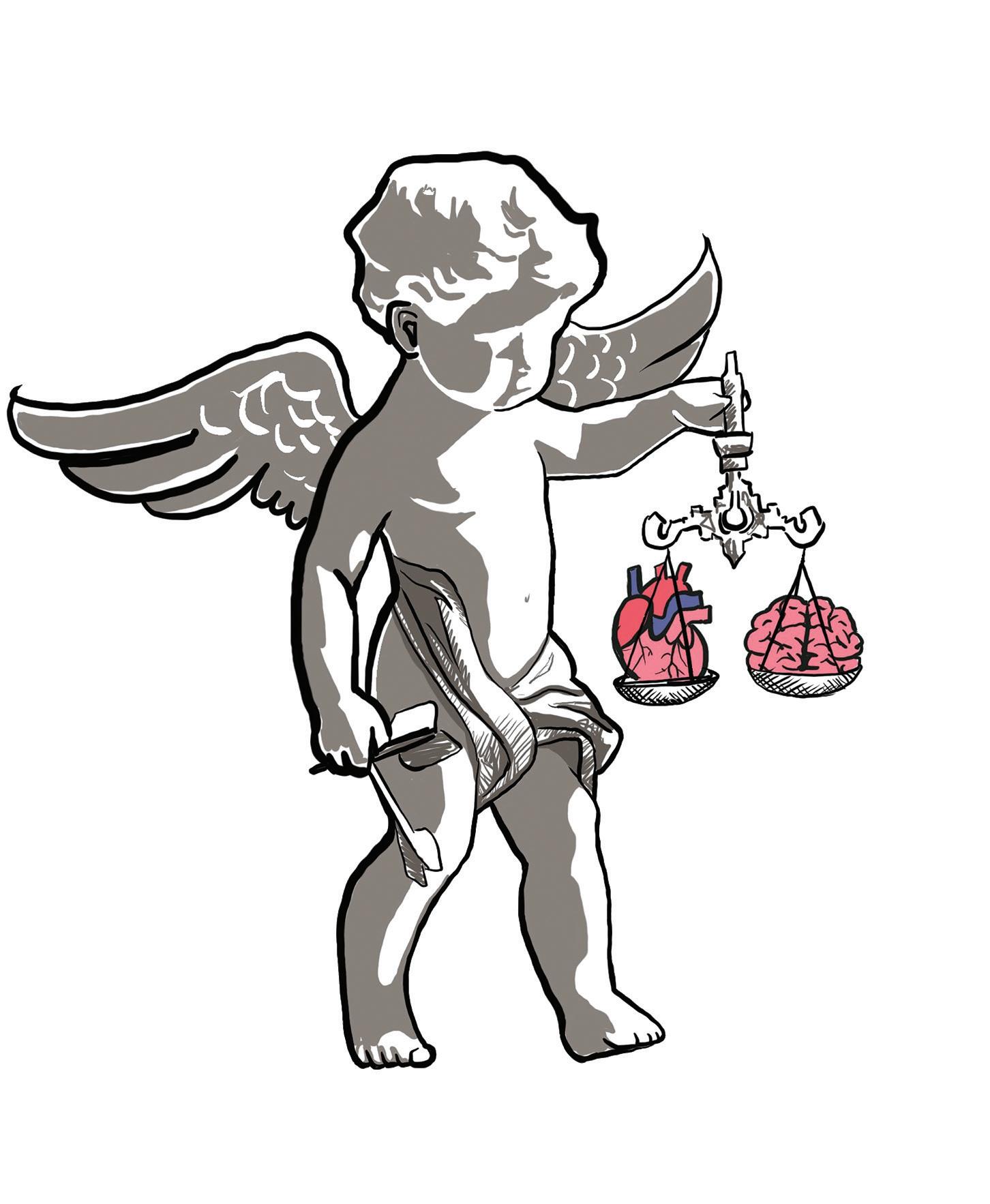
Some fleeting dopamine hits? The temporary validation that comes with feeling truly seen by another person? A brief escape from the chains of our deepseated fear of loneliness and the existential dread that accompanies it? These reasons seem enough to us in the moment because love is built on denial — denial that everything, including love itself, is transient. At its core, love is often just a neatly wrapped distraction from the crushing weight of our own existence. It’s the ultimate coping mechanism: a socially sanctioned way to momentarily silence the gnawing fear that, without a romantic partner, we might have to actually sit with our thoughts and confront our own finiteness. If you buy into the arcane practice of marriage, odds are it’ll fall apart. Even if you make it to “’til death do us part,”
there’s no guarantee that your long-term relationship won’t turn into a joyless cohabitation arrangement fuelled by mutual responsibilities, resentment, and painfully silent dinners. Even among those who stay together, research shows that relationship satisfaction declines over time. The passionate love that initially makes us overlook our partner’s annoying habits typically fades within 12 to 18 months, after which reality sets in, and we’re left navigating the mundane logistics of another person’s laundry habits. Think about all the energy love demands. Texting, planning dates, remembering anniversaries, dealing with in-laws — it’s exhausting. And shockingly costly! A 2023 study found that the average person in the UK spends £2,000 per year on dating. That’s before you factor in couples therapy, or the inevitable cost of dividing your possessions after a painful breakup. If someone suggested any other activity that required this much money, effort, and emotional turmoil, you’d laugh them out of the room. Yet somehow, love gets a free pass.
Love is just liking someone beyond rational self-interest. It’s deciding, against all logic, that you are willing to sacrifice time, money, and emotional stability for another human being. Love is, in essence, emotional gambling — you bet everything on a single person, hoping they don’t change (they will), leave (they might), or become increasingly grumpy after years of working a soul-sucking corporate job (inevitable).
The real kicker is that, despite all of this, we will pursue love anyway. Whether it’s nature, societal conditioning, or a collective lapse in judgment, humans are incapable of learning from experience when it comes to love. You can have a catastrophic breakup, swear off romance forever, and yet, six months later, find yourself downloading Hinge like a moth drawn to a particularly disastrous flame.
So happy Valentine’s Day! May your roses be red, your chocolates overpriced, and your existential dread temporarily forgotten. Illustration by Holly Ward
Tesla, Tes-Huh?
Why you should be embarassed to drive a Tesla
LEWIS MACKINLAY Viewpoint Writer
Ten years ago, the sight of a Tesla on UK roads turned heads — definitely not for its aesthetics (obviously), but because it represented the future of clean energy and innovation. A Tesla wasn’t just a car; it was a symbol of ecological progress, a promise of a greener tomorrow — kind of like the Prius’s cooler, tech-savvy cousin. Today, however, the same vehicle stirs up mixed feelings — once a symbol of progress, now tangled in political controversy.
At first, owning a Tesla was more than a practical choice; it was a statement of commitment to reducing carbon emissions and embracing technology’s role in solving the climate crisis. Early adopters were a proud alliance of eco-warriors and tech nerds, zipping around smugly on clean energy. But lately, that symbolism has done a full U-turn. Not because people suddenly miss petrol stations or oil changes, but because driving one now feels less like a statement about sustainability and more like an unsolicited subscription to the Elon Musk fan club. What was once a symbol of progress now comes with an unspoken disclaimer for the embarrassed masses: “I bought the car, not the Twitter rants.”
Musk was once celebrated as a pioneer — a man who disrupted industries and tackled humanity’s biggest challenges, from renewable energy to space exploration. Tesla’s mission, to “accelerate the world’s transition to sustainable energy,” once felt genuine under his leadership. But as Musk’s public behaviour became more erratic, so too did the brand’s reputation. Once a champion of green technology, he has increasingly aligned himself with figures and rhetoric that contradict those ideals.
raising an eyebrow. When you add Musk’s cosy chats with climate deniers and his love for stirring up culture wars on X, it’s hard to ignore how his actions have tarnished Tesla’s once-pristine image as a green, progressive leader in a market that’s anything but conservative.
Serial Griever
by Natasha Currie
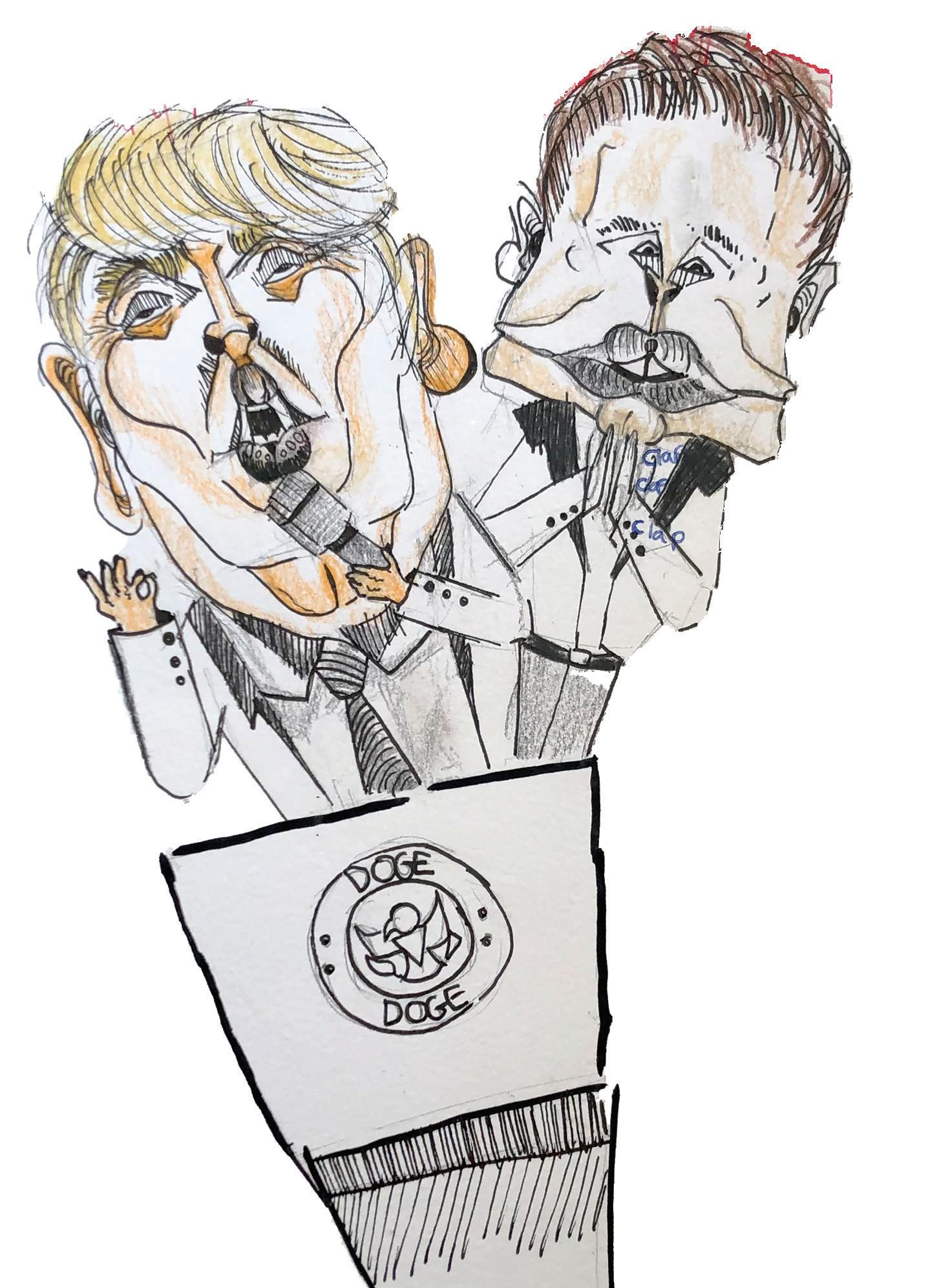
During Donald Trump’s second inauguration last month, when the 47th president once again blurted “Drill, baby, drill!,” Musk’s enthusiastic applause — and later, his own speech, which included a questionable arm gesture — did little to ease the concerns of those already
The numbers reflect this shift. has declined
by global units sold from 21 per cent in 2021 to 18 per cent in 2024, as legacy automakers like Ford, GM, and Volkswagen ramp up their production. Even newcomers like Rivian and Lucid Motors are chipping away at Tesla’s share, finding custom with environmentally conscious consumers who now find Tesla too polarising.
While increased market competition plays a role, consumer surveys suggest Tesla’s decline isn’t just about more options. A Morning Consult report
found Tesla’s net favourability among Democrats dropped by over twenty per cent between October and November 2022 — coinciding with Musk’s acquisition of X and his endorsements of GOP candidates in the Midterms. Meanwhile, 60 per cent of respondents in a recent Electrifying.com survey said Musk’s reputation would deter them from buying a Tesla, with 56 per cent now open to purchasing a Chinese-branded EV.
For many, it is no longer about sustainable energy but about Musk’s personality — his alignment with alarming rhetoric, his provocative social media outbursts, and his apparent disdain for the environmental ethos that once defined his brand. This shift in perception underscores a broader trend: the politicisation of consumer choices. If Tesla hopes to become a less questionable choice for those looking to make the EV switch, it needs to break free from the controversies surrounding its CEO, and his blend of hypocritical and just plain bad politics. The world doesn’t just need electric cars, it needs trust in the companies that make them. Right now, Tesla’s competitors are cleverly positioning themselves as apolitical alternatives — green vehicles for a cleaner future, minus the baggage of ideological warfare.
“The world doesn’t just need electric cars, it needs to trust the companies that make them.”
The decline of Tesla as a symbol of hope serves as a cautionary tale. It is a chilling reminder applicable to much of the innovation we see today — whether it be artificial intelligence or healthcare breakthroughs — that progress isn’t just about technology; it is about the intent and values that drive innovation forward. As for me, Mr. Musk, I think it’s time to ditch your electric dream — maybe I’ll go for a gas-guzzler, or better yet, a Nissan Leaf.
Illustration by Amaris Adekola
Over the break, I took advantage of time away from a hectic university schedule to reflect on the past semester. As I am sure you know, time runs away from us in St Andrews — before you know it you’ve spent a whole month bouncing between library, lecture, Aikman’s, and bed. I often find that I don’t have the space to think about my experiences until the dust settles. In this flux, I began thinking about Serial Griever and what I had intended for it to become. Many of its goals, collaboration and open honest grief chat, have been met, but one thing I haven’t yet spoken of are the tangible support resources that have shaped my St Andrews routine. Last week I returned to the Maggie’s Centre in Dundee for the first time in months. If you haven’t heard of this little safe haven, it sits at Ninewells Hospital and functions as a ‘home away from home’ for those undergoing cancer treatment and their families. There’s a kitchen, kettle, copious teabags, bookshelves, couches, and gardens. Maggie’s takes great pride in its buildings and landscaping, seeking to push art and safety into every corner. Co-founder Charles Jencks believed in and wrote about ‘The Architecture of Hope,’ publishing three editions in his lifetime. The Dundee Centre was designed by architect Frank Gehry, whose work includes the Foundation Louis Vuitton and Guggenheim Museum Bilbao. His Dundonian design follows his typical deconstructivist style, while embedding inspiration from traditional Scottish butt-n’-bend housing. On the Maggie’s website, Gehry explains his personal ambition behind the design: “I really hope that in some small way it might contribute to a sense of rejuvenated vigour for moving forward and living life.”
Driving up the hill, the white curved walls and zigzag roof emerge, and a sense of calm washes over me. I feel just that bit safer. I have visited once every month for the last two years to speak with the resident counsellor; a quiet pilgrimage, whose place in my heart and head, I realise only as I near the end of my time in St Andrews. Maggie’s has supported my entire family, especially my mother, through so many stages of a cancer journey and continues to do so with no fixed end date. This is what I think that Maggie’s does best. From first contact, you are always welcome. Someone will always pop the kettle on, and there will always be a space for you.
To find out more, visit their website, www.maggies.org
The opinions expressed in this publication are those of the authors. They do not purport to reflect the opinions or views of The Saint.
Mirror Mirror on the Wall
I am my mother after all
STELLA PAK-GUENETTE Viewpoint Writer
My mother’s trademark has always been her comically large, completely face-consuming glasses. Over the years, I’ve watched her collect various pairs in every colour and shape imaginable and yet somehow, they just keep getting bigger. This winter break, needing a new prescription, I instinctively chose an equally oversized, way-too-big-for-my-face pair. When I tried them on, I immediately thought: I look just like my mother. The truth is, we all grow up thinking we’ll never become our parents. We admire them without a doubt and how they seamlessly balance their careers, family and personal lives with such ease. But still, we insist that we’re different; we become absolutely convinced that we’ll carve identities separate from theirs. In reality, doing so without their influence or subtle infiltration is more of an impossibility than we think. In the smallest ways — a habit, a phrase, or a preference — and before we know it, we catch glimpses of them in ourselves. Maybe it’s inevitable. We spend years watching them, absorbing their quirks and their preferences. Even as we try to assert our identities, they remain ingrained
in us, shaping the way we move through the world. Whether this was consistently bringing a scarf on the plane to use as a makeshift blanket or always taking the small sewing kits from hotels (never to use them), I’ve come to embrace these echoes of my mother rather than resist them. It made me realize that no matter how much I try to define my growing independence, my upbringing will always shape me. And maybe that’s not such a bad thing. Perhaps, in moments of uncertainty, new places or responsibilities, we reach for those familiar traits without even realising it. I think there’s a certain comfort in the sense of familiarity they bring. Beginning university this year came with an expected wealth of change. In the midst of it all, while trying to find my way around this new life, I found myself clinging to routine comforts. How I boil water for tea only to forget about it, how I instinctively tuck a pack of tissues into every bag, just as she always told me to, or how I can’t use my phone without stopping walking—these aren’t grand gestures or conscious choices, but they have a way of making me feel more settled than I expected. It’s not just my mother, either.
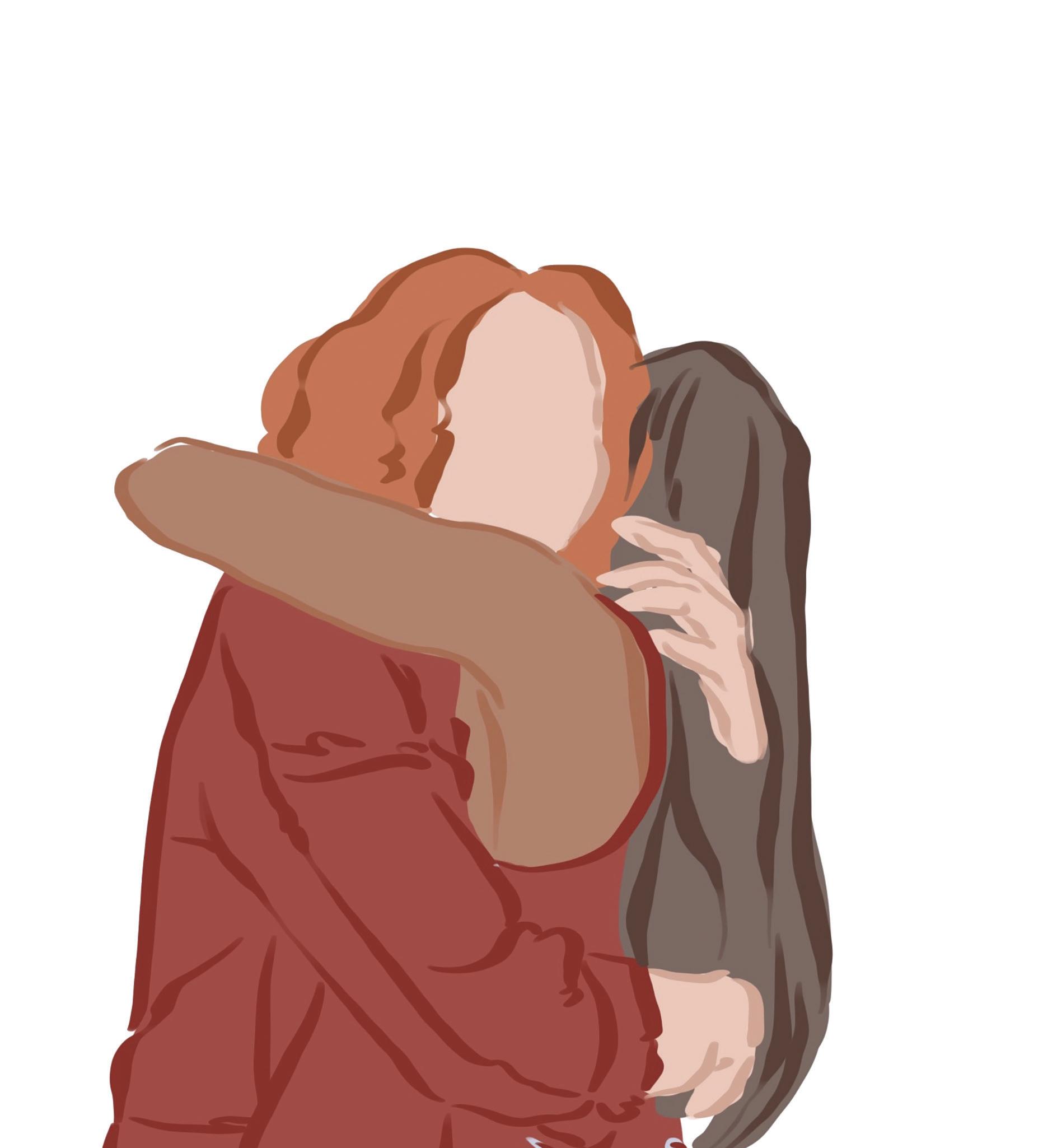
My father’s mannerisms and sensibilities personal. It’s in the smaller things I’ve picked up too, like how he always has the Steve Miller Band playing while he drives — nowadays if you’re getting in my car, you’d better be okay with listening to the whole ‘Fly Like an Eagle’ album. At some point, the resistance to becoming our parents fades. I’ve recently found that this resistance is replaced by an understanding that their influence isn’t something to resist. If anything, it’s something to appreciate. I used to think that growing up meant defining myself in contrast to them; now, I think it’s more about taking the best parts of them and making them my own.
My mom always reminds me:
“You are who you hang out with,” and I think this holds true: we become the best version of ourselves when we’re shaped by the people we love. Maybe my new oversized glasses aren’t just a style choice; maybe they’re a subconscious embrace of the parts of my mother that have always been and will continue to be present in me. Ultimately, I’m convinced that there are a few certainties in life: taxes, death, and turning into your mother.
Penny for Your Thoughts
On selling genius
SAM SPENDLOVE Viewpoint Writer
When I was younger, I was famous for buying myself into hobbies I’d never actually engage in. I’d wake up one morning and decide that I wanted to throw clay pottery and, instead of seeking out some economically salient way of dipping my toes in the water, I’d start researching pottery wheels to buy. It wasn’t that I wanted to put the time or effort into earning the label of potter — I wanted to mail-order a new, more interesting personality; to rephrase: I was a budding little capitalist. When it came to purchases, the cart never failed to come before the horse. I sought to curate a new life, a new me, by overnighting it to my address. Say goodbye, boring Sam — you just got outbid. I’ve since grown out of that. But nowhere has it survived more thoroughly than in the world of luxury stationery, particularly the notebooks. They first appeared on my Instagram reels: glamorous young people with trendy trench coats and cashmere cardigans, flipping through their luxury
traveller’s notebooks and explaining its importance to their lives. Their own words were elegantly scrawled on the £200 pages, highlighted and underlined to suggest a kind of profundity that only oldtimey writers can convincingly wear. They had tabbed some pages, just to hammer home that this was a working person’s companion — just to dispel any doubt that they secretly ran a Google Calendar. What did they actually write? Who knows! Not a single one ever explained what warranted the price tag, not a single one revealed how thought-filled someone actually had to be to warrant a £200 notebook. It was all ambiguous monologues referencing gratitude lists and intentional journal entries and mind-maps — points to be remembered for their small businesses, entries to be tastefully edited with the messiness of a mind so productive it must spill out onto a page.
It’s all too familiar to me: these expensive notebooks feel like, once again, putting the consumerist horse before the cart. If you’re feeling anxious about your shortened attention span, or the sheer lack of interesting things to
be documented over the monotonous course of a modern life, you can buy a fancy notebook. You can buy, as depicted, all those profound blocks of script and sloppily (yet tastefully, stylishly) highlighted points, and what’s more they’ll have come from you. Yes, you can be that person — that hyper-organised genius just waiting to be empowered by £200 worth of paper and leather, with custom charms dangling off of its spine.
The stationery industry has trended toward appealing to this kind of luxury, probably because nowadays very few people do anything without the promise of some sort of glamour that can help them escape the cyber-boredom of modernity. Writing something down on the cold, cruel pages of a Tesco-brand, spiral-bound notebook is not profound-thoughts-core — except, it totally is.
Joan Didion’s notebooks, for example, which were auctioned off in 2022, all seemed to be products you could buy for next to nothing at Ryman’s. She didn’t need an expensive notebook, the paper was just a sounding board for the commodity we’re all really trying to buy: that intellectual profundity, that
seemingly inaccessible clarity of mind that a stack of vegan post-it notes or an extortionate notebook seems to promise is possible.
The consumerist lie here is that talent is, first and foremost, to be purchased. This is so untrue it’s counterintuitive. Ballerinas, for example, break in their pointe shoes by unstitching them, restitching them, whacking them against the walls, snapping their soles, and beating them to a pulp. When it comes to their genius, it’s not the equipment that transforms you into somebody new, it’s the work you do with it. Cheap stationery is the aspiring writer’s pointe shoe; to learn the rhythmic, beautiful glamour of the written word, you have to have equipment you’re comfortable breaking in. The luxury stationery industrial complex hopes you won’t realise this, so they can continue to sell you the promise of instant genius-ification, when in reality the long road to knowing what to write down is paved with unglamorous, cheap notebooks. I just wish someone had told young me about this. I could’ve saved a lot of relatives’ Christmas money.
The opinions expressed in this publication are those of the authors. They do not purport to reflect the opinions or views of The Saint.
Illustration by Sarah Knight
Do the Dead Have Rights?
TRUMAN CUNNINGHAM
Viewpoint Writer
It is generally uncontroversial to say that the dead and the places they are laid to rest — cemeteries, tombs, mausolea, etc — are deserving of our respect, even when those dead are separated from us by thousands of years of history. This is almost universally recognised across cultures, even in our secular age; the idea of paving over a churchyard would make even the most stonehearted materialist wince. As European museums reckon with the repatriations of foreign bones, and AI insensitively resurrects celebrities like Tupac, might we say that the dead have rights?
Certainly, International Humanitarian Law recognises some obligations governments owe to deceased persons. According to Article 17 of the Geneva Convention, the dead should be “honourably interred, if possible according to the rites of the religion to which they belonged.” Their peace is to be disturbed only for reasons of medical investigation or to establish identity. Furthermore, gravesites must be marked and listed on a government database, in order to avoid accidental exhumation in the future.
International law makes these provisions largely for war dead, however, and for gravesites of which we already have a
written record. What about archaeological remains? Paradoxically, the only way of finding the religious beliefs of ancient
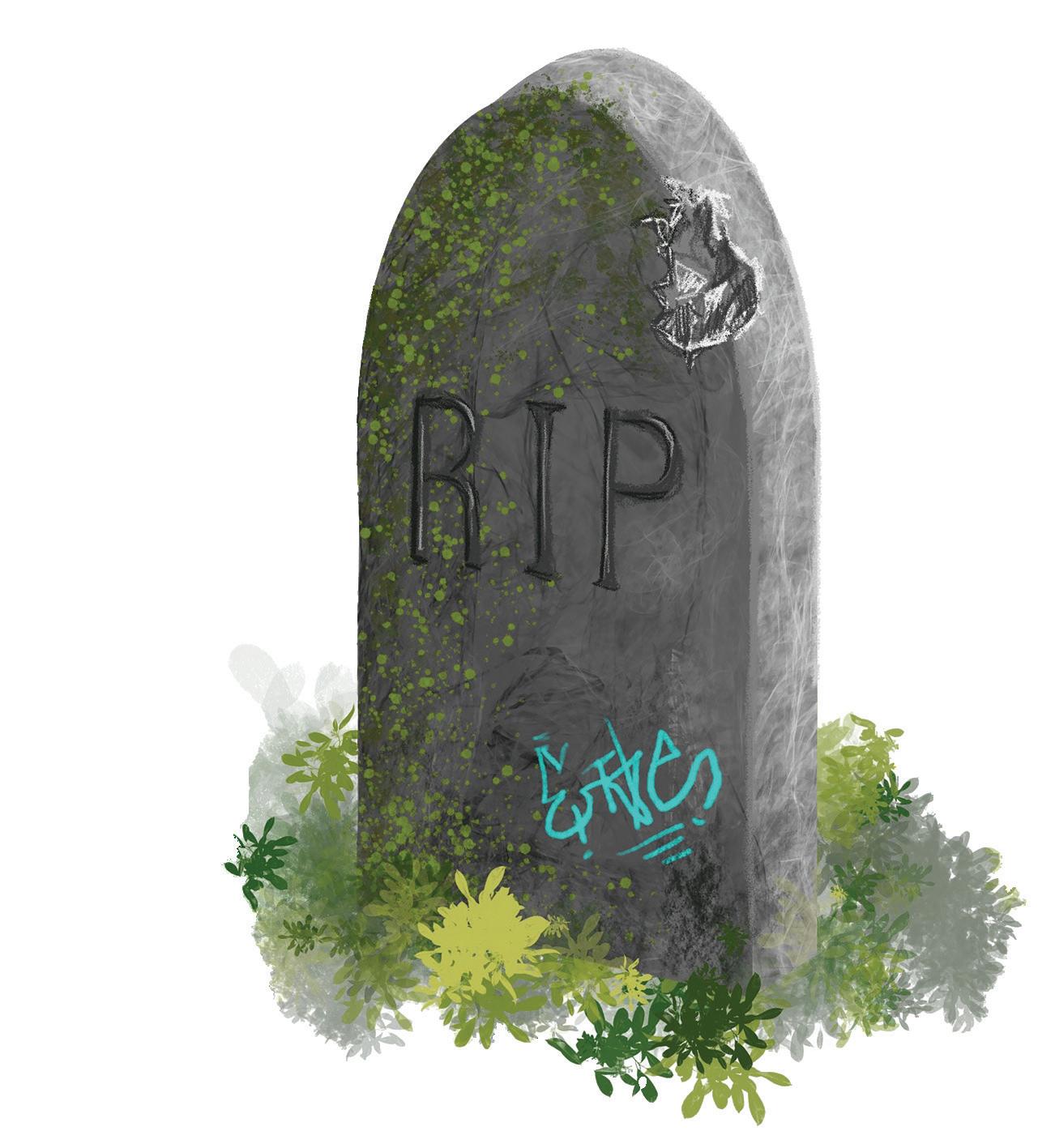
repatriation of ancient human remains: see for example, the passport issued by the Egyptian government to the pharaoh
Ramses II, almost 3,000 years after his death, in order to go on exhibit in France. Ancient human remains, however, might have a stronger claim to be returned to their native countries than other museum pieces. People, after all, have stronger feelings about where they are buried than inanimate artefacts. I have no doubt old Ramses would prefer the Nile to the Seine. We might reasonably agree with humanitarian law that the dead have some right to an undisturbed afterlife, in the general location of their burial, and according to their wishes (as far as we understand them).
More recent cases demonstrate the need to accord the dead some right to their image as well. The use of holograms and AI voice models to ‘resurrect’ deceased musicians like Elvis and Tupac, even when sanctioned by their
descendants, has brought condemnation by ethicists and even lawsuits in the United States. Unlike their art, which can be bought and sold separately to their person, an artist’s image is unalienable, central to their person in life and their memory in death. Some commentators have referred to this AI resurrection as a kind of slavery: a third party profiting from the person themselves (or some fundamental part of them, their image) without their consent. With the possible exception of Jeremy Bentham, who wanted his taxidermied body to be permanently displayed at UCL, one’s posthumous image is not something to be used for entertainment.
Another moral philosopher, Immanuel Kant (who is safely buried in Königsberg) claimed that the use of persons as means to an end, rather than ends themselves, was always wrong. In cases like these, the person in question is deceased, yet something so fundamental to their life is used as a means to make money. The use of persons as means, in violation of Kant’s law, may continue even when a person has died.
As rising sea levels encroach on coastal cemeteries, and AI brainrot threatens damnatio memoriae, let’s look an eye toward how our ancestors are faring. After all, we’ll join them at some point.
Illustration by Holly Ward
Hot Chocolate: The Shunned Nectar
POPPIENA HORSINGTON
Viewpoint Writer
On cold winter days such as these, I glance around the streets of St Andrews and one question lurks in my mind: are there any fellow hot chocolate lovers in disguise, their sweet libation hidden in a nondescript coffee cup? The classic hot chocolate is a sure staple of any good day, as both a sweet treat and casual drink.
Yet I fear it is not getting the love it deserves. It has been steadily overshadowed by the loud and uproarious coffee community who insist that their murky ‘cup of joe’ is more than a mere drink, rather a way of life. But before hot chocolate throws in the towel, I’m here to wipe its brow, rub its shoulders and toss it back in the ring for one last fight. A fight I know it’s going to win.
Hot chocolate’s potential for mass appeal is already evident. Unlike coffee, no one is saying “I used to hate hot chocolate as a kid but then I grew up” because this drink does not take getting used to — it’s
upfront about what it is and comforting in its effect. As for variety, it is blatantly obvious coffee is jealous of the range hot chocolate has to offer. Ask an Italian to make you this drink and you will receive a steaming cauldron of thick umber goodness; ask a Columbian and they’ll ask you how much cheese you want; ask a weirdo and they’ll reply “do you want milk or water?”. Every individual has their preferences, informed by their upbringing and familial traditions, which make the hot chocolate that little bit more warm and consoling to the soul. Even the humblest of hot chocolate powders can be spiced up at home! All this is only describing the hot chocolate itself. Marshmallow, whipped cream, little baked goods on the side — the accoutrements of this drink are far superior. What fool wouldn’t enjoy an extra little treat on the side or the top? And on the other hand, if you feel that’s too much sweetness, the world of hot cocoa welcomes you with open arms. Ultimately, the variety of hot chocolate is severely underlooked and
I demand that we pay more attention to the effort that hot chocolate puts into its presentation and taste profile. Moreover, we can agree that the hot chocolate community is a quiet, unproblematic, self-contained group (I am the exception which proves the rule, in this case).The same cannot be said for the coffee community. Big Coffee has gone too far and spread their pro-joe agenda like wildfire / cast like a Molotov cocktail. Yet, they are their own downfall because their PR campaign relies on pestiferous people who talk about how they can’t function without their caffeinated bean juice. As they whine “Don’t talk to me before I’ve had my morning coffee!” I shake my head with disdain. I don’t think I’ll be speaking to you at all with the irritating tone with which you uttered that phrase. And for someone to not be talked to, you are being awfully loud right now.
I’m willing to accept that every community has their own subset of irritating, grating voices, but it’s truly a shame that the coffee likers are stuck
with such a loud bunch of nuisances. In contrast, hot chocolate is a passion, not a lifestyle. We will order our hot chocolate, drink it in solitude, and that’s that. My anti-coffee stance has been forged from the sheer amount of disbelieving expressions that come when I sheepishly tell people that I don’t drink coffee. But I shan’t be shamed for it one moment more! Why must I be ashamed to enjoy my sweet concoction over a bitter brew that has somehow made everyone believe that it’s the more mature drink?
What was once a beverage originated and worshipped by the Mayans has now spread all over the world, with its prestige and sheer brilliance being steadily forgotten. So I ask that the next time you stand in a cafe, you at least consider the hot chocolate which is waiting to comfort you with open arms. And if you don’t, I will gladly sip mine, nibble on my accompanying marshmallow, and sigh with the knowledge that this drink is one of the greatest inventions known to Man.
The opinions expressed in this publication are those of the authors. They do not purport to reflect the opinions or views of The Saint.


EDITOR: SIMON EZRA-JACKSON
What Do The Porters Think About You?
In conversation with Billy Laing
CIARA WHEELER Features Writer
Billy Laing has been a porter in St Andrews for eighteen years — longer than some students have been alive. What can he tell us from his nearly two decades of portering? How has halls life and his role changed between then and now?
We met in a common room in Andrew Melville Hall. The room was unusually empty. During our conversation, the lights automatically switched off twice, and Billy had to stand and wave his hand over the pool table to wake them up.
I asked Billy if peoplewatching is something he enjoys. “Yes,” he said. “I try to memorise every student here. I speak to everybody, [...] it’s better being like that in life.”
Billy began working in Andrew Melville Hall six years ago, but his first position was in St Salvator’s Hall in 2006. “Students don’t get their bedding changed anymore, don’t get their rooms cleaned anymore. That’s about it, things don’t really change here,” Billy says. “Students here are good, they try to look after the place, that’s something important.”
“I like speaking to students, I like being
the students he has seen come and go
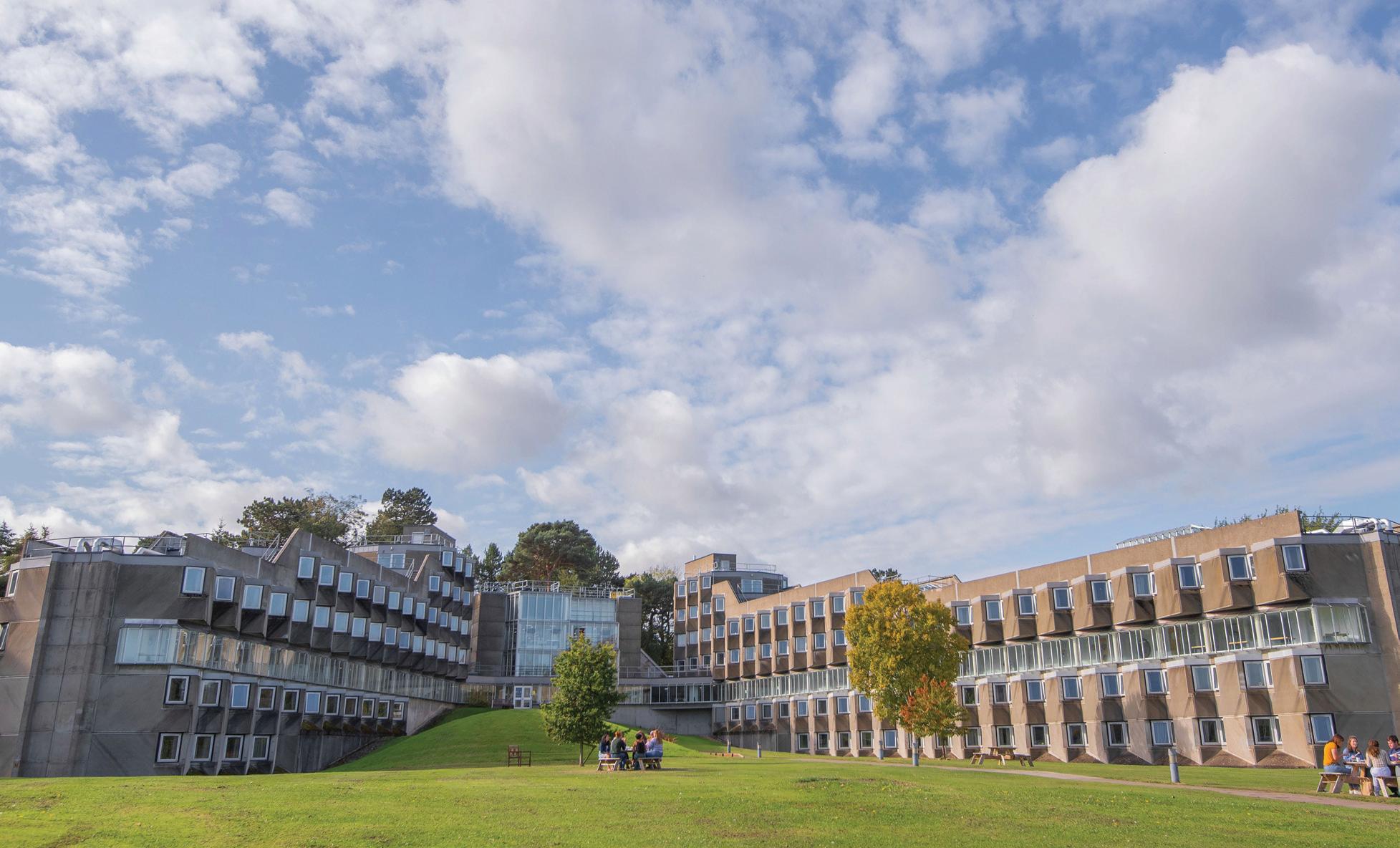
“Get on with people. You’re better laughing.”
goes off on holiday, I’ll always ask them for a postcard. I’ve got them from everywhere. It’s just a trivial thing, but it’s brilliant.”
In such a busy hall like Melville — with over 250 students — Billy is a constant. He told me his “wind-ups” pay off when student feedback for staff comes around. “People say, ‘Oh, you must pay them to say all these nice things,’ and I say, ‘Just be kind to them, have a laugh with them, that’s all you need’.” Billy makes it his mission to really get to know students, and to treat them all equally. He arrived at Sallies a year after Prince William and Kate Middleton graduated. “If they had been there when I was there, I would have gotten an invite to the wedding. I would have been there, I would have talked my way in, I tell people,” Billy told me “But I would have done it by treating them like any other student.”
“Students here are good, they try to look after the place, that’s something important.”
Every hall has at least one porter. Often, they are the first friendly faces you see upon arrival, and remain crucial to the student community — not just for keeping halls clean, warm, and secure, but for giving a sympathetic ear (and in Billy’s case, a contagious smile). Melville residents see Billy daily. It is a reassuring routine, for the students and for Billy himself.
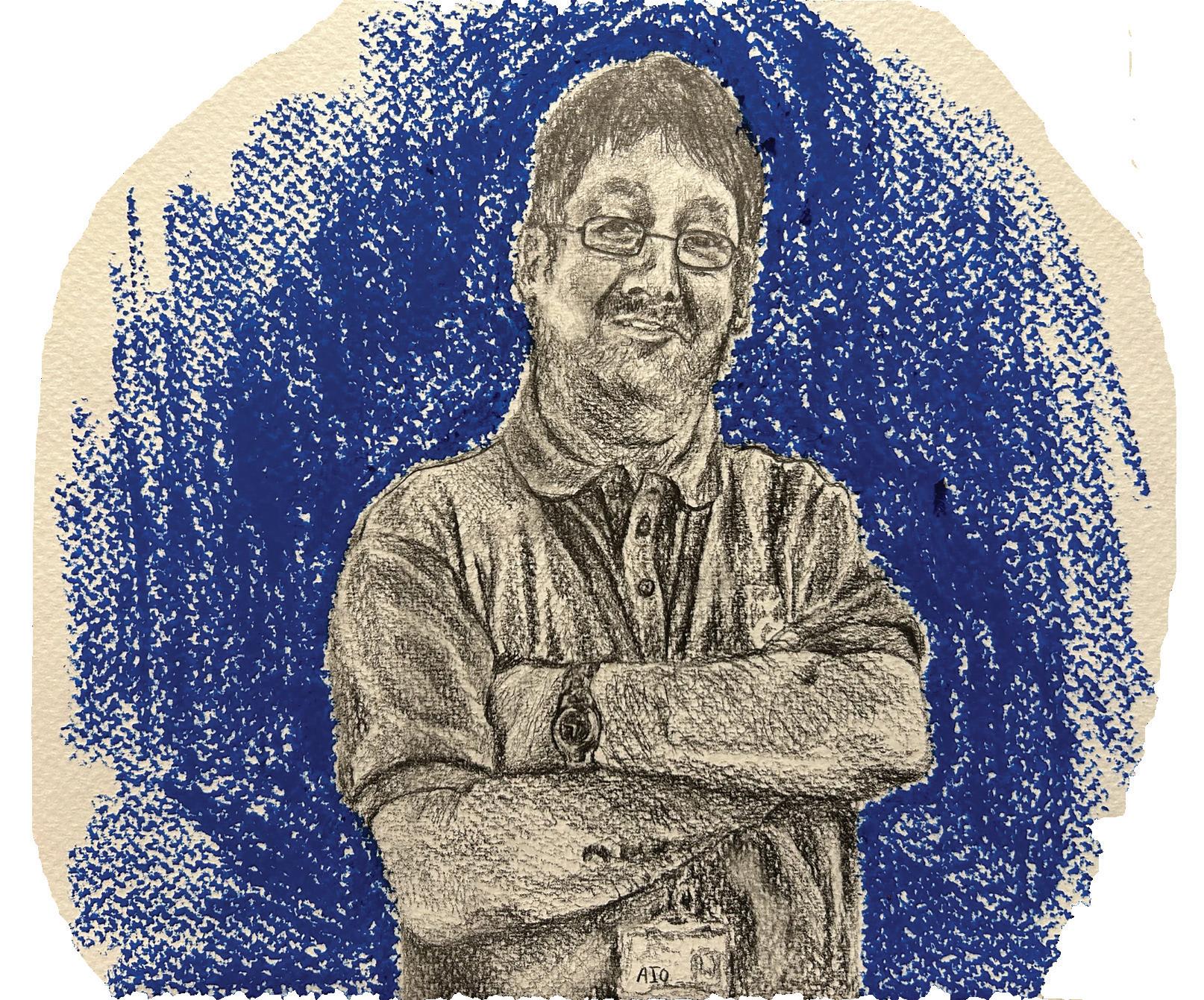
figure for people who need him. “I would like [it] if everybody could remember me when they leave [Melville] for that.”
In turn, Billy likes to remember
‘Where’s my postcard?’, and they said, ‘Oh, sorry, Billy,’ and they went out and bought me one from St Andrews,” Billy said. “That was the first. [...] If any student
In Billy’s opinion, the strong student community here is pretty unique to St Andrews. “We’re a small university, everybody’s together. That’s what makes us good, I think,” Billy told me. “Better than all those other places put together, that way. All the best students come here, I tell everyone that.”
As our conversation wrapped up, I asked Billy: what’s his biggest piece of wisdom? It could be for the students reading this, or for the University, or for anyone on the planet. The smile he gave me was an easy one to return. “Get on with people. You’re better laughing.” As we left the common room and came out into the lobby, he was already cracking jokes with passers-by. “That’s me in The now, that is,” he tells them, beaming.
O’Sullivan
Illustration by Alice
and Photo by University of St Andrews
“I Don’t Want a Man in the Process”
CELIA IRVING Features Writer
Names have been changed.
Thoughts on the ‘absent’ academic father
Creating an academic family is always a bit stressful: you’ve got to organise predrinks, dinners, Raisin, and more — all in a modest effort to win over eager first-years. While many of us remember the hazy mayhem and nostalgia of our academic childhoods (though some of us don’t remember a thing), not all academic families are perfect. In fact, many academic marriages mirror the gendered division of domestic labour prevalent in real marriages, especially in ‘heterosexual’ academic partnerships. It’s been three months since Raisin. Let’s hear Mum’s side of the story.
“[Our family] became a kind of polyamorous lesbian polycule.”
A recurring theme I saw amongst mum-
dad families that didn’t work out was the fault of the academic father — he didn’t pitch in to help with preparations, and, sometimes, he didn’t even show up at all. “My husband loved the idea of kids and the idea of an academic family,” Annabelle, a third-year academic mother, told me. “But I think when it came down to it, he did not know how much work was actually required.”
Annabelle told me her husband didn’t want to help plan events or even reach out to the kids. “I had to do most of that work, and he really enjoyed when that came to fruition,” she said. “But he wasn’t willing to partner with me on actually making things happen.”
Natasha, an academic child, had a similar experience. Her academic dad would “frequently” miss events. “He became busy with work — he was in his final year, so he was also leaving, less dedicated, less there for the long run.”
Andrea, a first year, had less time for her academic dad’s excuses. Her academic dad tried to justify his absence by gaslighting his kids. “At the start, [his absence] was harder to pick up on […] he would go through all the trouble to convince us that it was actually we, the children, that didn’t want to go through all of the activities and that we just wanted to have chill pub nights every so often rather than bonding activities.”
For all of the families I interviewed, I noticed the role that academic relatives (mostly aunts) played in picking up Dad’s ‘slack’. They stepped in to organise events, they were the ones who bonded with the children. Second-year siblings Claire, Nina, and Oscar reflected on their relationship with their academic aunt. “Our aunt had to step up and become like our academic mom,” Nina noted. “She probably wouldn’t have done that if it weren’t for the absence of our father.”
For Natasha, her dad was out-and-out ‘replaced’ by her mum’s flatmates. “It became a kind of polyamorous lesbian polycule.”
To lighten their load, overwhelmed academic mothers partnered with other, less dysfunctional families for Raisin. Annabelle took this approach: “Without that, I don’t know what I would’ve done.” She stressed that she and her children eventually had a successful Raisin. “But it didn’t work out in the end because my academic husband stepped up — it worked out because of everyone else.” Does it ‘take a village’ to raise academic kids, just like in real life?
What are the parallels with real relationships? “I guess when I was going through this, I found [...] the parallels between like real relationships with real children, and ‘fabricated’ relationships with academic children,” Annabelle said.
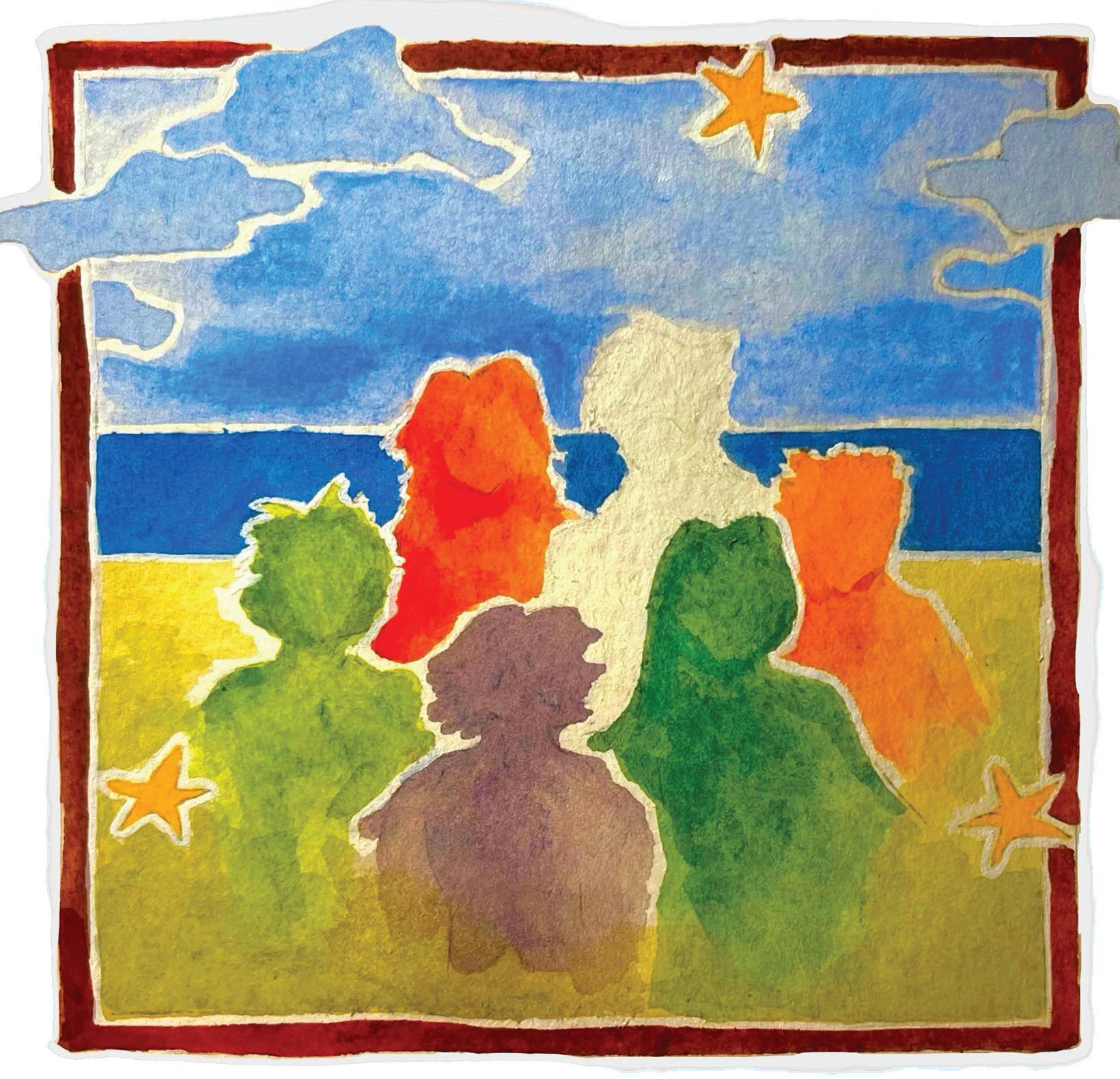
“How many similarities there were in women taking control and the men just kind of going along and being the ‘fun dad’? Showing up to do the fun activities and wanting all the fun things, but not realizing the work behind the scenes.”
Is the slacking off of academic dads a fact of life? Or, like in real marriages, is there more going on?
How much of a stretch would it be to link the neglect of academic fathers to patriarchal norms? Why can men skip (academic) dad duties because of coursework, but Mum has no excuse? Nina had thoughts about her academic dad. “He definitely got away with it more because of the patriarchy,” she said.
“Our aunt at the time had more expectations to participate than our dad, even though she was the aunt, […] partly because she’s a woman.”
Andrea agreed, remembering how her academic dad said her mother was “too much.” In her mind, that was driven by his resentment over the closer relationship his academic kids had with their academic mum.
Andrea’s academic dad told her that
“It’s made me question whether I even want an academic family, which is upsetting.”
her mum was “too overwhelming.” “That’s a [...] classic trope we see over and over again in a patriarchal society — that it’s not the lack or absence of the man, it’s the fact that the woman is too eager and the woman is doing too much and expects too much. He made her feel like this was all her fault,” she added. That blame was undeserved, Andera thought: “At the end of the day, my academic mum just wanted to provide us with a safe and fun experience for everyone. So, yes, I think it caused a lot of stress. It was weird to experience that as an academic child.” Claire has just wed her academic husband and plans on adopting children next semester. I asked what she hoped for her own ‘heterosexual’ marriage. “I expect something totally equal,” she told me. “I believe he will step up, but being a woman, I wouldn’t be so shocked if I [end up with] most of the responsibilities.” But, unlike her own academic father, she doesn’t think her newlywed husband will “drop out entirely.” The bar, it seems, is in hell.
Having seen the grim end of her academic parents’ marriage, first-year Andrea feels fairly put off from becoming an academic wife in her third year: “I’m scared it’s going to be a stressful ordeal and it will be hard to find someone I want to form my academic family with […] My first initial thought is I don’t want a man in the process. I don’t want an academic husband.”
Andrea looked at me. “It shouldn’t be that deep,” she said. “You should want to share responsibilities. Now I’m more aware I have to find somebody that wants to put the work in. It’s made me question whether I even want an academic family, which is upsetting.”
For those of us attracted to men, let us hope the trope of the slack-off academic dad is not an omen for what’s to come in true matrimony. If, however, the famous stat holds true — that one in ten St Andrews students marry another St Andrean — then maybe the ‘absent’ academic father is a red flag worth noting.
Illustration
by
Lucy Maitland-Lewis
The (A*)Stars Behind Amar’s Tuition
HANNAH SHIBLAQ Deputy Editor-in-Chief
It was April 2020, in the midst of the pandemic, and a then seventeen year-old Amar Singh Bhandal wanted to make the most of his time at home. Now a fourthyear at St Andrews, his tutoring company, Amar’s Tuition, has helped over 110 students in the five years since its genesis.
It began when Bhandal observed that the pandemic presented a refined need for tutors: “It became clear that a lot of students were falling behind, and so the [...] number of parents who were keen to get some kind of support for their kids went up, as well.”
At the time, he had no prior tutoring experience. I wondered if that presented any challenges, but he explained that he just applied many of his own tried-andtrue study techniques. “It was very much me building on my experience of having sat exams myself and [...] pass[ing] that [knowledge] on to the students,” he said.
In fact, it is precisely the fact that the company’s tutors are university students that Bhandal says is the company’s “[most] unique selling point.” “[The tutors are] all a similar age, or not much older than the students,” Bhandal explained, “which means that they have recent experience of doing the exams.”
Claire Muller, a third-year student who began working at Amar’s Tuition in June, said the same: “I mostly just [...] put myself in their shoes.” “My first student was [...] an eighteen year-old A-level student, so she
was only [...] three years younger than me,” Muller recalled, “so I just sort of thought, like, three years ago [...] what’s [...] one thing I would have really wanted to get out of being [...] one-on-one with somebody.”
As its name would suggest, Amar’s Tuition began with Bhandal alone. “I hadn’t even [...] fathomed the idea of having several tutors working alongside me,” he said. But with each student’s success, he received more referrals and consequently more clients: “The next question was, well, you helped us to fix English, can we now fix maths?”
Being more humanities-focused himself, Bhandal sought (and still seeks) tutors skilled in other subjects. Should you tutor for Amar’s Tuition (interested readers are encouraged to scan the accompanying QR code for the application form), they would reap the benefits of a £20-£25 hourly rate as well as professional work experience. While Amar’s Tuition is student-run, it is a registered corporate member of the National Tutors Association, making the experience a CV embellishment.
Working for Amar’s Tuition also presents the opportunity to obtain a professional reference — an invaluable asset when seeking post-graduate employment. “You know, everyone can get a lecturer to write one,” Bhandal told me, “but it’s difficult to get a professional letter of recommendation.”
Students are assigned a teacher depending on the tutor’s expertise and their own preferences. As Bhandal explained, the most important thing at Amar’s Tuition is that “everyone’s happy.” He takes student feedback

into consideration before implementing a tutor into a student’s study regime.
This emphasis on individual student satisfaction sets Amar’s Tuition apart from other tutoring companies, especially as it pertains to different examination boards. “Other tutoring services, if they’re trying to [...] offer subjects to lots of different students — especially with hundreds of students — [...] aren’t able to differentiate in the same way,” Bhandal explained.
While the company’s tutors focus on the mastery of the British GCSEs and A-level curriculum, Bhandal explained that a good tutor just has to be “someone who’s willing to put in the time to figure out the specification and plan the lesson.”
“We have several tutors from Northern Ireland and Scotland who didn’t do English GCSE [...] and yet they spend, you know, a couple of hours figuring out the ins and outs of the exam board and [...] [adapting] their approach,” Bhandal explained.
Amar’s Tuition has managed to tackle even the most outlandish of scholastic scenarios. One student who, while training to be a chef in a Swiss hotel, attended German lessons. Another student from last year ended up receiving 100 per cent across all of their English GCSE papers. “It was a pretty big achievement,” Bhandal remembered.
While Amar’s Tuition began as a way for Bhandal to make some extra money, it’s obvious that he cares about each student’s success — something especially evidenced in the company’s pro-bono initiative. Amar’s Tuition offers free lessons to those in need of financial assistance, struggling with health or family issues, and resit students.
Bhandal explained that the latter can face low confidence levels — something which Amar’s Tuition aims to change.“In those last couple of weeks before their exam [...] we try and offer [students] extra lessons just to really boost their confidence,” said Bhandal.
Muller mentioned this, as well, noting that the more specific a tutor’s feedback, the more receptive the student. “Probably about a half an hour of me marking their [work] is [...] me just being like, ‘Oh, you did so well there,’” she said. She told me that the best part of tutoring is seeing that a student has actually applied the advice she’s given.
According to Bhandal, this makes all the difference. He told me that one resit student — who would usually aim to just pass their examination — ended up getting a grade five. “They kind of exceeded and then exceeded again,” he recalled, “which is pretty rare for a resit student.”
Additionally, as a part of their most recent initiative, Amar’s Tuition offers pro-bono tutoring for students who have
“The end result of seeing a student’s success makes it all worthwhile.”
received conditional offers from St Andrews. And should they meet their conditions, they will receive £30 gift cards to both the University shop and Topping & Company, as well as an offer to tutor at the company.
Having St Andrews students on board, Bhandal explained, allows for an invaluable tutoring experience: “Everyone who’s a student at a decent university like St Andrews obviously did pretty well in their A-levels, and so developed these strategies [...] which we can then pass on to the students.”
Bhandal explained that, while running Amar’s Tuition in his fourth-year is demanding, the end result of seeing a student’s success makes it all worthwhile. “Results Day is always a great day because we have loads of messages coming in saying, now I’ve got my A*, I’ve got into university, which is always brilliant,” he said. These success stories often, in Bhandal’s experience, lead to even more, as Amar’s Tuition has helped multiple children from the same family. “The impact we have on [...] families is one where they don’t forget about us once the exams finish,” he said. Amar’s Tuition makes it clear to students that, even after meeting their end goals, they can always ask for additional help. Some students even return for essay and examination assistance once they reach university.
A quick Google search of Amar’s Tuition will provide all of the customer satisfaction evidence you need: listed beneath the company are twelve exclusively five-star reviews. Some are written by the students’ parents, and some are written by the students themselves.
“I can’t thank Amar enough for his outstanding teaching in English,” one former student wrote. “He did me a tremendous favor by helping me achieve a grade 9 in English literature. When I started in year 10, I was far from this level, but Amar’s guidance and expertise made all the difference.”
Tutoring isn’t just about teaching your student, Bhandal told me: “It’s about making sure that it’s a good experience for you, too — that the student [wants] to be there, is prepared, and so on.”
This article is kindly sponsored by Amar’s Tuition.
Image Provided by Amar Singh Bhandal
“They Hunted Protesters” Meet Marika Mikiashvili, St Andrews alum turned Georgia dissident
SIMON EZRA-JACKSON Features Editor
More of Manraj Gill’s photos of the protests can be found on page 19.
Before the gas masks, and the burning coffins, and the fireworks whooshing at the parliament building, Marika Mikiashvili studied at St Andrews. She was born in Georgia and completed her undergraduate degree in Tbilisi, the post-Soviet country’s capital, before coming to St Andrews five years ago for a Master’s in Security Studies — this was the only place she applied. After her degree, she came back to Georgia and spent a year with an NGO, going to remote villages in Georgia’s mountains to teach school children about their democratic rights. After a year, though, she was frustrated. NGO work wasn’t enough; she wanted “immediate change” in her country’s politics.
“This, that’s ongoing right now? It’s nothing like ever before.”
So Mikiashvili took the “financially reckless” decision to quit NGO work and join the foreign affairs team of Droa, a small proEU Georgian party. For a couple of years, her job was fairly routine. Then, as Georgian politics made international headlines last year, Mikiashvili was thrust into the spotlight. There had been regular antigovernment protests in Georgia for years, but “this, that’s ongoing right now? It’s nothing like ever before.” It started in April 2024, when the Georgian government announced a new ‘Foreign Agents’ law that its critics (including Britain, the EU, and the US) condemned as an anti-democratic “Russian law.” In the demonstrations following that law, Mikiashvili gave “around five hours [of] interviews” every day to outlets like CNN, France 24, and the BBC. Nowadays, her “24/7 job” is social media. Between last April and now, her following on X grew twentyfold — she guesses she’s one of around “five” people who regularly posts about Georgian politics. “It just snowballed,” she told me. In October 2024, Georgia held elections. Electoral observers and the EU alleged they were ‘stolen’ by the ruling Georgian Dream party. Mikiashvili agreed: “even the regime supporters know the elections have been rigged.” She described the “carrots and sticks” manipulation methods of Georgian Dream.
“In the run up to elections, the government [...] said that they would know whom each individual would be voting for,” she told me.
On 28 November, the European Parliament called on Georgia to rerun its elections. The same day, the Georgian Dream Prime Minister announced Georgia’s EU accession talks would be delayed for the next four years. “Technically he said until 2028,” Mikiashvili said, “but everyone understands that essentially it means never.” That announcement was met with fury by many Georgians — 80 per cent of whom want European integration. “That same evening, large-scale protests began […] it was simultaneous in every Georgian city and town.”
Before the protesters, Mikiashvili started a PhD at a university in Tbilisi — she’s now put her doctorate on hold. The university’s administration are “very much involved with the regime,” and she found writing her thesis on Georgia’s European integration “impossible.” “How can you write an essay about something blowing up around you?” she asked.
“throw you into a police van and then beat you there for twenty minutes, half an hour.” Some protesters have been threatened with being “buried alive,” Mikiashvili said.
“The first few days and the first few crackdowns, I was there,” Mikiashvili told me.
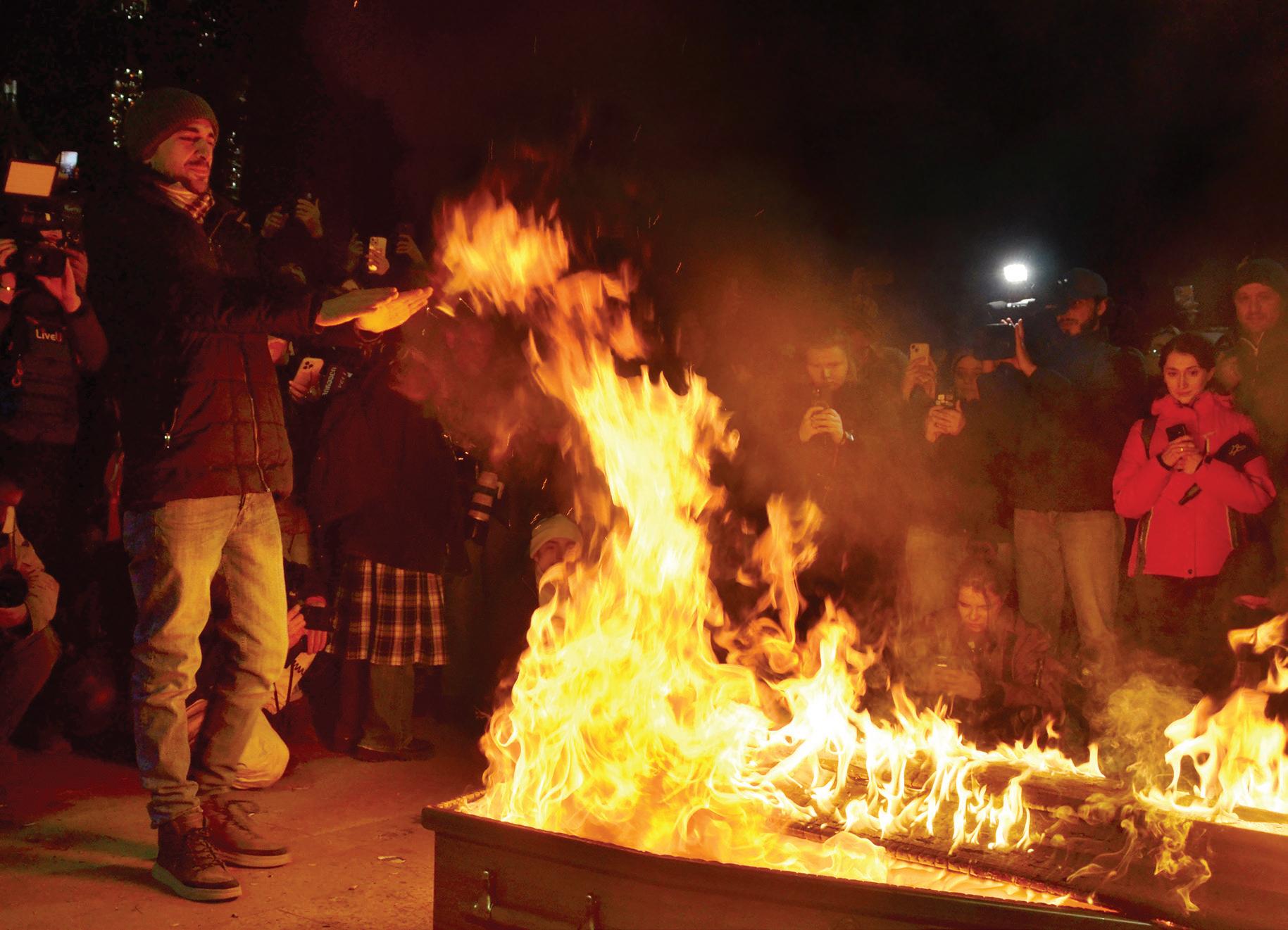
For most of December, however, she was ill, and decided to stay home to cover the protests on social media. “I understood that I could not run for my life and tweet live,” she said.
Protesters organised themselves quickly. “We were defending ourselves with barricades, with protective gas masks,” Mikiashvili remembered. “People were quite fast and effective in forming the self-defence squads and counterattack squads or neutralising the tear [gas] by putting it in water bottles.”
“Setting grounds for [a] free country [...] It is very fulfilling to me.”
But the police “hunted” protesters, she said. “[Police] dragged them out of shops where they sheltered, they dragged them out of theatres where they sheltered.” When the police arrest you, Mikiashvili said, they
In the past, anti-government protests had mostly happened in the evenings. Now, people went out for the whole day. People organised a seven km-long human chain that snaked through Tbilisi. A clip of protesters shooting fireworks at Georgia’s parliament building went viral on TikTok. Daily marches happened by profession or by hobby. “There was even a Harry Potter-lovers’ march, a yoga-lovers’ march. Anything that you might think of, had its own march,” said Mikiashvili.
It’s been two months since the fateful November evening. Georgian Dream is still in power; protests have mostly dropped out of international news. Is Mikiashvili worried they aren’t getting anywhere? “The protest sentiment has not decreased,” she told me. “I don’t think it can decrease at all […] [there’s] no concession that they can give us.” There are still tens of thousands of demonstrators on the streets each night, she said. “There’s this general feeling in the country that it’s just like it was on day one.” There has been some response from the West. In late December, the US sanctioned
Bidzina Ivanishvili, the billionaire founder of Georgian Dream. “Ivanishvili holds the entire country in his pocket for Russia’s benefit,” Mikiashvili said. The sanctions were a “morale boost” for the opposition but didn’t go far enough. “We are, of course, hoping for more,” she said. Does Mikiashvili have advice for students here, three thousand miles away from her home? If you want to do what she does, you must be “very passionate,” she warned, and make sure you have a network for both emotional and financial support. Students, especially if they’re from Eastern Europe, are “welcome” to reach out to her.
As we finished up the interview, Mikiashvili asked me to mention how much she loved her time at St Andrews. She stressed how much happier she is now, right at the heart of politics, instead of estranged in the mountains. “Setting grounds for [a] free country, for future generations? It is very fulfilling for me,” Mikiashvili told me. “I know many people who are happy in life, they have a lot, but they are still searching for this sense of fulfilment […] I am very lucky in that regard.”
You can find Marika on X @Mikiashvili_M or on Bluesky @marikamikiashvili.bsky.social.
Photo by Manraj Gill
Protestors burning an encoffined effigy of Bidzina Ivanishvili, the founder of Georgia’s ruling party.

Gods of Love

ACROSS
1. Lowest part
5. + Z to undo
9. Greek baby celeberated on 14/2
14. Mukbang sound
15. “Up, up and ___”
16. Carmen, for example
17. Greek goddess celebrated on 14/2
19. Way up or down
20. Lyrical poet
21. Symbolic wreath
22. Piece of glass
25. Performer on wood stage
28. Malibu or Bacardi
29. “ ___ upon a time”
30. Curvy letter
31. Like a writer for The Saint
35. Uni. degree of Jane Austen
38. Classification of 9A, 17A, 61A, 67A, and 68A
43. Sailor, without the usual sounds?
44. Pep talk purpose
46. Machine outside of Tesco
49. Go out with
52. “Who ___ you?”
53. 2008 economic decline
56. “Prime Time” NFL player Sanders
58. Old romance, figuratively
59. After an A-Lister
61. 1966 Michael Caine rom-com
62. Roman Saint celebrated on 14/2
66. Where you might find Chopped
Chin
67. “__ it,” confirmation
68. Roman deity celebrated on 14/2
69. Norse goddess celebrated on 14/2
70. Love __
71. University of St Andrews accom.
Anagrams: Romance Movies
by Greta Shope
DOWN
1. Sheep sound
2. Egyptian snake
3. Acronym of dismay
4. “404: ___ occurred”
5. U.S. car abbrv.
6. Bottle cap type
7. Wicker plant material
8. Soap making ingredient
9. Market Street coffee company
10. Sport’s Illustrated model, Kate
11. West Ham United manager
12. Colored parts of eyes
13. Challengers
18. Like 3, 13, or 9
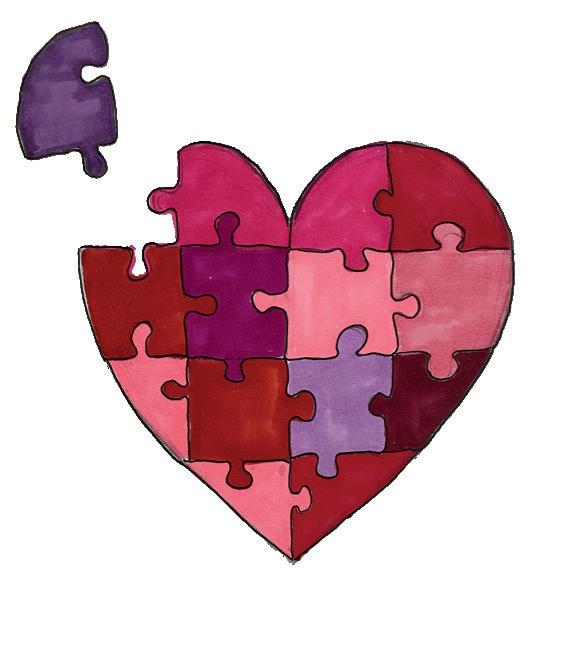
22. Tix. for back of the theatre
23. Suspended on a hook
24. “Are not!” response
26. Not a Mac
27. Makes unacceptable
32. Superbowl pts.
33. Language for the deaf in Massachussets or Texas
34. F150 and F450
36. Vote against
37. Supplement store
40. Appointment availability
41. Common Taste order
42. Currency in France or Italy
45. Ink jotter
46. Barking onomatopoeia
47. Bank employee
48. Antivirus software company
50. Like ChatGPT
51. Trinidad counterpart
54. Girl in Paris
55. _____ ghost: when one has a spiritual sighting
56. ___dadan, Yukinobu Tatsu manga
57. Pea plant classification
60. Head, to Descartes
62. Hotel du ___, St Andrews lodging
63. Rage
64. Boozy egg drink
65. Letter after Arr
Connections
Julia Emery
Find groups of four items that have something in common! by
EDITOR: ALEX LE SAGE
by Greta Shope
Make as many words as possible! Rules: Words must have at least 4 letters and must contain the center letter. Letters can be used multiple times. Scoring: 4 letters words are worth 1 point each. Longer words are worth 1 point per letter. Each puzzle has at least one word which includes all the letters and gives you seven bonus points.
- 105 Great - 168 Amazing - 210 Genius - 294 Perfect! - 420
Word Search
Crossword by Julia Emery and Iris Hubbard
by Iris Hubbard
by Alex Le Sage
Illustration by Calum Mayor

EDITOR: ALDEN ARNOLD
Love and Friendship: Valentine’s in St Andrews

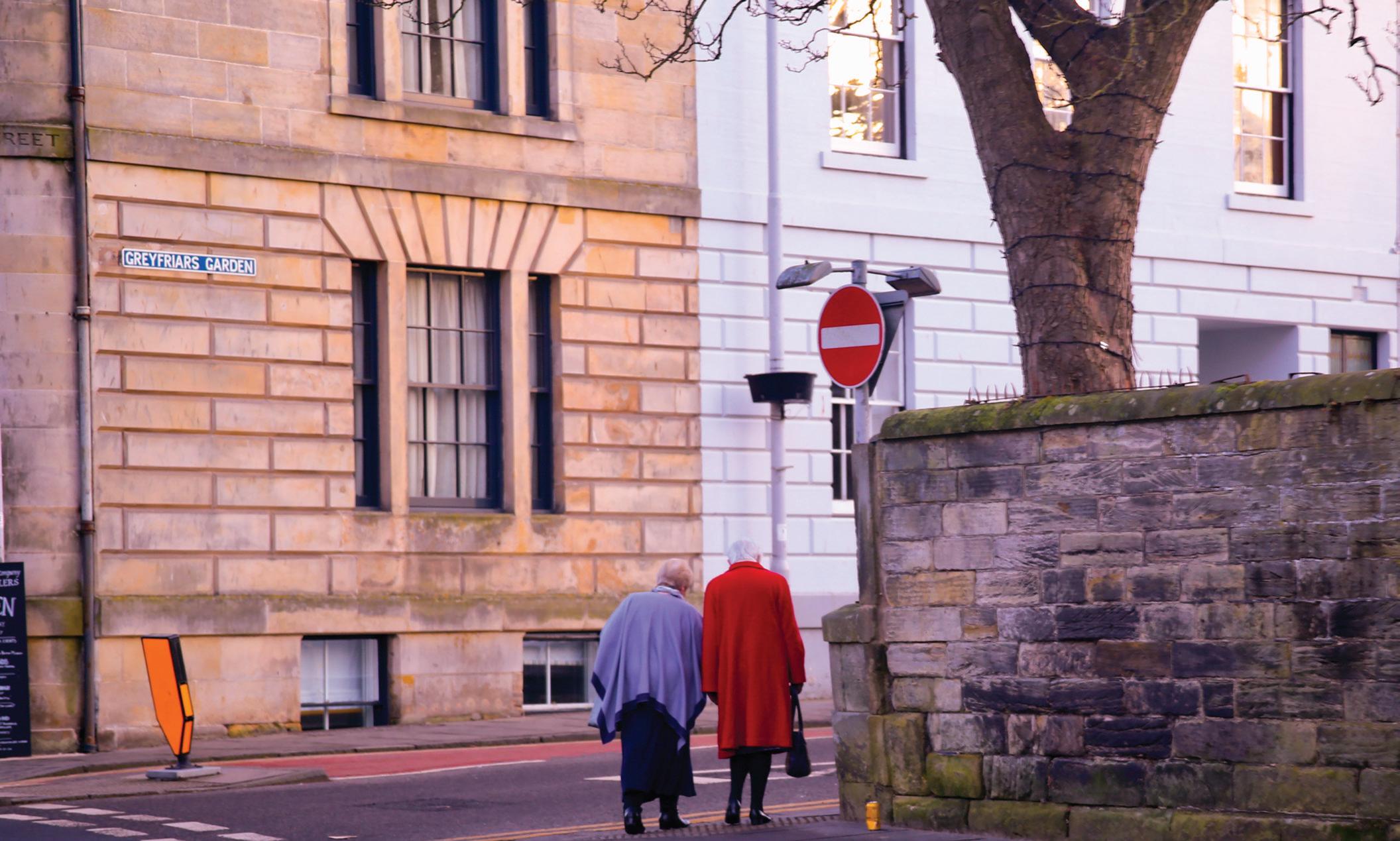
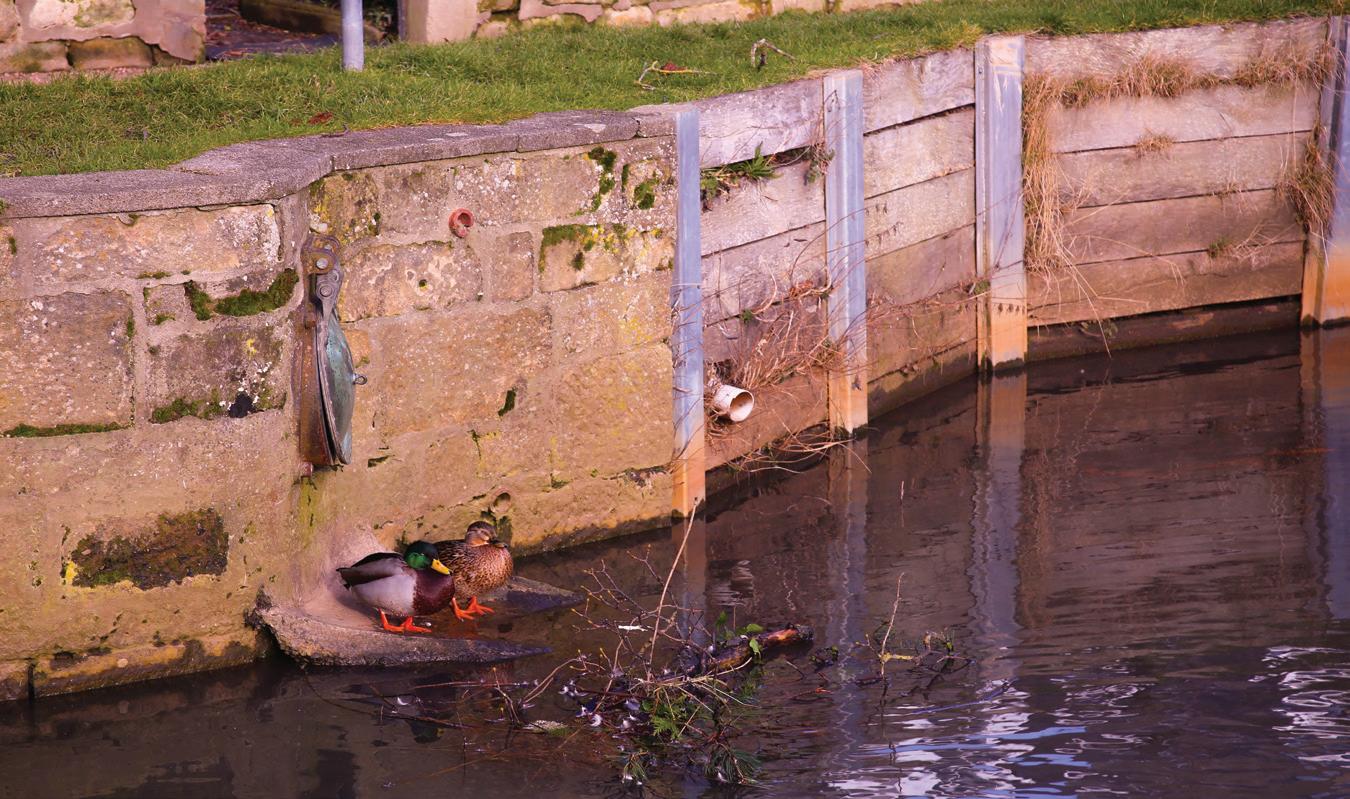
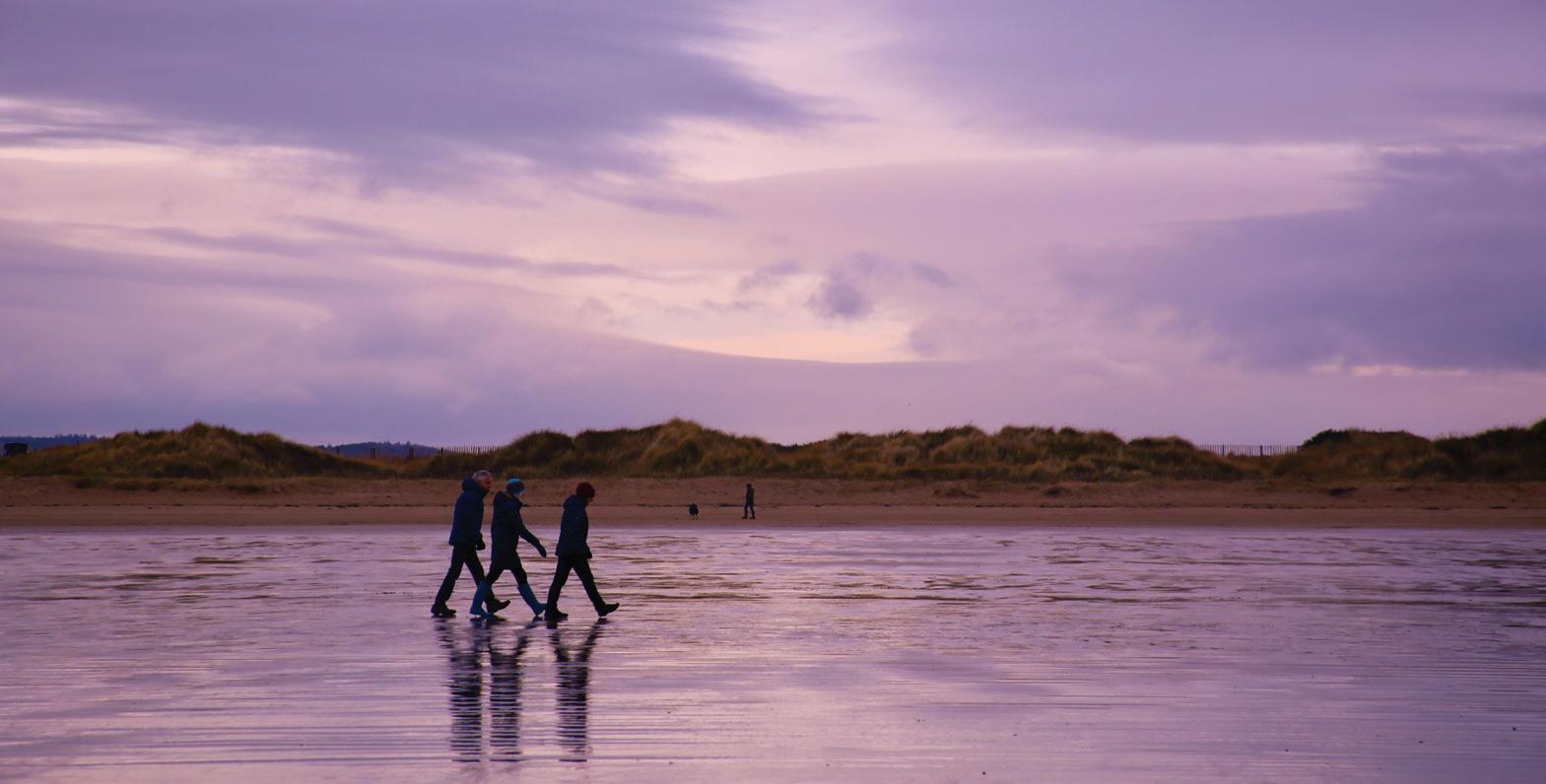
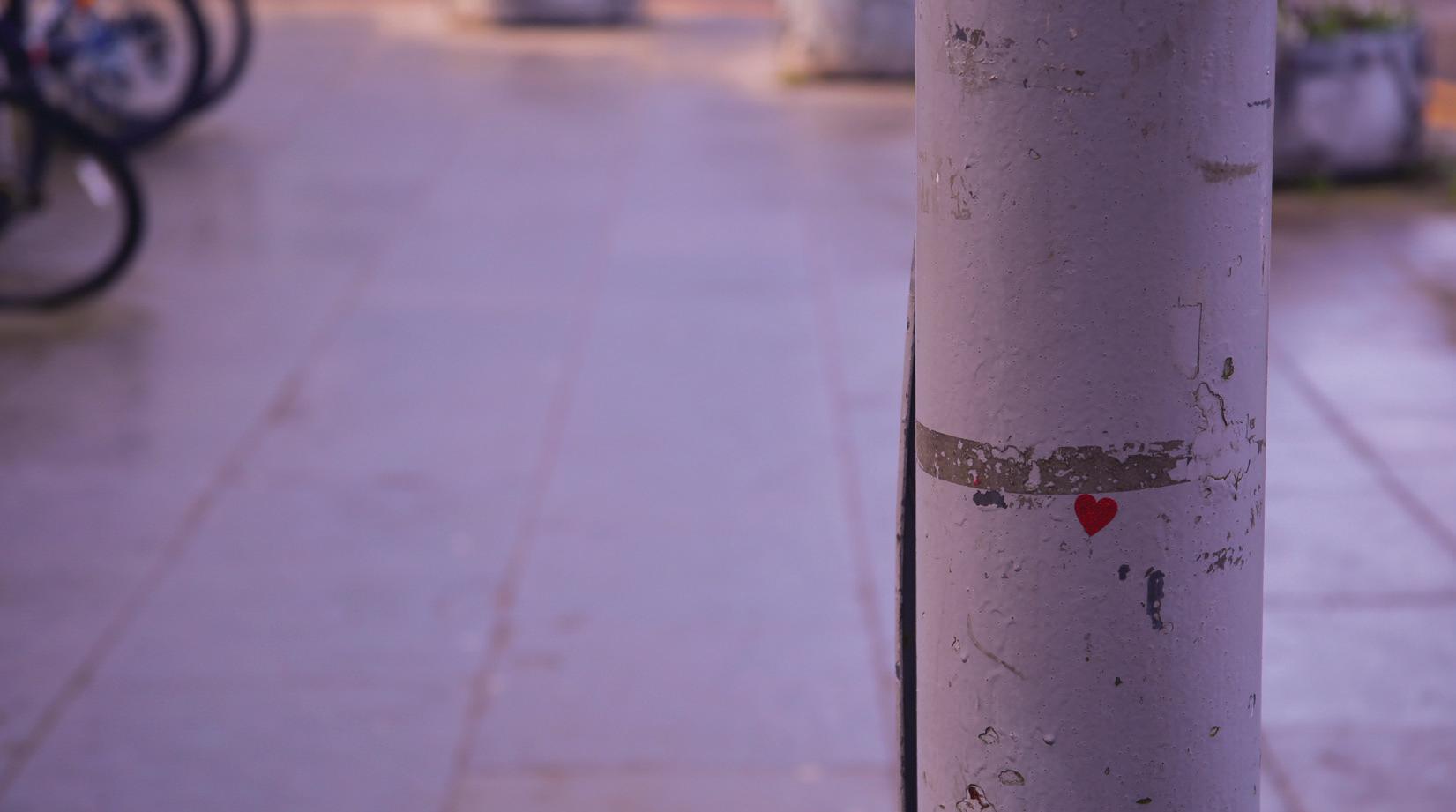
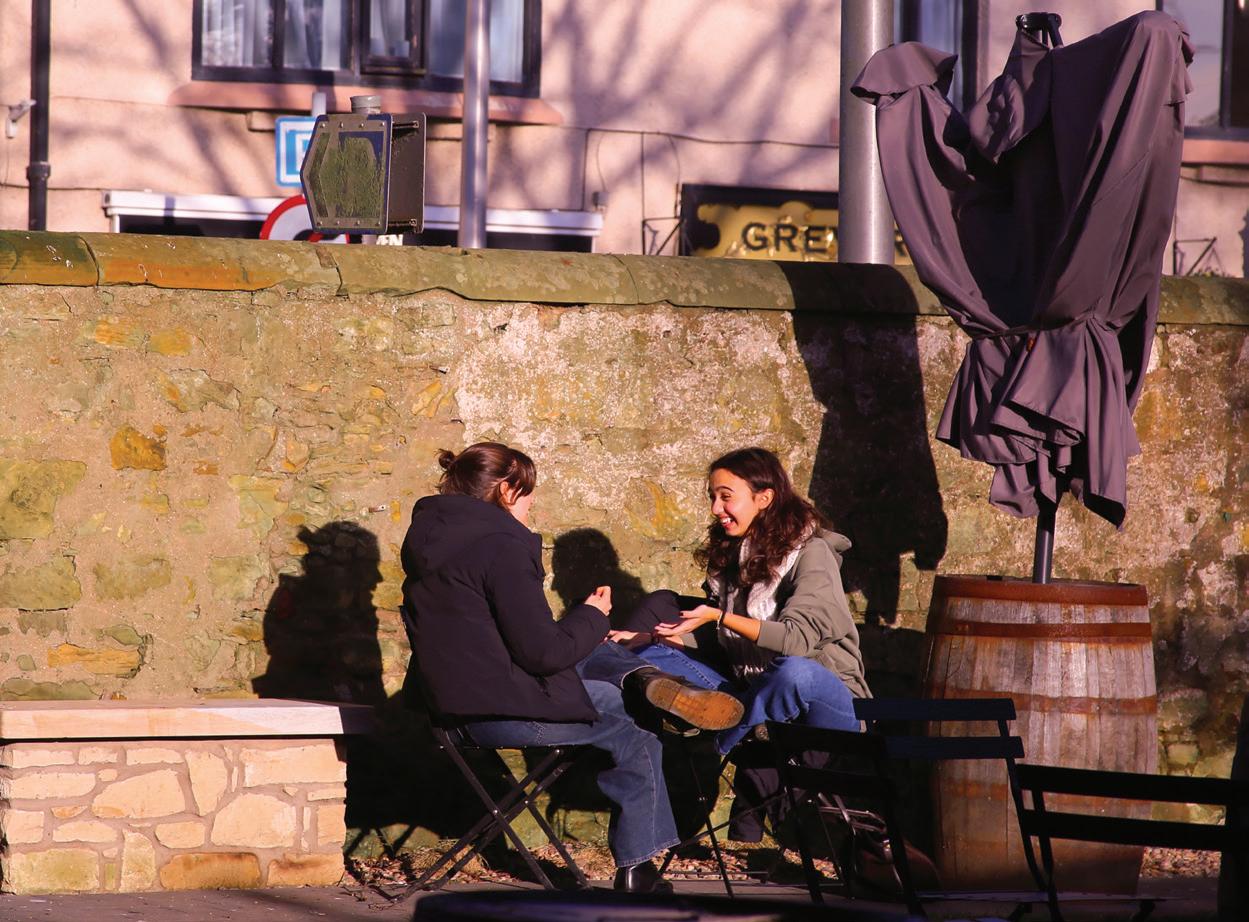
HANNAH CLARK Photographer
MANRAJ GILL Photographer
Through the Lens: Georgia’s Fight for Freedom
For more on St Andrews’ connection to the Georgian conflict, see page 16

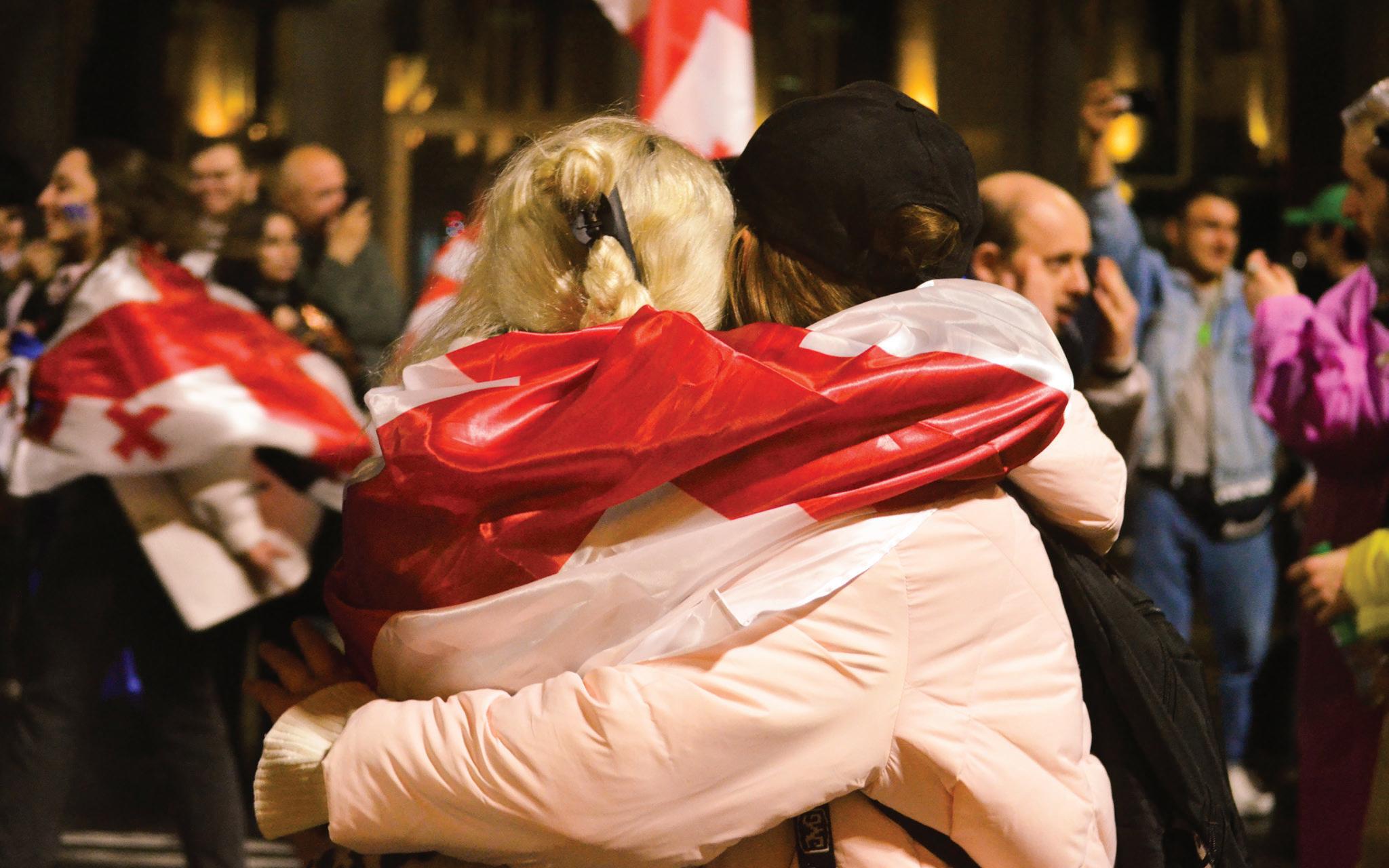
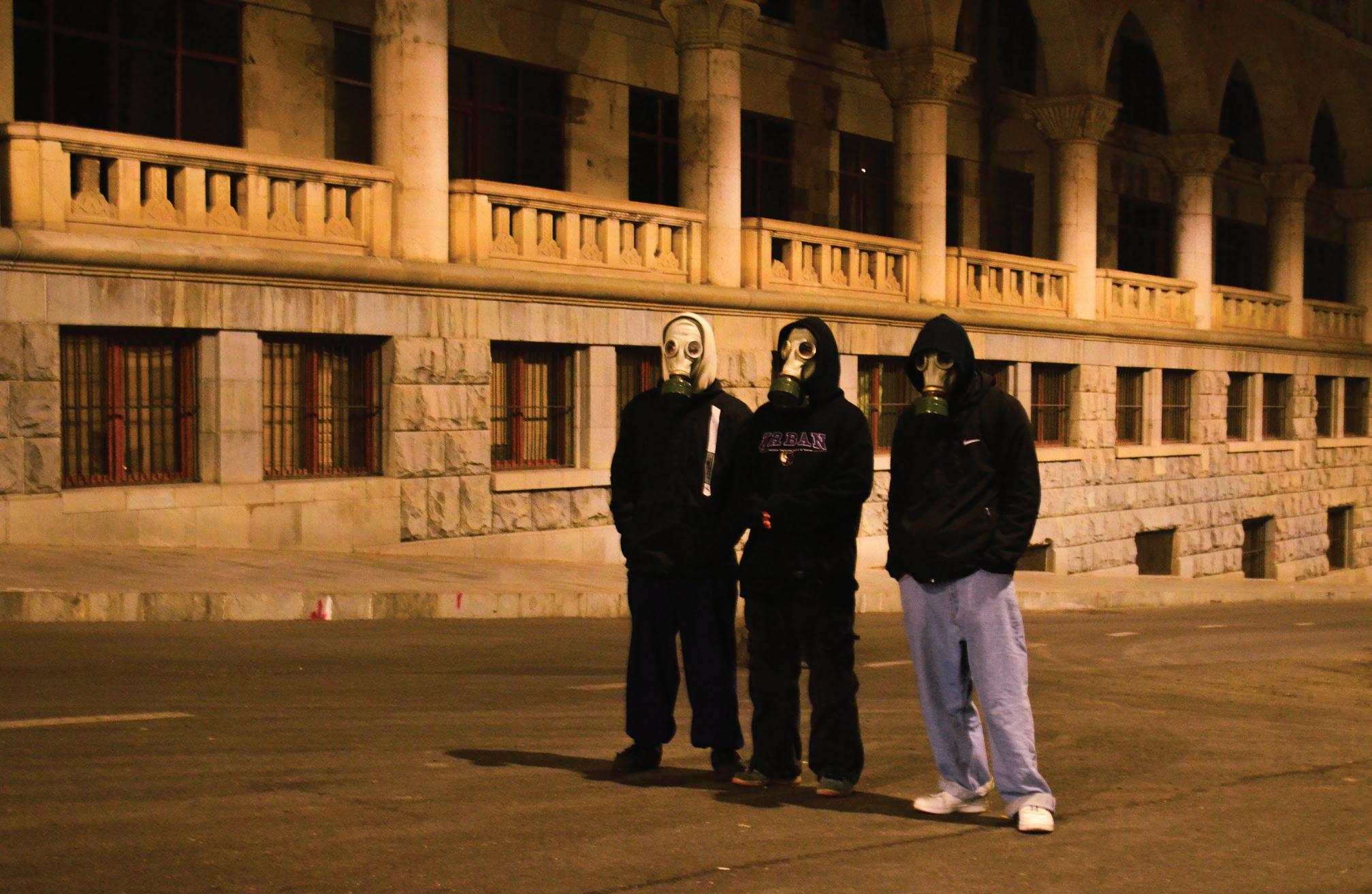

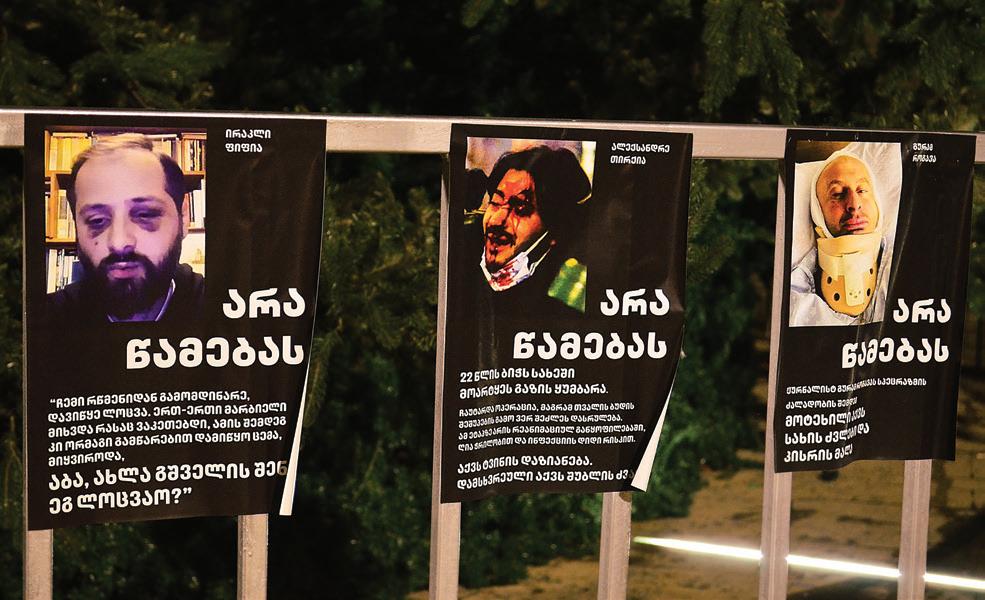

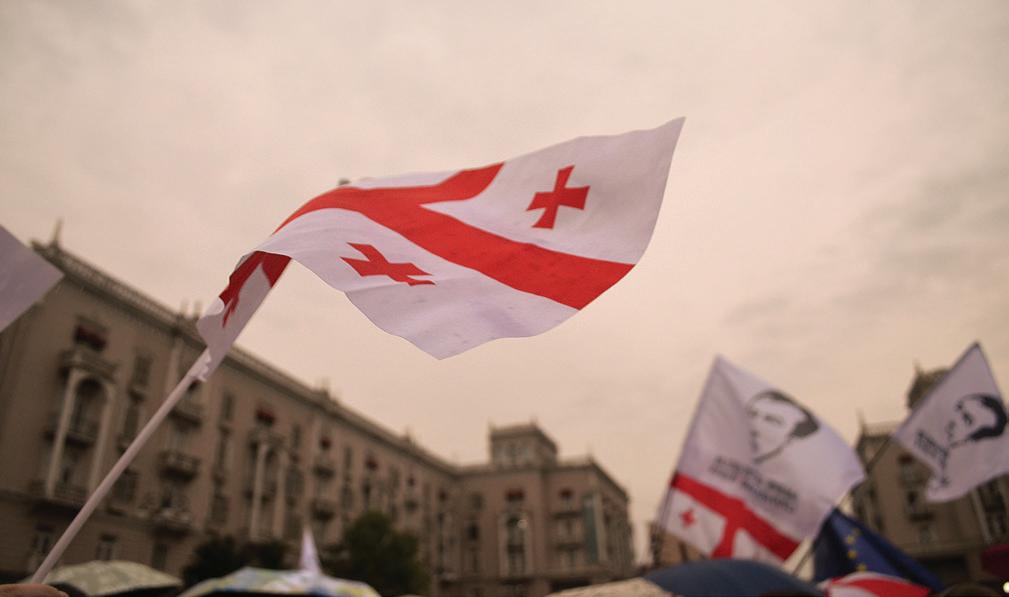
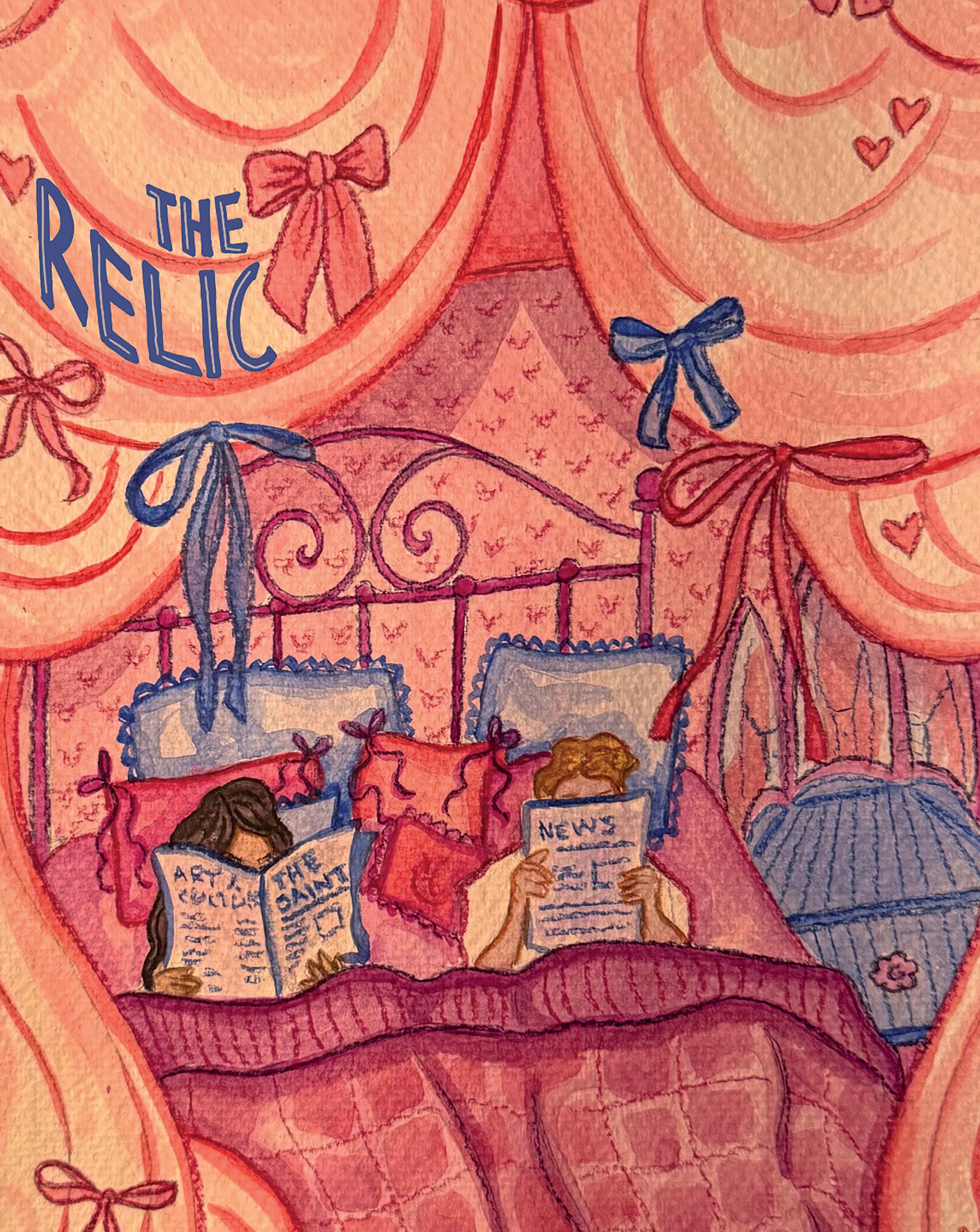
Valentine’s Day: A Cloudy History
DANIEL ALDERSON Relic Writer
Among the countless other special dates automatically marked on our yearly calendar, 14 February is meaningful to many. Flowers are bought and cards are signed with love from their senders. And all of these things are done because they are… supposed to be? But why? There are many days, and certainly many ways outside of the arrow-slinging Cupid’s conformities to show that you care about your partner. So why is it that this day has been eternally chosen to represent a connection that is neither called upon nor created — certainly not at the whim of a Tesco advertising drive — but is as bewildering as it is beautiful?
While the origins of Valentine’s Day retain an air of mystery, even regarding which of the many Saint Valentines is being commemorated, an idea of this celebration’s roots can be traced back through a cloudy chain of history. Between 13 and 15 February, ancient Romans celebrated the festival of Lupercalia, in which women who wished to conceive were struck by animal skin strips as those who wielded them ran naked around the Palatine Hill. Quite strange, you might say, and importantly lacking in anything characteristically romantic. Yet still, the roots of February’s Spring-starting fertility are seen clearly: the animal skin strips, or februa, actually give this month its
name. New life and new love, perhaps.
As the Roman Empire gradually became Christianized after the conversion of Emperor Constantine, the Pagan festivals, once scattered across its calendar, followed suit. It has been suggested that Pope Gelasius I intended to draw the focus away from this wild Pagan celebration and towards Christianity when he declared 14 February as the Feast of Saint Valentine in AD 496. But who was Saint Valentine?
The strongest candidate is Valentine of Rome, who is said to have aided persecuted Christians before being executed in AD 269. Much of his story remains unknown, and various embellishments have since penetrated the narrative, the majority of which were included to enhance the wonder of the celebration. The scholar Bede states that Valentine’s execution was preceded by
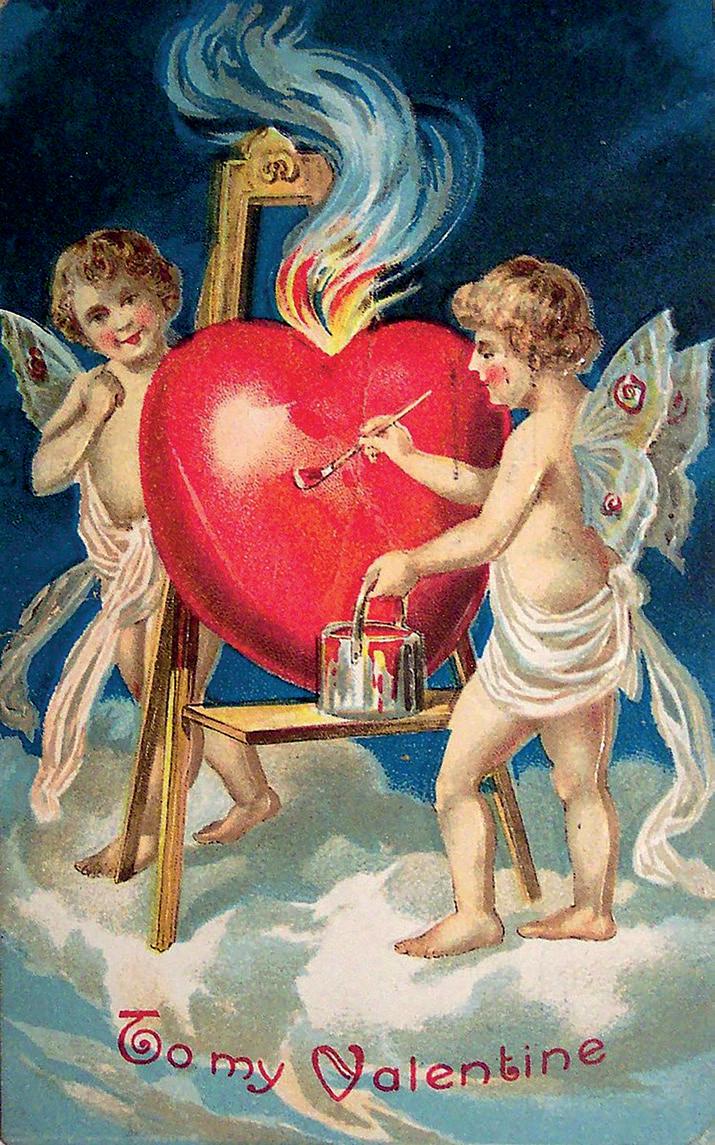
a miracle that converted 46 people to Christianity. Another retelling informs us that he fell in love with the daughter of his jailor and left her the first Valentine’s card before he was killed. The same Valentine allegedly also performed Christian weddings for soldiers who were banned from marriage. The historical accuracy of these statements is not so significant here — the myth-making is obvious. Nevertheless, it is comforting to know that the wonder and creative license of story-telling occurred prior to, and without focusing on, commercial exploitation. Valentine’s Day had its canon long before it became a tool for profit. The clear association of Valentine’s Day with romantic love can be attributed to Chaucer’s Parliament of Fowls, in which
the day is attached to the mating of birds, a celebration of Springtime fertility that distantly recalls the purifying instruments of Lupercalia. By the 1400s, people had begun to follow Chaucer’s birds, as monk John Lydgate wrote that it was tradition for young men to “search Cupid’s Calendar and choose their choice with great affection.” By the 1820s, it is estimated that 200,000 Valentine’s cards were sent annually within London, a number that would rise significantly after one-penny postage stamps were introduced in 1840. It is easy to look at the inescapably corporate machine that is the contemporary Valentine’s Day and react with distaste: there is nothing romantic about commercialism. The cheap roses teetering on immediate expiration, the overpriced chocolates marked up to the maximum, the predicted spending of $27.5 billion expected this year in the United States. But the reality of the present day does not have to ruin what is, at its heart, a day dedicated to love. The silver lining is obvious in the genuine warmth a Valentine’s card or gift can evoke. Where there is meaningful connection, the commercial holiday that facilitates it doesn’t matter. 14 February is the most common wedding anniversary in the Philippines — not because people love to engage in their supermarkets’ advertising campaigns, but because people will grab at any chance to celebrate the ones they love.
Image from Wikimedia Commons
William Morris’ Floral Revolution
SAMUEL THAYRE Relic Writer
Great artists are often thought of as revolutionary. They establish new (or revive old) styles, techniques, or genres. Some may be revolutionary in the political sense, challenging the status quo. Others even transcend history and their work remains firmly embedded in the canon of art rather than withering away into obscurity. The best embodiment of these qualities is perhaps the Victorian polymath William Morris. Undoubtedly one of the few who are revolutionary in all of these ways, his brilliantly unique works in both textile and print were great contributors to the popular emergence of two artistic movements — the neo-Gothic and the British Arts and Crafts movement. His focus on the handmade in an age of burgeoning industry and mass production is stark, while his attitude to domesticity fought against needless clutter: “Have nothing in your houses that you do not know to be useful or believe to be beautiful.” Morris is clearly, then, a man out of his time, as if he had been plucked from the medieval period and thrown
into an age that he could only disavow. Therefore it’s not surprising to note that Morris held a great interest in medieval culture. Studying Classics at Oxford University, he was surrounded by the architectural remnants of the Middle Ages, and he often spent time perusing the Bodleian’s illuminated manuscripts. Such culture seeped into his artistic genius, and his establishment of the Kelmscott Press alongside his textile work makes this obvious. Medieval motifs, especially of nature, are fraught within his art. His most prolific work, Strawberry Thief, appears as if formed by a medieval monk’s hand, transgressing the typical time constraint of history. Now, it appears upon all sorts of merchandise, its cheeky bird peering out to observers amongst a floral backdrop, strawberry hanging from its beak. Over a hundred years later, Morris’ designs such as these are everywhere — but why this timeless appeal?
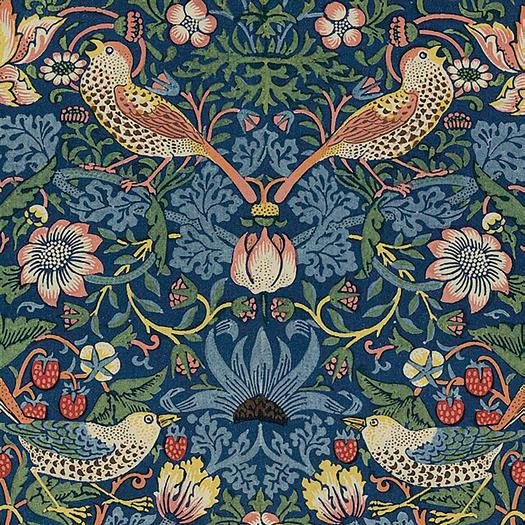
Perhaps it is precisely this medieval style that attracts us to his work. It is paradoxically modern and historical, a form of Victorian anachronism that elicits a sense of historical importance and beauty. As pioneering pieces of the British Arts and Crafts movement, they were all designed painstakingly by Morris’ own hand. Championing the virtues of handcrafted art, Morris serves as a welcome break in our current age of consumerism and art crafted not by tender, meaningful hands, but rather by the cold, emotionless hands of production line robots. “Romanticism was bred into his bones, and formed his early consciousness,” stated New Left historian E.P. Thompson. Indeed, the rejection of the industry of the Romantics can be found within Morris’ work, and this rejection of overbearing technology is precisely what so many people search for today. Morris was also a committed socialist
(hence Thompson’s extensive work on him), and he campaigned for better conditions in a time of notorious exploitation. It is rather fitting that the spectral hand of hauntology, associated as it is with leftist movements, has ensured that Morris’ art has never truly been laid to rest. Nature has been displaced in our modernised, digital world, leaving us alienated and longing for natural beauty: tulips, marigolds, and chrysanthemums. Morris’ works are not only a reminder of the intricacies of nature, but also an interesting testament to how neoliberalism and industry have left us longing for both the past and such intricacy. There’s a lot one could say about Morris. His repeating textiles are hypnotic, yet not overwhelmingly vibrant or distracting. His work is temporally displaced, yet purposefully so. His politics were rebellious in a time of economic subjugation. We can identify with the titular Strawberry Thief: in observing Morris’ art, we are taking the beauty of nature and allowing it to sustain us, albeit mentally rather than physically. William Morris is not only revolutionary — he invites his audience to be revolutionary, too.
MARI CLAUDIA REIMER Relic Writer
As a child, every road trip to our Texas ranch included an unexpected detour: graveyards. My dad would pull over, step out, and wander through the headstones, sometimes snapping photos. At first, I thought it was a little odd — maybe even unsettling. But to him, cemeteries weren’t about death; they were about life. The names, the dates, the way people were buried together — it all told a story. Eventually, his fascination rubbed off on me, though I saw cemeteries differently: while he saw history, I saw art. Cemeteries became accidental museums — each headstone a final self-portrait. Some were carefully chosen by the deceased themselves or their loved ones, others decided by strangers. Yet, no matter who made the choice, each grave left an impression, a testament to a life once lived.
Graves as Galleries
graves stand in uniform rows. But some gravestones go beyond tradition, standing out in ways that feel more personal, more deliberate — almost like sculptures meant to be interpreted rather than just observed.
At some point, I realised I had become something of an art critic — not of paintings or sculptures in a museum — but of graves. I study their composition, their symbolism, and their storytelling. What does a window in a tomb reveal about the person inside? What does a marble figure say about the man of its likeness? Which graves whisper their stories subtly,
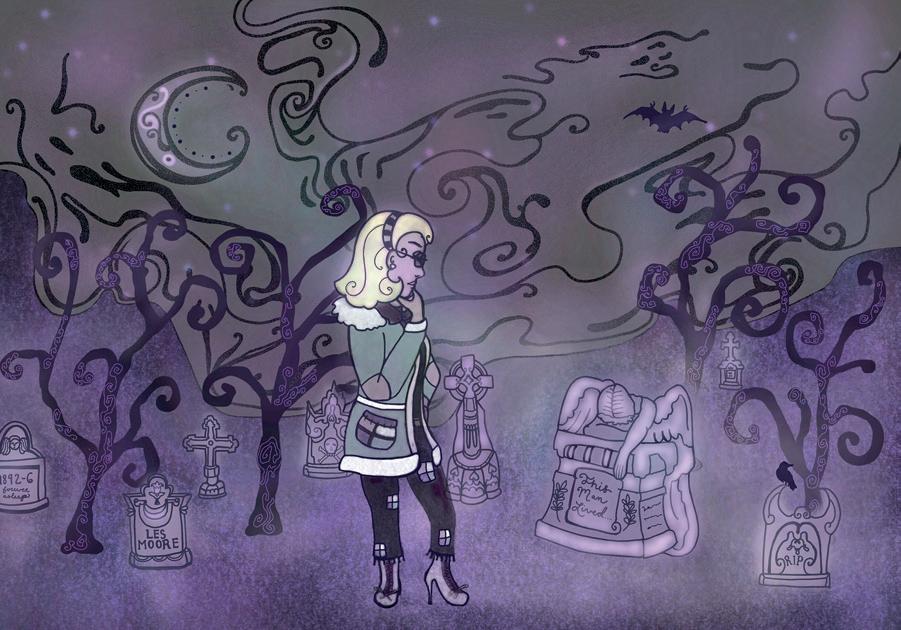
Like any gallery, cemeteries have their own artistic movements, from the dramatic arches of Gothic revival graves to the sleek lines of modern headstones; Art Deco mausoleums are finished with precision, while military
and which ones demand attention?
Before Merritt Beardsley died of a fever in 1865, he asked his father not to bury him underground, terrified of spending eternity in darkness. So his father honoured
his wish by designing a tomb with a small window, allowing sunlight to trickle in. It’s a piece of art, really — blending love and fear into one design. However, the window isn’t just about light; it transforms the tomb into something dynamic, changing with the time of day and seasons. Even in death, Beardsley’s grave invites interaction, a quiet conversation between light and shadow.
Then there’s the Luyties family plot in Bellefontaine Cemetery, where a striking marble sculpture of a woman stands in a stone chamber, encased behind a glass window to protect her from the elements. Her gown drapes over her feet, impossibly long, her eyes left open as if watching over the man who placed her there. But here’s the twist: she isn’t a member of the Luyties family. While travelling in Italy, Herman Luyties fell for a woman modelling for the Genoese sculptor Giulio Monteverde. She rejected his advances, but that didn’t stop him from commissioning Monteverde to carve a lifelike marble figure of her, possessing her in stone when he couldn’t do so in life.
For years, the statue sat in his foyer. When it became too burdensome to keep at home due to its extreme weight, he moved it to the family burial plot. And when he died, he was buried at her feet. The symbolism is almost too poetic to ignore: she, is forever elevated and untouchable, while he lies beneath her. Even in death, his longing is palpable. Meanwhile, his wife
and children are buried across the street. Not all gravestones are grand gestures of love or fear — some tell stories of community. If you’ve ever stumbled upon a tombstone shaped like a tree stump, you’ve found a relic of a forgotten history. In 1890, Woodmen of the World, a fraternal benefit organisation, offered life insurance policies that included a unique perk: provided gravestones. But these weren’t ordinary markers. Members received elaborate stone carvings designed to resemble tree stumps, symbolising strength and a life cut short. Adults were honoured with towering stumps, while children received a stack of three logs. Each monument was deeply personal, with bark textures, severed branches, and carved inscriptions with small details to make every piece feel alive. Wandering through cemeteries, you start to realise that graves, like people, have personalities. Some are grand, demanding attention; others are quiet, waiting to be noticed. And while we like to think of death as an ending, these markers prove otherwise. They’re art, history, and storytelling encased in stone — a final statement left behind. I don’t visit graveyards because I find the macabre intriguing, and I certainly don’t visit them to be sentimental — I visit them because they are strange, openair galleries where art and history collide.
Illustration by Isabelle Holloway
Don’t Come for My Kindle!
ALEX BARNARD Relic Writer
Picture this: you’re in Rector’s one sunny Saturday morning, ordering a coffee before you hit the library. You turn from the cashier, your eyes widening — who is that?
Sitting in a rather raggedy jumper, curtains falling into his face, he’s sipping his coffee and skimming some great work of literature. You’d like to think it’s and Peace, but, be honest, he’s probably eating up some Colleen Hoover. Sick of rugby guys, you pluck up the courage approach this fellow whose sex has skyrocketed with this intellectual streak. But, as you approach, your heart sinks. That’s no ordinary book in his hands. With the sight of that drab, pseudo-iPad, you retch — not a Kindle…
I used to be one of these Kindle-shunning traditionalists. “I like the collecting aspect of reading, of having the books on display,” fourth-year Art History student Daniela Youngberg argues. “Without being able to flip the pages, is it even worth reading?”
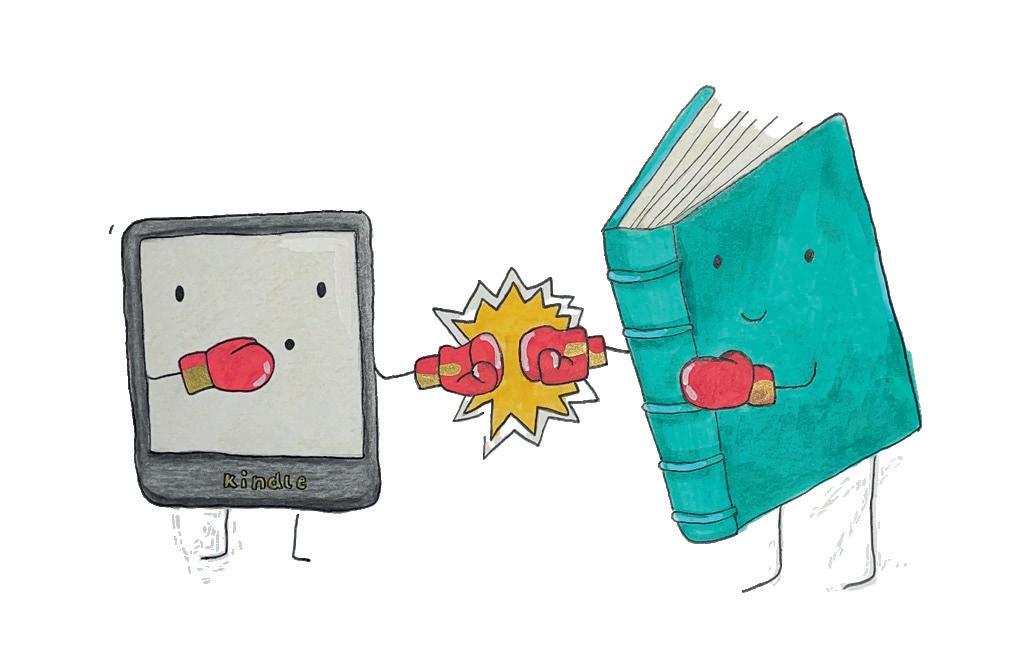
Others feel that Kindles ruin a timehonoured tradition. “Conservation [of print is important,” postgraduate English student Kiera Joyce added. But let’s be real — the Kindle renders print novels obsolete and that’s why people despise it. But why is this the case? Because a Kindle offers everything the humble paperback cannot. Are we just afraid to let go of the outdated system of print media?
Being a Kindle convert hasn’t damaged my love of reading, but rather encouraged it. The Kindle is a constant companion,
thin enough for a coat pocket and perfect for fleeting moments of boredom. Someone mentions an obscure book in conversation? I press the search button and it appears instantly. Pretty much anything out of copyright is free. As much as I like the idea of burying my nose in a yellowing first edition, my back will certainly thank me for refusing to lug around endless course books like a pack horse. I’d like to assert that in my championing of the Kindle, I don’t mean the ones you could play Angry Birds on, go on a shopping spree, or use like an iPod. I’m talking 2012 hardcore greyscale, like the one I found in my mum’s drawer which ignited my obsession with this fantastic device. The basic Kindle’s simplicity forms much of its appeal. Since you can’t mindlessly scroll on TikTok or flick between Instagram and the Books app like on an iPad, it offers the convenience of a tablet without the added distractions. I’m no scientist, but I’m pretty sure its dull display blitzes the eyes far less severely than an iPad’s blue light does. Additionally, not being visually
able to see how far through the book you are is hugely motivating, and a novel’s completion comes as a happy surprise. I’m not sure how I would ever have gotten through Anna Karenina otherwise. Plus, as discovered through a quick Google search, you can get your hands on one for only twenty quid — the original devices being pretty ancient in modern technological terms. There’s no excuse not to give this gateway to endless literature a go. Yes, Kindles are a little blocky and a little harder to romanticise. On one occasion, doing a reading at a dramatic beachside event, my Kindle was about a hundred pages out from the one I needed. I had to play off my rapid button-mashing and desperation to reach the right chapter as a moment of dramatic contemplation. And, yes, I’ll admit that I sometimes miss the bragging rights of a meaty bookshelf. In many ways, Kindles may not be able to replicate the charm of a classic paperback novel, but one thing’s for sure: I certainly don’t miss the paper cuts.
Illustration by Isabella Abbott
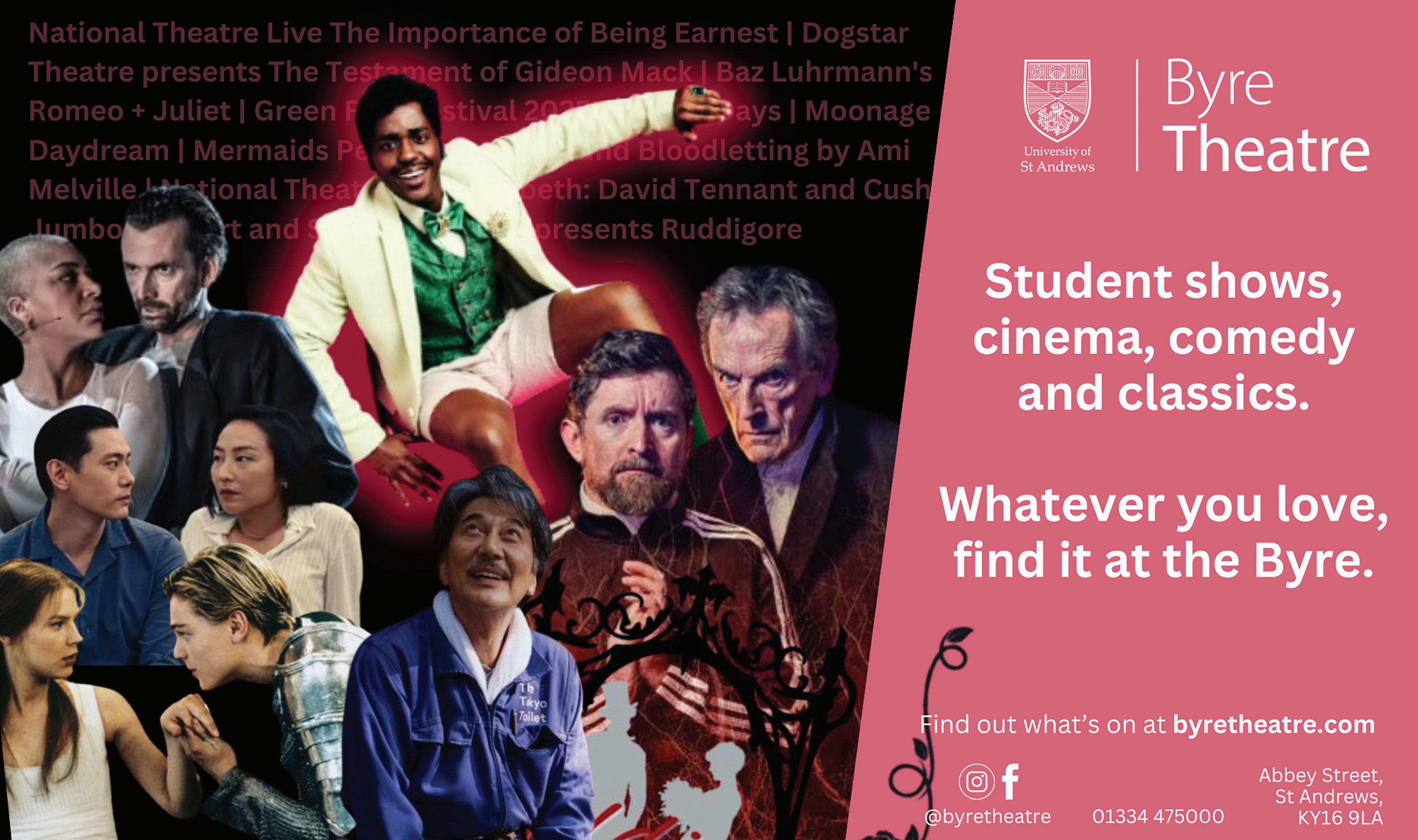
The Anti-Social Generation
The unattainable concept of solitude
MILLY SMITH
Relic Writer
I find that our generation, far more than that of our parents, is increasingly socially awkward. We are social when chatting in warm pub corners with our wellestablished peer groups but purposefully avoid chatting with strangers. Part of this is due to technology: with the help of Google Maps, we no longer need to approach other pedestrians for directions, and with Hinge and Tinder, strangers in bars, cafés, or supermarkets are no longer potential love interests but just more humans that we will never get to know. We opt for self-checkout tills to enjoy a smoother, personless experience, devoid of inane small talk or judgements on one’s purchases. We adore the newfangled coffee shops that provide large iPad screens for ordering because we are overly embarrassed about whether the barista quietly resents the length of our coffee order. We prefer online booking systems for restaurants to allow us to avoid chatting with a stranger on the other end of the phone. I remember my horror when my mother relinquished her unpaid role as my personal secretary, demanding that
now, at the dawn of my second decade, I should make calls to doctors, dentists, and opticians myself. I couldn’t understand why, if I had their number, both them and I wouldn’t prefer a simple text exchange. For a generation already prone to awkwardness and insularity, the arrival of the pandemic was both a blessing and a curse. I recall unadulterated glee at hearing that my GCSE exams would have to be cancelled and that my summer holiday would stretch on and on for months. Yet, the reality was months spent cooped up inside, away from friends, missing teenage rites of passage such as house parties, underage drinking, and festivals. Yet, even once our bounds were finally extended beyond our homes, the two-metre rule stunted physical affection and hindered our masked conversation. Without the mandated hours of sociability enforced by school, it was easy to become introverted, preferring the warm embrace of a duvet and a TV screen to the big, scary, outside world. However, I was always glad of our antidote to this enforced separation: social media. I whiled away hours sitting on FaceTime with friends over those lonely months. It never felt as though we had lost connection with one another or allowed our friendship
to falter, as we were in contact constantly. Yet I worry that social media is not the miracle cure I once believed it to be. A report by Minda Smiley found that Gen
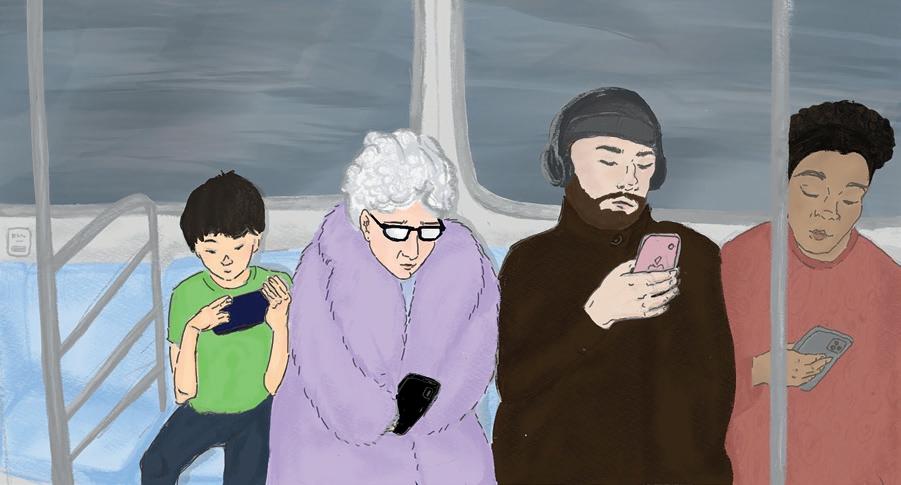
Z, on average, spends three hours and six minutes on social media each day. Yet 43 per cent of these users don’t actually contribute to discussions or exchanging messages, but instead passively view the interactions of others. Social media can act as a plaster on a deeper wound: instead of encouraging young people to get outside, create friendships, or experience new things, it makes a show of connecting to others, even in the absence of real friendship or activity. This is likely why our generation is the loneliest of all, with nineteen per cent of us confessing to feelings of loneliness.
Moreover, this false connectedness provided by social media isn’t just leading to loneliness, but it also means we are never experiencing true solitude. In the spare time provided by long train journeys, walking to and from the shops, or running on the treadmill, we plug in our headphones, open TikTok, or use this time to complete the Wordle. There is constant noise. I find myself incredibly guilty of this: I listen to music when showering, working, reading, working out, or walking. I’ll even replace music with podcasts for particularly boring activities (washing up, tidying, etc.) to ensure that active thinking is kept to a minimum. However, this resistance to ever being fully present only amplifies those negative thoughts of boredom or loneliness that we try to repress. Blocking out the constant racket provided by social media for just a few hours a day, or taking out your headphones during your walk on the beach, can allow you to achieve real solitude and practice the much-needed skill of being fully comfortable in one’s own company.
Illustration by Vera Kaganskaya
The Money Sinkhole of Modern Hollywood
LEO BERENSON Relic Writer
In 2023, Amazon Prime released a show called Citadel. It starred Richard Madden and was partly the brainchild of the Russo brothers… you probably don’t remember it at all. But that’s OK. Lots of shows come and go, even with a little star power behind them. And it wasn’t like this show had much going for it, either. The plot is derivative, action movie rubbish, stuff you might see in a B-list movie from the 80s and not give too much thought to. The difference between Citadel and an 80s B-list movie, however, is that Citadel cost $300 million to make.
To add some extra context, Citadel is six episodes long. This means each episode cost around $50 million to produce. The eighth and final season of Game of Thrones, one of the most popular television series of all time, for comparison, cost $15 million per episode. To the untrained eye, Amazon spending more money on a trite and entirely new IP than HBO spent on a flagship series might seem, for lack of a better phrase, stupid. To the trained eye, however, it is also stupid. So why did they do it, and why does it seem like the rest of Hollywood is following the exact same playbook?
Much like the reason why my Instagram reels are interspersed with videos of AIvoiced Peter and Stewie Griffin discussing
the Quran over footage of Minecraft parkour, the answer is Big Tech. The streaming model, initially a gamble taken by a Scotts Valley DVD company by the name of Netflix, ballooned to epic proportions over the early 2000s and 2010s, sending shockwaves across the industry. Tech businessmen smelled blood and invaded the movie business, looking to cash in on streaming as a new and lucrative market. Hollywood capitulated to them almost without a fight.
Yet there remained a problem: streaming wasn’t profitable. It turns out that giving people a bunch of shows and movies at very little charge while also creating your own original content is not a sustainable business model. Who knew? Thankfully, the tech CEOs had a solution: charge more to subscribers, pay less to the people who made the films and TV shows, and sacrifice art left and right to get government tax write-offs. Struggling actors gasped at their rapidly shrinking residuals, artists gasped as their content was made inaccessible at the drop of a hat, and Hollywood executives gasped at the genius
of the whole thing. The hot air machine of streaming suddenly had plenty to power it. So now we arrive in 2023. Streaming services have become streaming giants, and, to many, their power seems inescapable. Shows like Citadel and films like Red Notice and Ghosted are churned out by Amazon,

merely to keep eyes on screens and wallets at the ready. To the studio heads, it doesn’t really matter whether these films and TV shows are remembered or inspire any sort of meaningful discussion; they’re instead a sort of Hollywood-sized Cocomelon that puts big actors in front of your face and asks you to pay just a little bit of attention until next month’s payment goes through.
We’re a long way from the Golden Age of Hollywood. This is the Streaming Age (alternatively called the Big Tech Age), and, as with the introduction of sound before the Golden Age, streaming technology has fundamentally altered not just which films and shows are made, but how they’re made. The difference today is that the incentives dictating what and how art is made and released have grown deeply perverse. I don’t necessarily believe the entirety of the streaming model is antithetical to making good and capital-I Important art, but it’s clear that something needs to change if Hollywood wants to be more than just a content factory for expensive failures. If Hollywood doesn’t climb out of the money sinkhole, it will drown: art and the world will be worse off for it.
The Masters of the Emotionless
How no feeling makes you feel
ADRIAN HANLON Relic Writer
In an interview with BAFTA, writer/ director Quentin Tarantino compared his relationship to his audience’s emotions to an orchestra. He is the conductor, the audience are his instruments, and his movies — every scene, beat, and shot within them — make the instruments sound different. It is a profoundly difficult thing to do. But at least when Tarantino does it, you know what song the orchestra is playing — you know what emotion you’re supposed to feel. With some writers, however, it is as if the orchestra is largely silent. You catch a few hints and a few spare notes, and from those, you must fill in the gaps. One of the best examples of this is the American short story writer and poet, Raymond Carver. Quite the opposite of Tarantino, Carver’s narratives are of a quiet sort. His style is sharp and minimalist, and his stories centre on the subtle complexities of working-class lives. They are deceivingly simple, and it is that which gives them power. Take the first lines of Fat, a short story
in his 1976 collection Will You Please Be Quiet, Please?: “I am sitting over coffee and cigarettes at my friend Rita’s and I am telling her about it,” it reads. “Here is what I tell her.” Flat and stiff, these lines do not quite possess the quotability of “to be, or not to be.” But for many, that is part of their appeal. His style reflects the subject matter, and his subject matter reflects life. There are unsaid words, unresolved endings, and a sense of underlying tension driving the project forward; but there are no bangs, no shootouts, and the prospect of a grand romantic gesture seems never to have crossed his mind. Even so, far from making them boring, their lack of spectacle makes Carver’s stories addictive in a way that is often confusing. You know you like the story, you know you felt something, but you don’t know why you like it, and you don’t have a clue what it is you just felt. I had the same experience reading Kazuo Ishiguro’s 1989 novel The Remains of the Day. A winner of the Booker Prize, later adapted into a film starring Anthony Hopkins and Emma Thompson, follows the story of
Stevens, the butler at Darlington Hall, as he recalls his decades of service. It is written in the first person, and reads exactly as you would expect an English butler to speak. Yet, despite the formality of its style and the boringness of its subject matter, I was hooked. As I turned page after page, I wondered how Stevens could have taken me in. There must have been something in the novel’s substance to counter the banality of its words. In the end, however, I realised there was nothing. The novel’s substance is incredible, no doubt, but the words did not need to be countered; for it was their very detachedness that made them powerful.
But how is that possible?
My answer here can only be speculation. Who knows what will elicit which emotion in an audience? Emotions are individual and, as such they are variable, but it seems to me that the acclaim of the Carvers and Ishiguros of the world is evidence enough to suggest emotionlessness is a potent weapon in the arsenal of the artist. And I think it has something to do with a piece of acting advice from Michael Caine:

“Men will do anything but cry,” he said. “And so […] when you cry, you must fight the tears. And if you fight the tears, the audience will cry for you.”
In other words, when you restrain emotion in your art, the audience is forced to fill it with their own. As I said at the beginning of the article, some orchestras will only play a few notes — some writers will only give hints — but if you’re paying attention, you’ll be able to fill in the gaps and play the whole song for yourself. And it is in playing for yourself, in projecting your own emotions onto the page, where the power of emotionlessness lies.
Illustration by Magdalena Yiacoumi
Illustration by Marios Diakourtis
Romances with Topping & Co.
Looking for your next read? The Saint and Topping & Co. have come together to save the day. Find below the best romantic stories, all books are available locally in store.
BOOKSELLER PICKS
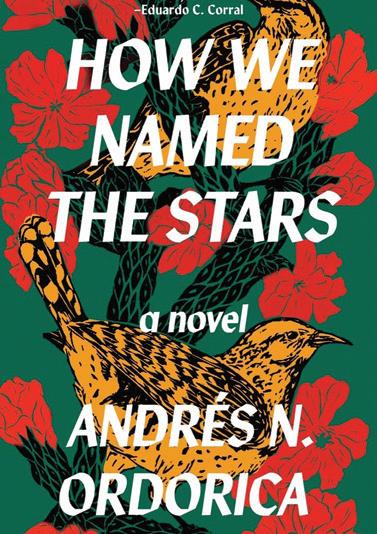

Jen Recommends How We Named the Stars by Andres
N. Odorica
“A beautiful and tender debut, How We Named the Stars follows Daniel and Sam as they meet at university and navigate love, identity, and self-discovery. From the halls of their East Coast campus to Daniel’s ancestral journey to Mexico, their love is tested and shaped by distance, growth, and their pasts. With Odorica’s lyrical prose and deeply drawn characters, this expansive but intimate novel captures the intensity of first love with all of its joys and heartbreaks. This is one of the most genuine and authentic depictions of falling for someone I’ve read in a long time. If you’re looking for a story to get completely wrapped up in, then look no further: love, loss, self-discovery, flatcest… this book has it all!”
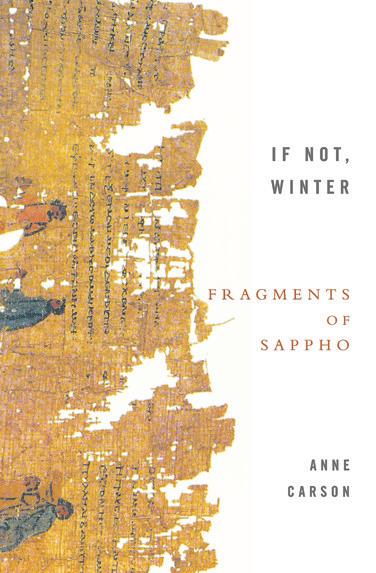
Mia Recommends If Not, Winter by Anne Carson
This Valentine’s Day, delve into in the timeless echoes of love and desire with If Not, Winter, Anne Carson’s enchanting translation of Sappho’s poetry. Alongside the only complete surviving poem, Carson presents Sappho’s other fragments with elegant precision, preserving word order and embracing white space, allowing us to reimagine the missing lines and more intricately understand the depth of her longing. The result is a minimalist yet deeply moving rendition that allows readers to feel the weight of absence and desire. Sappho’s words—“Someone will remember us / I say / even in another time”—remind us of love’s enduring power, still resonant two and a half millennia after her death. Carson’s notes on her translation are illuminating and accessible, making this a perfect read for both poetry lovers and newcomers. And what better way to celebrate than to immerse into a poetic mythology of the goddess of love herself: Aphrodite.
STAFF PICK
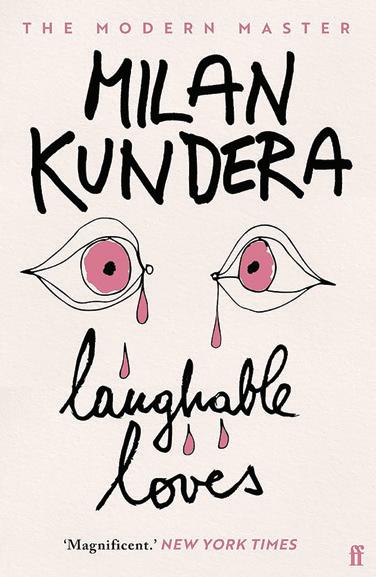
Maria Recommends Laughable Loves by Milan
Kundera
There is something so beautiful about lying in bed on Valentine’s Day, with your head on a loved one’s shoulder, reading about how ridiculous love can be. Although, I’m not talking about the smitten, head-over-heels kind of ridiculous. To read the seven short stories in Laughable Loves by Milan Kundera is to follow deeply flawed characters in their hypocrisies and paradoxes. It is to explore the deception and vulgarity in some loves. What is unbelievable though, is that, when finishing each of these often profoundly unsettling stories, your lips still cannot help but curl into a smile.
Mac Miller’s Balloonerism Reviewed
The Pittsburgh troubadour turns his consternation catchy
LAURENCE HEPWORTH
Relic Writer
“I’m hopin’ not to join the 27 Club,” raps Mac Miller on GO:OD AM. The Pittsburgh native would indeed narrowly avoid such a fate — but only by overdosing one year before he could claim membership. Balloonerism marks his second posthumous release since then, recorded way back in 2014 around the time of his Faces mixtape. The album departs from the breathless frat rap of Miller’s early work, but the desire to label this LP a definitive ‘stepping stone’ between the front and back tranches of his catalogue should be avoided. Yes, the simian chest-beating of Blue Slide Park does not appear, but Miller had already experimented with late-night vibes in Watching Movies with the Sound Off, and this album’s tracks too sit low in their chair. Where GO:OD AM was breezy and muscular, Balloonerism is anxious and louche. What’s therefore surprising is how Miller can make these negative emotions sound so… good. In ‘Do You Have A Destination?’, the rapper, now “rich as f*** and miserable,” repeatedly questions his life’s direction, but the bouncy backbeat keeps the song outwardly bright. Meanwhile, the dusty riff in ‘Stoned’ will have you rocking along to the tale of a girl who cries all alone. This conflict can exist because of Miller’s tight sense of control: the gloom of the lyrics is never allowed to bleed into the beat. It’s only much later in the album, come ‘Excelsior’ through ‘Manakins’, that a sense of dread finally infects the melody. This makes these songs comparatively more challenging, a move that will be equally lauded (for its artistry) and criticised (for its artistry, which entails songs that are not easy hits).
But as you delve further into Balloonerism, it’s the unease that creeps into ever-sharper focus, even when it bangs up against deliciously pinballing grooves (like on ‘5 Dollar Pony Rides’). You move through a mire of dour images (“they found my body somewhere in the sewer,” and, “all roads lead to the same confusion,” in ‘Mrs. Deborah Downer’). It now seems painfully obvious, as is so often the case in retrospect, that Miller was hurting badly. But even more tragic are the slim glimmers of hope: “cleaned myself up, now would you be my friend?” Miller’s lyricism is often freerange, but his unifying production gives a sense of cohesion that such scattergun lyrics shouldn’t enjoy.
The rapper knows exactly when to stick and when to twist, and thus effects musical changes judiciously. Nothing of this morose imagery should suggest that Miller isn’t enjoying himself; we see his playfulness in the tambourine-led opening track and again in a knock-knock joke told over the intro to ‘Rick’s Piano’. There’s even a teaspoon-draggingon-crockery soundbite in ‘5 Dollar Pony Rides’ that I didn’t know I needed. It doesn’t all land, however: the slowed drum beats at the end of ‘Stoned’ and the vocal distortions sound like the additives of someone toying with a new effects pad. More generally, the LP’s instrumentation swerves from euphoric (the feast of harmonies in ‘DJ’s Chord Organ’) to cloudy (the muffled pulsing in ‘Stoned’), holding up a clever mirror to Miller’s drug-taking itself.
There is obvious poignancy in that this release marks (for now, at least) the last output from a dead artist: you’ll wince at the line, “What does death feel like?”, and yet, there is no desire to cash in on any sentimentality. This is made clear by where the album ends: not with the refrain of “the best is yet to come” from ‘Rick’s Piano’, as would have been so cloyingly
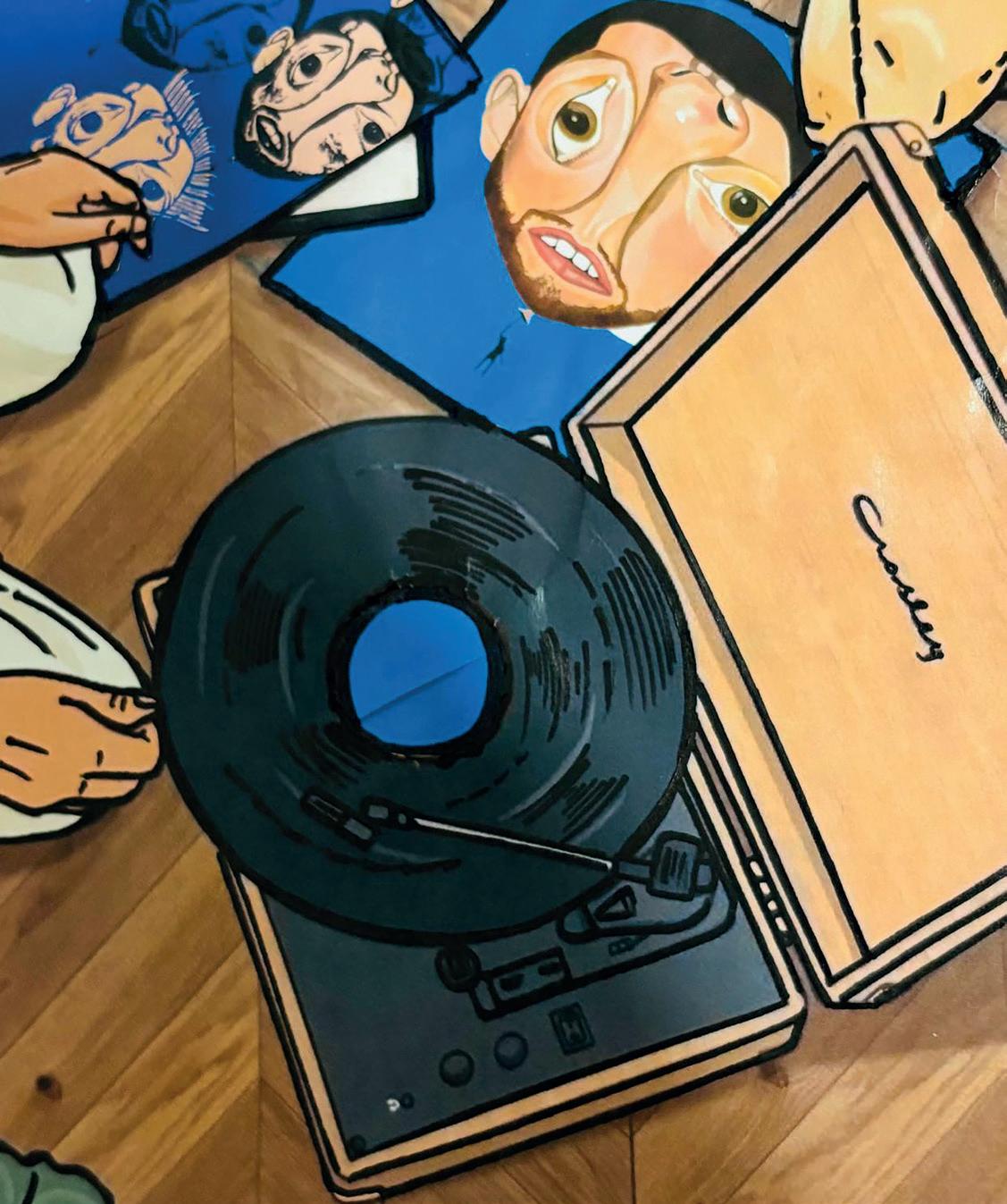
easy, but rather by veering wildly into ten minutes of unsettling ambient music, almost mocking anyone who might’ve been starting to well up. Balloonerism thus shouldn’t be viewed any differently for its posthumous nature — it’s rather one more brilliant, gloomy piece in the Mac Miller puzzle.
Illustration by Janya Malkani
Events

EDITOR: OLGA ALONSO BLANCO
A Visit to Wardlaw’s Say No! Exhibition
Saying
Yes! to meaningful change
JONATHAN STOCK Events Writer
Is there a better way to spend an afternoon than visiting a museum? The Wardlaw Museum boasts an impressive collection of relics as the University’s past is laid out before you. The new exhibition Say No!, however, cuts through the ephemera, forcing us to face the realities of the UK’s residual culture of prejudice. This provocative collection explores the complicated realities of racism, domestic violence, queerphobia, and sex work, amongst many others aspects of contemporary British life.
On entering you are faced with a collection of sculptures. An Amazon warrior and a witch by Ellen Lesperance and a piece entitled My Lady with the Mekle Lippis by Josie Ko, satirise the statues of colonisers and slave traders that populate the streets of our most ‘forward-thinking’ cities. Should nostalgia for a sordid past ever be glorified? This is one of the many questions that Say No! forces its visitors to consider.
Behind these striking sculptures, Sweatmother’s short film Pissed Off
Trannies: ZAP1 shows a protest held outside the Equalities and Human Rights commission in 2022. During the protest trans activists decorated the doorstep of the EHRC, the organisation responsible for promoting and enforcing equality and non-discrimination laws, with bottles filled with urine. We are reminded of the
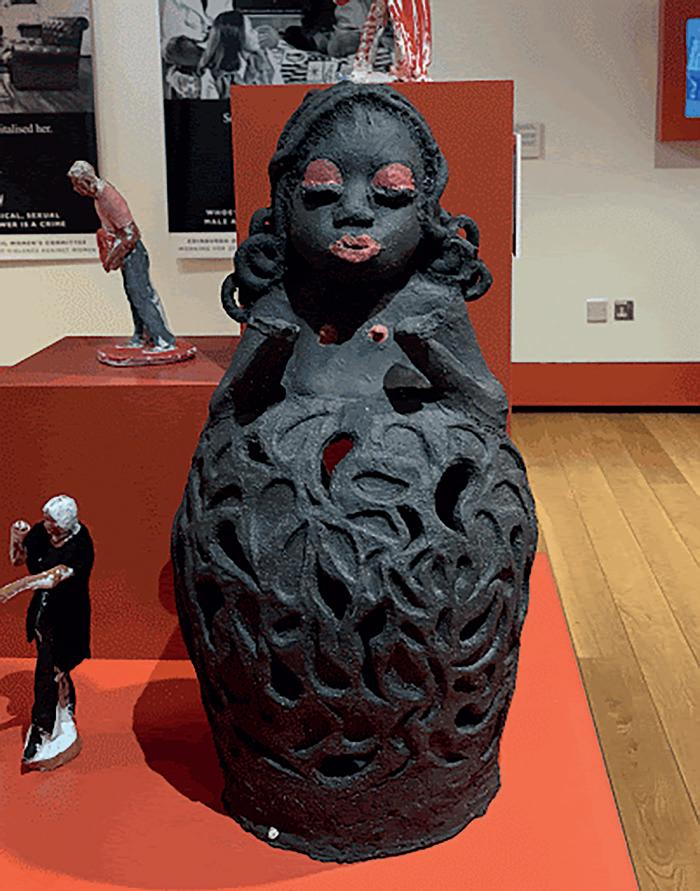
Something Different
role of art and performance in the fight for equality. What is palatable is not always right. These trans activists are fighting for their right of recognition: their right to exist.
Matt Sheard, one of the organisers of Say No!, explained the challenges the team faced arranging the exhibition. With such a sensitive subject matter, the organisers took care to “make sure the right language was used” and that “the right perspectives and points of view were put across.” Their sensitivity and effort paid off, and can be seen in every corner of this beautifully modern and expertly curated collection.
I found A Black Footprint is a Beautiful Thing by Alberta Whittle particularly moving. The feature dominates a full wall of the room, exploring the legacies of colonialism through an exploration of the shipworm, the mollusc that now consumes the tall ships sent to colonise the Caribbean. The piece is about survival in the diaspora, about courage in the face of all encompassing erasure. Say No! celebrates those who have stood together against hate and ignorance, as time rages, their identity remains strong or, as Whittle puts it, “resolute
against a white background.” The film is a captivating mix of image and written word. “How many are suffocating under the rot of plaster and eugenics?” the screen reads. Whittle’s film asks a pertinent question. In a university that can feel so cut off from the rest of the world, Say No! reconnects us to the work being done on our doorstep to make society a fair and kind environment to all. This exhibition showcases the capabilities of protest, from the mere act of saying no to organised demonstration. There is power in your refusal.
One can only hope that there will be more exhibitions like Say No! in St Andrews, reminding us that sometimes, the bubble needs bursting. The exhibition runs from Saturday 25 January to Sunday 11 May 2025. With events for both individuals and families, from film-screenings and weaving workshops to book-clubs, there are so many ways to educate ourselves, spread awareness, and get involved.
Inklight’s Open Mic Night: A Perfect Sunday Reset
LIZZIE ROSENMAN Events Writer
Sandy’s Bar is the versatile area in the Union, frequently used by different societies for various purposes throughout the week. Whether it be improv, karaoke, or acting as a regular bar for Sinners, the comfortable couches and stage remain a constant. On 2 February, Inklight turned Sandy’s Bar into a space where any and all were welcomed to share their writing. Inklight is the Creative Writing Society at St Andrews, and they hosted an open mic in Sandy’s Bar, which doubled as their AGM for both members and strangers alike. Inklight labels themselves as “a home for the writers, the readers, and the dreamers”. The society offers creative writing workshops, curates a journal, hosts socials for bonding, and occasionally holds open mics, which can be found on their
Instagram or Out n’ About. As someone who loves to hear other people’s original work but not share my own, it seemed like the perfect spot on a lazy Sunday evening. Walking into the Union alone can be an intimidating task on a Wednesday or a themed night; however, I was not expecting to be overwhelmed on a Sunday after the first week of classes. Outside of Sandy’s Bar were crowds of people who seemed to be gathered for the Main Bar’s ‘Pint O’Clock’ event, where pints were discounted and drinks were flowing. After manoeuvring through the unexpected crowd, opening the door to Sandy’s was an abrupt change. The environment was intimate, with listeners perched on their chairs or couches, intently focusing on the girl on stage: she was reading an original piece off of her phone. There were far fewer attendees at the open mic compared to Pint O’Clock, but it was an entirely
appropriate audience for someone to share a piece of writing. The atmosphere was encouraging and you could hear a pin drop as a writer presented their work. Once they finished, there was a light round of applause coupled up with praise from neighbouring audience members.
Attendees were encouraged to share anything: a poem, a short story, or maybe just a sentence. What you shared could be — and most often was — original, but it did not have to be; it could’ve been any piece of writing that resonated with you, whether that was a song lyric or a Shakespearean monologue. The performance could’ve been as formal or informal as you liked, and it truly felt like a welcoming space to present a piece of writing, especially if you were nervous to begin. Although I, and many other people in the room, were not brave enough to share our own writing, perhaps attending a few more
open mics might change my mind. The event was meant to last from 7pm to 9pm but it ended early due to a lack of those who felt compelled to take the stage. If you plan on attending the event in the future, I would recommend getting there on the earlier side because the event ends once there is no writing left to share. However, since Pint O’Clock was just outside, attendees wrapped up the night and continued conversations about the performances over a cheap pint. That pint was the finishing touch that completed the ideal Sunday night.
Photo by Jonathan Stock
Barn Bash 2025: Bigger and Better
A night of cowboy hats, denim jeans, and a mechanical bull
ALEX LE SAGE
Puzzles Editor
Saturday 1 February saw the return of a St Andrews event staple, Barn Bash. Walking down South Street one might think they had teleported to the Wild West, as a flurry of students dressed in attire befitting of an old-time saloon descended upon Blackfriars Chapel, awaiting their transporation to Falside Mill for an afternoon of drinking, dancing, and living it up like John Wayne.
Leading up to the event, wristband collection began on Wednesday, where goody bags, containing a peculiar-looking party recovery pill, were handed out. Indeed, the capsule smelled like a sewer and tasted even worse but served as a fun albeit strange way to start the occasion.
Leading up to the main event was ironically its lead-up event: Before We Bash, held at The Vic on Friday 31 January and offered non-stop music, alongside four different DJs. It was loud, vivacious, and the ideal place for students to forget about the worries of their classes and enter the non-stop carousing of Barn Bash weekend.
Despite, I expect, numerous hangovers the following morning, students dutifully lined up to board the buses scheduled to take them to Falside Mill. Entering the venue, which was reminiscent of a barn in design, one was confronted with a buzzing energy that permeated the four main areas — an entrance with a bar, the main dance floor, and two outdoor spaces — one with the infamous mechanical bull, and one with food offerings: churros, tacos, and burgers.
With a live band, the dance floor offered a selection of country and pop hits, drawing everyone in to dance and let loose throughout the afternoon, including an energetic but chaotic ceilidh. However, for many people, the real attraction was just outside as a large queue was forming for a chance to ride the legendary bucking beast. Waiting in line was almost as exciting as riding the creature itself
from the outdoor area to the dance floor.
This was met by a transition from country twang to pop hits and a corresponding increase in manic drunk dancing and the belting out of lyrics to Katy Perry songs.
At 7pm, everyone hurriedly rushed outside for the main surprise of the night — the event’s first-ever firework show. Lasting around two minutes, it was charmingly
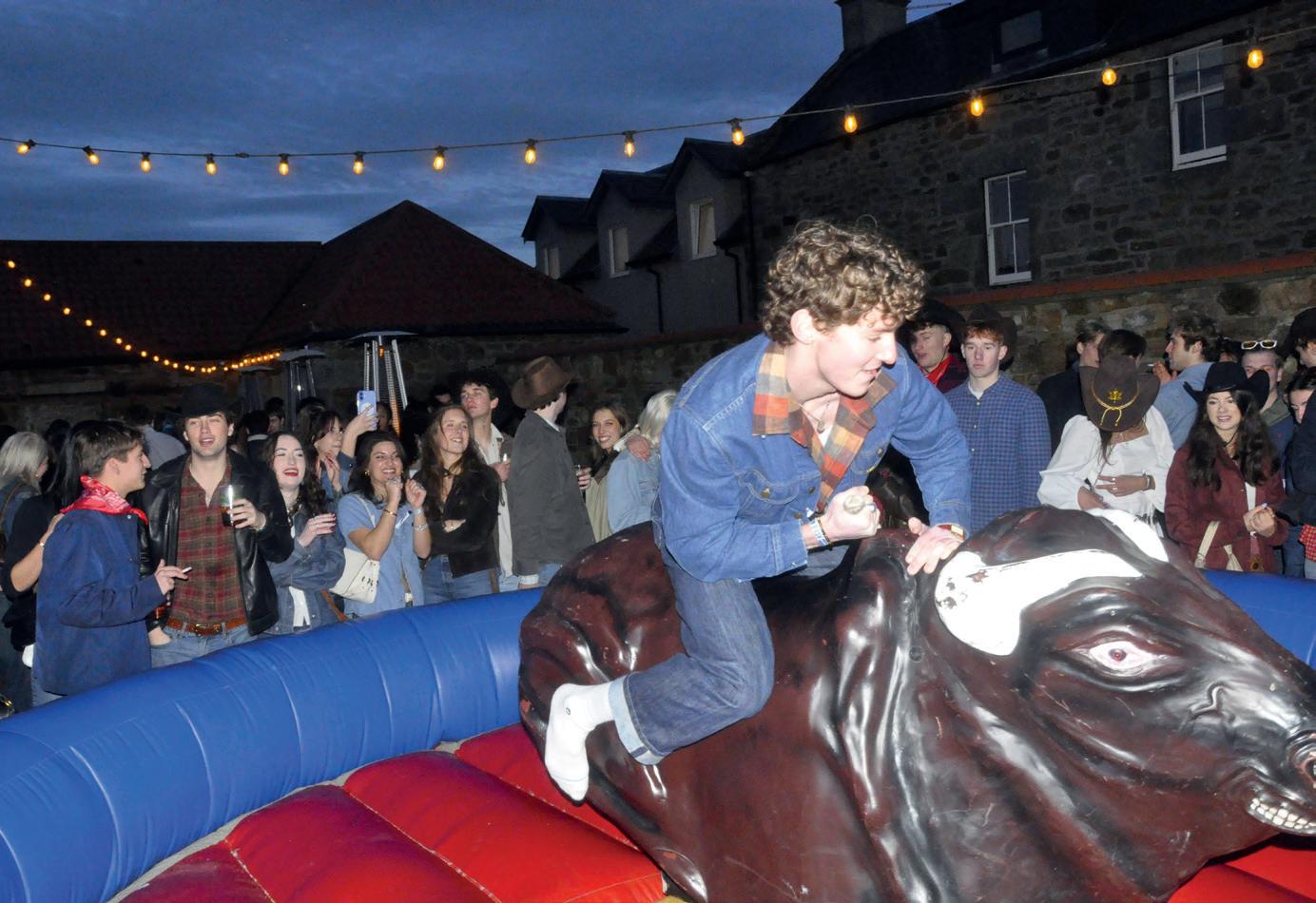
as one watched other brave students try (and mostly fail) to hold on to the menacing machine. Every success was met with cheering from the crowd of spectators, and every fall was met with winces and laughs.
Yet Scottish weather is a beast nobody can defeat, and as the day grew colder and darker, more and more students migrated
quaint and succeeded in uniting everyone in a moment of collective awe. Upon returning to the dancefloor, DJ replaced the live band and continued for the rest of the evening.
As the Bash drew to a close, buses arrived to carry attendees home. While bus arrangements to the action were punctual and efficient — a strong improvement
Ones to Watch: Events of the Week
since last year — return transport was slightly disorganised, leaving an otherwise outstanding event with a somewhat frustrating conclusion. Admittedly, this was as much a result of the inebriated attendees as it was of the bus schedule.
Barn Bash is not just an occasion; it serves as a way to bring the St Andrews community together in a uniquely Texaninspired way. As the first major event of the Candlemas semester, it injects life into the town. The evening before the event, I met with the Barn Bash Director, Frederick Strange. He explained the goals of Barn Bash as “uniting the town” whilst “trying to make a weekend of experiences for those keen for a good time.” Additionally, the proceeds of Barn Bash go towards Help for Heroes, a charity organization which supports British veterans. The organisers maintain a longstanding relationship with the cause, having previously raised over £20,000 for the charity and meeting with veterans last semester.
Like most major events at St Andrews, the cost of attendance is significant, with tickets priced at £45-55 — a £5 increase from last year — plus an additional £8 entry fee for Friday night at the Vic. This may lead some to question whether the event is worth the money. However, with proceeds going to charity and the event delivering non-stop excitement, Barn Bash proves itself to be worth every pound. As Strange explained, the committee “tried to make it bigger and better than ever before.” At this, they certainly succeeded.
Scavenge through your wardrobe to find your best red or pink formal attire for an annual Valentine’s day favourite: Galentine’s Ball. Presented by EmpowHER, the event strives to foster a comfortable, woman-centred space for an evening of fun and friendship. It’s the perfect setting to take out your closest girlfriends. This year’s Ball will take place at the Rusack’s Bridge restaurant and gallery. Your ticket includes a free drink, goody bag, raffle ticket, and homemade sweets.
For all those interested in embracing medieval history, join the Historical Reenactment Society for an afternoon of medieval dancing and music. From sword fighting to calligraphy, the Shire of Caer Caledon organises a diverse range of events. Hosted in Club 601, tickets are £5 for all members and £7 for non-members. Although not required, historical clothing is encouraged — so if you’ve remembered to pack your surcoat or cotehardie, you’re in luck!
This Macedonian documentary drama follows the life of a wild beekeeper in the isolated village Bekirlija. The critically-acclaimed feature intends to spark conversation on a range of environmental themes, such as climate change, consumerism, and biodiversity. St Andrews Bee Society embraces this, organising a film screening, followed by an engaging Q&A. This event seeks to bring together all cinephiles and bee enthusiasts in Sallie’s Quad from 7pm-9pm.
St Andrews MENA Society is dedicated to celebrating Middle Eastern and North African culture in our small town and beyond. For their third annual MENA Ball, they are introducing a new theme: Hollywood on the Nile. It strives to highlight Egyptian cinema within the Arab film industry. What better way to embrace this dazzling theme than with an evening of live music, dancing, and authentic cuisine? Make your way to Hotel du Vin on Thursday evening to find out.
Photo by Alden Arnold

BHANI KAUR Sci-Tech Writer
A single bottle of The Macallan 1926 recently fetched £2.1 million at auction, but even the world’s most valuable whiskies are not immune to counterfeiters. As rare Scotch prices soar into the millions, scientists at the University of St Andrews have turned to quantum physics to authenticate what’s inside these prized bottles — using Raman spectroscopy.
But how does light reveal what’s inside a sealed bottle? Imagine throwing thousands of tiny rubber balls at a piano keyboard. Each key they hit would produce a unique note — some high, some low. Now picture a light beam doing something similar when it hits a liquid. The light particles, called photons, bounce off the molecules in the whisky like those rubber balls, and each molecule plays its own unique ‘note’ by changing the light’s colour ever so slightly.
Just as every song has a unique combination of musical notes, every whisky creates a special pattern of scattered light. A genuine 25-year-old Macallan will ‘play’ a very different light symphony than a counterfeit trying to mimic it. The scientists’ laser device acts like a music recorder,
URQUHART DYCE Sci-Tech Writer
When one thinks about global efforts to tackle climate change, the Paris Agreement springs to mind — an accord that describes plans for global efforts to tackle climate change through regulations and a wider goal to keep global surface temperature below 2°C. This has largely failed, and with the US continuously leaving and rejoining the agreement, confidence in these farreaching reforms has dwindled. When the International Maritime Organisation (IMO) introduced regulations in 2020 to limit the amount of high-sulphur fuels being used to power international shipping vessels, most would assume that these measures would benefit to everyone. However, it appears that some climate solutions may end up being more harmful
EDITOR: ANA-LUCIA CHALMERS
A Toast to Authenticity The proof is in the lighting
capturing these molecular melodies to reveal whether a whisky is authentic or fake — all without ever opening the bottle.
By detecting these tiny changes in the scattered light — some as small as one part in a million — scientists can map out the molecular structures that were impossible to study a century ago. This phenomenon, discovered by physicist. Chandrasekhara Venkata Raman in work that earned him the 1930 Nobel Prize, has become fundamental to modern chemical analysis.
Modern Raman devices use sensitive digital cameras and filters enabling portable kits to identify substances from pharmaceutical quality control to fine art conservation. However, there lies an issue with overcoming the challenge of scanning through glass. Just as the thick wall will muffle the music, the glass bottle’s molecular ‘notes’ can overwhelm the subtle ‘melody’ of the whisky inside. Dr Bruce, lead researcher at the University of St Andrews, explains their innovative solution to this problem: “We shape the laser light into a ring on the glass bottle, and only collect light that comes back through the dark core of the ring. This way the light that comes back has to have come from within the bottle, rather than from the glass surface.” Essentially, a little hole is drilled into the wall so that we can press our
ears against it and discern the fine melody.
The University of St Andrews’ team has built a portable Raman scanner to probe liquor samples. Their device shines an infrared laser at a droplet of the drink and analyses the scattered light using a compact spectrometer that fits in a small suitcase.
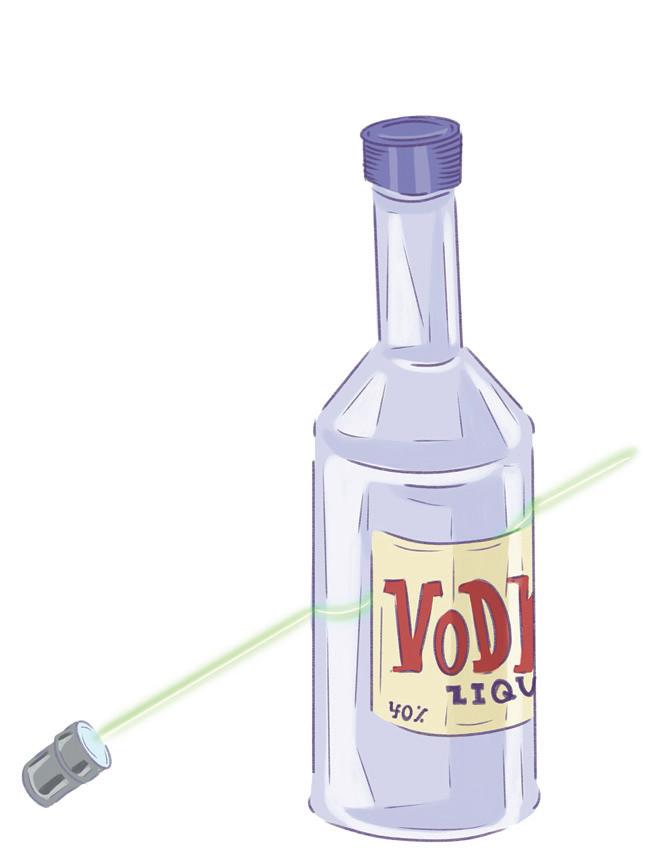
researchers measured Raman spectra for many popular whisky brands, as well as vodka, rum, and other spirits. Each showed a distinct pattern of peaks corresponding to different molecules present. They then analysed spectra for confirmed fake alcohols supplied by trading standards teams and found obvious differences from the genuine samples. The portable system can rapidly check a suspect bottle at the point of sale and immediately flag any fake drinks before they
The Price of Progress
than the issues they were meant to address.
When shipping vessels were forced to use lower-sulphur fuels, the amount of sulphur dioxide (SO₂) in the atmosphere decreased. This sulphur had been playing a significant role in reflecting sunlight away from the Earth’s surface, acting as a form of natural cooling. Professor Piers Forster and Dr Zeke Hausfather wrote an article for Carbon Brief blaming the reduction in this cooling effect for a rise in surface temperatures by around 0.05°C, aggravating the warming that climate solutions aim to reverse. This example emphasises a key point: the solutions we try to implement, however beneficial and environmentally friendly we believe them to be, do not always yield predictable and positive results.
Sulphur regulation is only one example of the knock-on effects of climate mitigation strategies. Another case of this is biofuels,
the environmental saviour of the internal combustion engine. Initially heralded as a clean and less damaging alternative to fossil fuels, the holistic environmental impact of biofuels is a murky affair. Most ingredients in biodiesel, a form of fuel similar in chemical makeup to fossil fuel-derived diesel, have their own issues. Soybean production is responsible for widespread deforestation and displacement of Indigenous people, especially in Brazil, which, along with the US and Argentina, produces 80 per cent of the world’s soybeans. The destruction of forests, which have been growing for millions of years, trivialises their store of carbon dioxide. This again counteracts some of the benefits of the reduced emissions which biofuels provide. Another impact of this production, which is set to increase over the coming years, is ecological damage. The risk of soil depletion, loss of biodiversity, and water stress now
reach consumers. “The typical measurement time is around 5-10 seconds per bottle,” notes Dr Bruce, a significant improvement that enables quick testing without damaging stock or requiring lab analysis. The team is also examining options for further miniaturising the device so it can be easily used by retail staff and trading standards officers.
Raman spectroscopy provides a promising way to tackle alcohol counterfeiting. The approach is fast, non-destructive and sensitive to subtle chemical differences found between genuine and fake drinks.
Beyond the back bar shelves, Raman techniques have proven equally effective in identifying fake pharmaceuticals and tackling art forgery while physicists continue to advance the technology. With the global market for rare whiskies reaching record heights, this light-based authentication technology isn’t just protecting consumers and distillers — it is helping preserve the legacy of Scotland’s most prestigious export. From auction houses to airport duty-free shops, these portable devices could soon become as essential to the whisky trade as the master distiller’s nose — ensuring that what’s in the bottle is as genuine as its price tag.
Illustration by Hannah Beggerow
plague once lush and verdant jungles. Much of the land used for biofuel crop production is in developing countries where food insecurity is a real issue, and the growing demand for these ‘eco-friendly’ fuels raises the prices of crops which would otherwise feed the population of these countries. Rather than solving these issues, the solutions we’ve implemented in the past few years have been ‘quick fixes’, of which the full extent of their effects haven’t been considered. We must recognise that the system we seek to fix is a complex one, and we must adapt our strategies as best we can to deal with its unpredictability. Stopping climate change is the most important challenge we face as a society today, but it is not, by any-means-necessary, a mission, and we must also preserve the natural wonder that Earth has to offer.
89 Seconds to Midnight
How the Doomsday Clock is predicting the apocalypse
MATTEO VERATELLI Sci-Tech Writer
89 seconds. Only 89 seconds to the end of the world; that is what the Doomsday Clock is telling us. On 28 January, scientists from the Bulletin of the Atomic Scientists shook the world with an ominous announcement: the hands of the Doomsday Clock — the clock created to tell us how close we are to the end of the world — have moved closer to midnight. Never in history has mankind’s annihilation been so imminent. Is it the end of the world, then? Luckily no, or at least, definitely not in just a minute and a half. But then what is this baleful time-teller saying? Its concept traces back to an international group of researchers known as the Chicago Atomic Scientists, who, after witnessing the destruction that the atomic bombs had caused during World War II, decided to come together and create the Bulletin. Their goal being to inform and warn people about the risk of nuclear
warfare and a possible global catastrophe.
The group was composed of some of the greatest minds of the time, such as Albert Einstein, J. Robert Oppenheimer, the Scottish Nobel-laureate John Boyd Orr, and many members of the Manhattan Project. In 1947, these “scientific men” — as member of the Bulletin described themselves — came up with a physical metaphor to represent the likelihood of a human-made global catastrophe: the Doomsday Clock. Bulletin co-founder and Russian-born American biophysicist Eugene Rabinowitch described the Clock as depicting “basic changes in the level of continuous danger in which mankind lives in the nuclear age.”
Its countdown towards natural destruction calls for an urgent intervention in order to be stopped.
Initially, midnight symbolised nuclear extinction, but, with time, other factors, like the accelerating aggravation of climate change, the rapid development of artificial intelligence, and bioterrorism, have also been included in the doomy judgement.
With this in mind, every January, members of the Bulletin’s Science and Security Board gather to discuss the technological dangers of the modern era, accordingly shifting the clock’s hands further or nearer to the end. The clock was originally set at seven minutes to midnight and during its 78year history, it has been moved backwards eight times and forward eighteen times. It first dropped during the Cold War and the following arms race, then rose after the fall of the Berlin wall, peaking at a record seventeen minutes in 1991 with the reduction treaty on nuclear weapons signed by US President George H. W. Bush and Soviet leader Mikhail Gorbachev.
Worryingly, the clock has been running fast over the past decade. North Korea’s nuclear tests, terrorist attacks, and the Covid-19 pandemic have all been alarming events that have led scientists to shift the clock further forward — and this trend does not look like it is coming to an end anytime soon.
Indeed, this year saw a historical negative record of just 89 seconds to
Hug-ology
midnight. Bulletin scientists, together with the President of the Royal Society and the nine Nobel laureates that form the Board of Sponsors, have based their decision on the perpetuation of conflicts in Ukraine and the Middle East, the second withdrawal of the US from the Paris Agreement on climate change, and the spread of misinformation at the hands of increasingly more realistic artificial intelligence.
“In setting the Clock one second closer to midnight, we send a stark signal,” wrote the Bulletin’s editor John Mecklin. Their goal is clear: to make fellow scientists aware of the relationship between their work and world politics and to spur global leaders to enter “good-faith discussions about the global threats outlined” and “take that first step without delay.”
With only 89 seconds left on the doomsday clock, it’s unclear whether this plea will again fall on deaf ears, or if this time it will finally be the spark for a brighter future.
Why you should hug more often (and not just on Valentine’s Day)
ALICIA SVENSSON Sci-Tech Writer
Virginia Satir, the mother of family therapy, famously stated, “We need four hugs a day for survival. We need eight hugs a day for maintenance. We need twelve hugs a day for growth.” Satir observed the psychological effects of a deeper chemical change in our bodies caused by hugs. Playing behind the scenes are the ‘love hormones’ oxytocin and endorphins, which are shown to not only reduce stress and anxiety but also make us trust more willingly.
Oxytocin is a molecule that is primarily produced in the hypothalamus and released through the pituitary gland into the bloodstream. While in the blood, it travels to different parts of the body. The hypothalamus also directly transports the molecule into the brain, where it can target several regions, including the amygdala. The amygdala’s main function is to signal fear to the brain. Standing in the amygdala’s way is oxytocin, which reduces its signal, resulting in fear responses. This whole process reduces stress and anxiety levels, as
well as increases trust. Another side-effect is that we become oblivious to negative social cues. This is why we so rarely see ‘red flags’ in people we like, and why love is sometimes considered ‘blind’. Oxytocin can also be connected to stress responses. Stressors

chased by a bear, or running late to your lecture — activate the oxytocin neurons. These are then responsible for regulating your body’s responses, like lowering your heart rate and blood pressure. In mice and other animals with reduced oxytocin levels, there are higher anxiety levels and reduced parental behaviour. In humans, the levels of cortisol and norepinephrine (stress hormones) have been seen to decrease with added oxytocin. This circles back to the fear responses connected to the amygdala and feeling safe. However, it is not only oxytocin that causes that warm and fuzzy feeling. Hugging stimulates a certain set of nerves that only respond to light and gentle touch, in comparison to ‘normal’ nerves that report back a wide range of information about touch and pain. These nerves signal to the brain to release oxytocin and endorphins. The latter are the body’s natural pain-relievers and have similar effects to morphine while being much more effective and less destructively addictive. They block pain signals to our brain, and, as a result, we feel more calm and relaxed.
Physical pain and psychological pain are both treated in the same area of the brain, which makes it hard for us to differentiate between the two. This explains why we get comforted by physical touch when we are sad. Endorphins are also connected to the brain’s reward centre, which is why we get heightened self-esteem from hugs, and often end up wanting more. Oxytocin and endorphins amplify each other and it is important to note that these hormones are heavily dependent on context: they have a positive effect when we want a hug, but, if not, then the opposite happens. If this scientific breakdown hasn’t convinced you to hug your loved ones, then let Valentine’s Day be the reason you do. The effects of a hug can help us through bear chases or busy university life. From reducing stress to developing deeper relationships with people, hugs can improve not just your mental health but also your physical one. As to how many we need a day? I would say as many as possible.
Illustration by Hannah Beggerow
SASHA WOLF Sport Writer

EDITOR: MAHALEY WISE
A Dummy’s Guide to Clay Pigeon
If you were unfamiliar with the sport of clay pigeon shooting before arriving at St Andrews, it likely didn’t take long for your curiosity to pique. Similarly, if you spent the first few weeks, or even months, drawing a blank when someone mentioned the Clay Pigeon Shooting Club, you’re not alone. Maybe you attended the club’s giveit-a-go session last September or chatted to club members during Freshers Fayre. Or maybe you still don’t know exactly what clay pigeons are. If that’s the case, let this article be your guide to everything clay pigeon-related. I had the chance to speak to club members about the club’s history, their popular give-it-a-go session first semester, and everything in between. First, allow me to provide some background information on the sport. Pigeon shooting for sport originated in Europe in the eighteenth century. Clay pigeons replaced live birds in the late nineteenth century, and clay pigeon shooting was born. The sport was played as a source of entertainment and a way for players to practice their shooting skills before hunting real birds. The rules of the game are quite simple. Circular moulds of baked clay called clay pigeons are released into the air by a machine called a trap. The shooter then uses a shotgun to try and shoot and break the clay pigeon in mid-air. It didn’t take long for our university to become hooked.
As club president Xander Sparkes informed me, “The St Andrews Clay Pigeon Shooting Club was founded in 1854 when [the club] decided that it would be easier to
use clay targets rather than actual pigeons released from traps.” He added that “keeping all of the birds was rather expensive, and apparently a bit of a faff. We haven’t looked back since! Clays are a bit easier to tidy up!”
Once this change was implemented, it is believed that Henry Lykes-Richard, elected in 1856, became the club’s first president.
The Clay Pigeon Shooting Club is welcoming to all skill levels and shots. I spoke to first-year member Saylor Waddell about the club’s popular give-it-ago session during the Martinmas semester. “The giveit-a-go was split over three different days and had around 150 people,” Waddell observed. “You shot 10 cartridges at the give-it-ago, but usually if you are shooting regularly it’s 25. We learned about safety, proper shooting form, and how to handle a gun.”
reflected. Freshers representative Ollie Edwards described these practices as “a good chance to escape from our small town,” and added that the club provides “one of the most affordable clay shooting opportunities in all of the UK.” Lessons are priced at £25. Additionally, if the club has provided you with a license holder, you can shoot for just £15.
When I asked Waddell about the club’s plans for the future, she explained that,
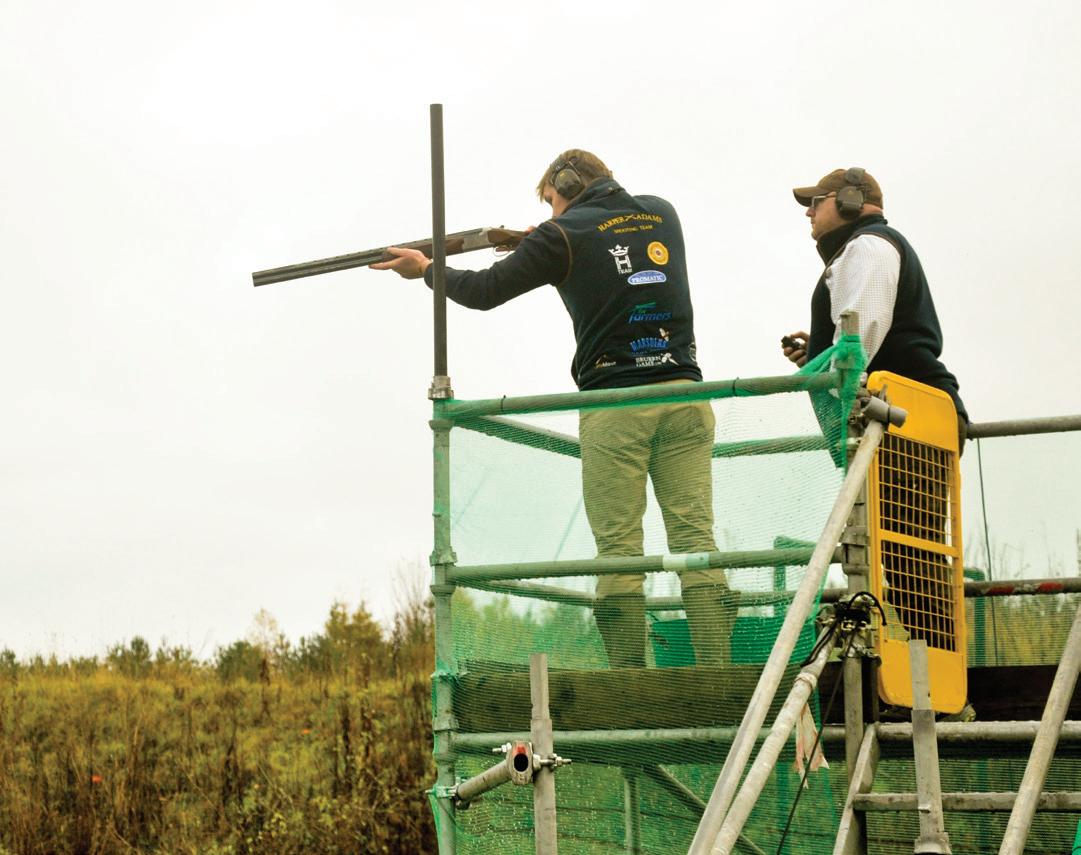
Waddell compared the give-it-a-go to the team’s weekly practices at The Scottish Clay Shooting Center in Leuchars, just ten minutes from St Andrews. “[Practices] are usually the same setup as a give-it-a-go but with less people,” Waddell explained. Paying members can attend either the morning or evening practice on Wednesdays. “Right after the give-it-a-go I went straight to shooting, without a lesson, and found it super easy to pick up and enjoy,” Waddell
Football v Football
Over break, as I sat on my couch, my Ravens jersey on and the NFL Sunday Ticket playing on the television, a silly State Farm commercial played. Patrick Mahomes and Jake from State Farm watched as Dani from Ted Lasso “bundled” the soccer ball and football into the most atrocious looking ball. He proceeds to kick the ball down the field, then through the field goalposts, to win the game. The advert is no work of art, but it made me contemplate how interesting it is that Americans are widely indifferent to the sport of soccer.
The sport of soccer is one of the most watched sports in the world, and it has brought rise to some of the most famous people in the world. The United States, in its characteristically selfcentered way, does not think about soccer nearly as much as everyone else in the world. For many, the most they’ve ever thought about it is when watching the hit show Ted Lasso or the movie Bend it Like Beckham. Now, that population may not include the large percentage of Americans who wander the streets of St Andrews, but it does include me. I know nothing about football, and this time I am referring to the black and white ball with hexagons.
although there won’t be a give-it-a-go at any point during the Candlemas semester, we can expect one in September 2025. Until then, members can attend one of the many clay pigeon social events that take place throughout the year. The club is well regarded as one of the University’s most social societies, hosting themed social events for members every Wednesday and multiple black tie dinners throughout the year. I attended the white lies-themed clay pigeon social last Wednesday, 29 January,
Recently, however, the sport has slowly spiked in popularity in America. I want to be ahead of the future hordes of sports fans jumping on the very old football bandwagon. Thus, within this column we will attempt to invade the cult of football fans, watching games, researching rivalries, learning why the hell Americans call it soccer, and maybe trying to play. By the end of this semester, perhaps my ESPN profile will have a new team added to its favorites. So, whether you’re learning with me, or laughing while watching, I hope you read about my journey this semester.
where I met Treasurer
She later informed me of the club’s success at a recent shooting competition in Edinburgh hosted by Edinburgh University’s Clay Pigeon Shooting Club. “The event took place at a beautiful location just outside the city, featuring some challenging traps that provided a great chance to push our skills and try new targets. Universities from Lancaster, Aberdeen, Newcastle, and Durham were also in attendance, and the atmosphere was incredibly welcoming, making for an unforgettable evening. We were thrilled to win the Women’s High Gun prize, an amazing result.”
This is not the first competition that the Clay Pigeon Society has attended this academic year. Every November, they participate in the largest university clay pigeon shooting competition in the UK, called The Challenge. Welly Ball, which takes place directly after The Challenge, is also intended to celebrate the competition and fundraise for the Charlie Waller Trust. This year, the ball raised a record £40,000, the largest donation in Welly Ball history. Although many students are familiar with Welly Ball, many of them may not know that the club also part-sponsors an agricultural school in Ndola, Zambia. “This school specialises in providing training to unemployed youths and giving them important life skills. We’ve found it really rewarding partnering with this organisation, and even sent a few of our members over there on a residential trip last year,” Sparkes expressed. The rave reviews speak for themselves — so whether you’re a natural shot or have never held a gun, this club could be for you. Will you give it a go next September?
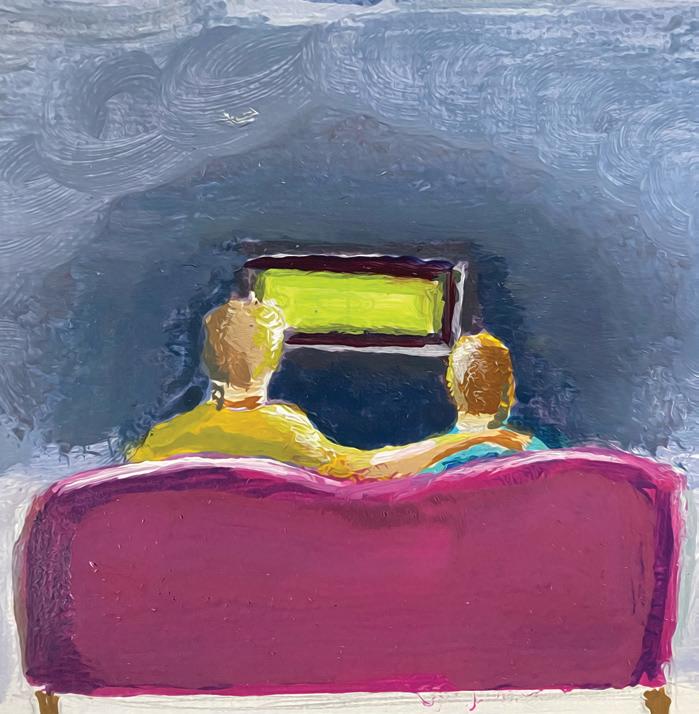
Caera Hannah.
Illustration by Calum Mayor
Photo by Alden Arnold
by Anne-Carter Riggs
For the Love of BUCS Wednesday
ELODIE COWAN Sport Writer
“No classes — what more could I want?” says third-year chemistry student and korfball player Fred Wilson when asked why he loves Wednesday. For studentathletes and society members Wednesday is not just another day — it’s sacred.
But what creates this midweek magic? What makes it the Union’s busiest club night? What drives students to skip morning classes, and endure grueling seven-hour bus rides to Nottingham — no air conditioning, a bus driver‘s questionable Oasis playlist blaring through the speakers?
For some, it’s the sweet taste of the postmatch pint. For others, it’s the excitement of seeing their Wednesday night hookup. And for many, it’s about belonging to a team, a community, and a tradition.
BUCS — British Universities and Colleges Sport — is the UK’s governing body for university sports. This organisation ensures that the leagues run smoothly. Thanks to BUCS, university teams compete weekly, with Wednesday dedicated to fixtures across almost every sport.
St Andrews University is home to
BEN BAGLEY Sport Writer
many sports enthusiasts and highperformance athletes. Some students from ex-professional footballers to current Scotland internationals and future golf stars, see Wednesday as a chance to showcase their skills outside of their degree.
Several St Andrews’ teams compete in the Premier North league, the highest BUCS division. The commitment from these teams is unmatched — twelve-hour round trips in cramped, non-air-conditioned buses are the norm. For them, the thrill of facing top-tier opposition outweighs the social envy of missing Pablos at The Union.
BUCS aims to ”provide students with exceptional sporting experiences that are inspiring, developing, and unifying.” But let’s be honest — the real unification often happens after the final whistle, later in the evening, when teams descend on Main Bar on a collective mission to ‘finish The Rainbow’ (a challenge to drink every flavour of Pablo).
Then there’s Sinners, the once-a-month madness that transforms 601 into a sea of sports teams in crazy costumes. Each club sticks to its theme — Magic Mike, togas, rodeo, or apres-ski — creating the kind of chaos only BUCS Wednesday can deliver.
The worst thing about BUCS Wednesday? The brutal Thursday morning
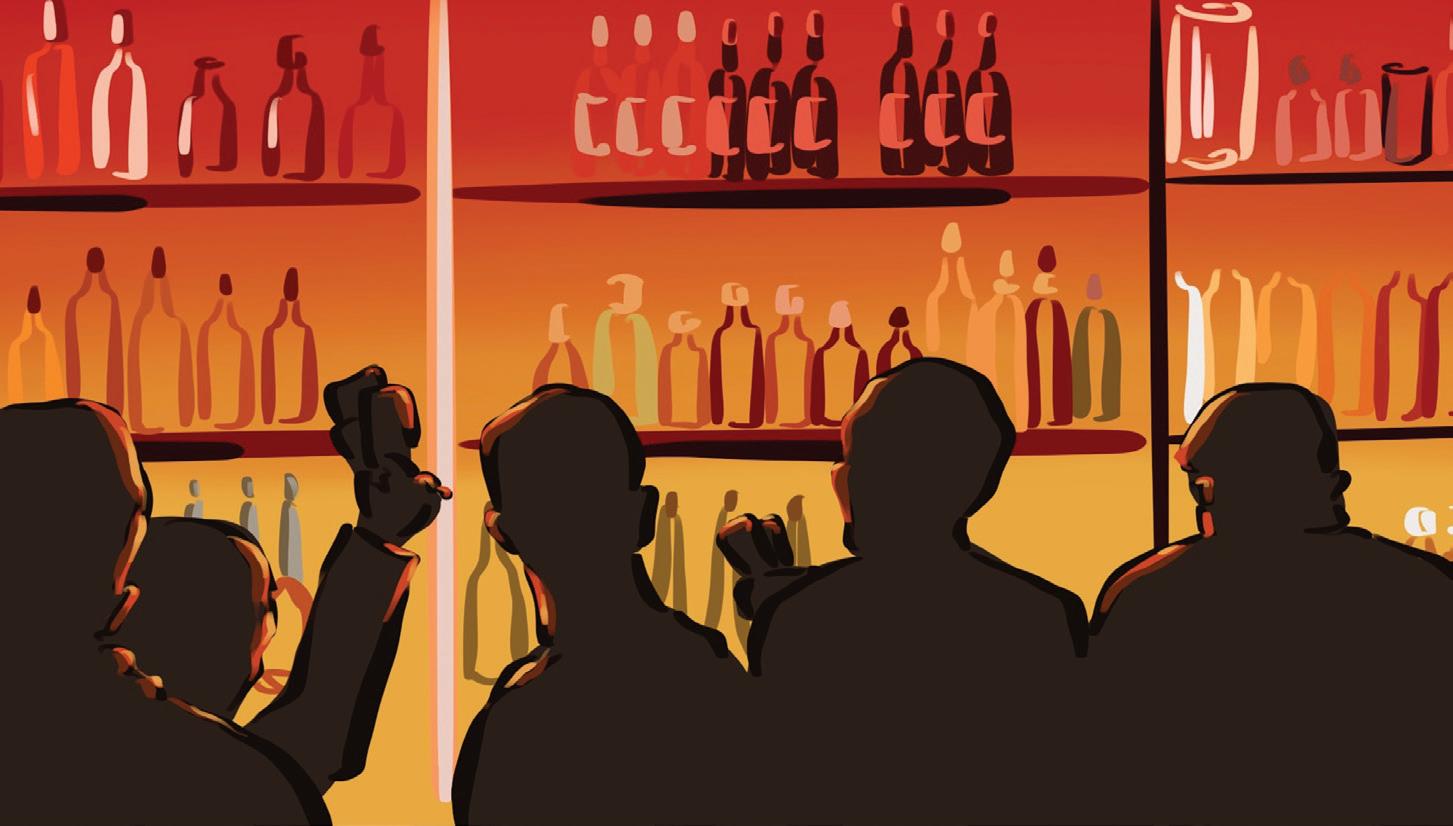
wake-up. That 9 am lecture looms, attended only by the brave. That one final pint? It wasn’t necessary — but at the moment, it felt like the best idea in the world.
In its most recent impact report, BUCS outlined goals to enhance student well-being, academic performance, and employability. You see, the skills learned from being part of a team — the discipline, the resilience, the camaraderie— stay with you long after university.
BUCS Wednesday — it happens once a week, yet its magic never fades.
For some, it’s about the competition. For others, it’s the social side. But for everyone, it’s about the sense of belonging.
Men’s 1s lacrosse captain Daniel Fatigati and football president Fabian Thies echoed this sentiment — what makes Wednesday special is not just the sport or the night out. It’s the community that comes with it. For the love of the competition. For the love of community. For the love of pints. For the love of BUCS Wednesday.
Knight
I Believe In A Swing Called Love
The Saint spoke to fourth-year golfer Narayan Murti about his beloved sport and why it might be the ideal partner this Valentine’s Day.
Having spent large parts of my childhood dodging stray golf balls on my local public course, I’ve generally shared Mark Twain’s view that “golf is a good walk ruined.”
For many students at this university, the sport famed for its flamboyant knitwear holds a quasi-religious status. They spend the harsh Scottish winter duelling with the elements on the Jubilee and shanking it in and around the North Sea on the Castle.
My flatmate Narayan is one such golf devotee, for his sins. He can regularly be heard discussing his “short game” in the Dunvegan or seen ambling down South Street in his ‘Media Officer’emblazoned Golf Society jacket.
A fourth-year Maths and Philosophy student, Narayan caddies back home in New Jersey over the summer. In 2023, he was invited by pro-golfer Berry Henson to caddy at the US Open in California. This is a man who knows his wedge from his seven iron.
With Valentine’s Day fast approaching, we sat down in the living room over a cup of the
Kenco to talk about Narayan’s one true love.
Was it love at first sight?
“No, it wasn’t. I started playing golf when I was 10 and it was extremely difficult. Golf is very intimidating to begin with and you just get very frustrated. It’s almost like a relationship. You’ve got to give it a shot and open your mind up to it. Then the love grows.”
So, it’s a grower not a shower?
“It certainly is. It was tough at the beginning.”
Golf seems to be a psychological game. What’s the key to keeping a healthy relationship with a sport that gets in your head?
“Like in any relationship, communication is key. Golf constantly gives you feedback and it’s your job to listen to it. There’s a skill in paying attention to the feedback that the sport is trying to give you. You’ve got to be self-critical enough to see what it’s telling you and act on it. If you have an open dialogue with golf, you’re going to get on with it and if not, well, it’s going to end in heartbreak.”
What’s the closest you’ve come to *over-extending the metaphor* breaking up?
“The closest I came was when I first arrived in St Andrews, which might sound crazy because this is the home of golf. It
beat me down. The weather was tough on my game, and I couldn’t keep up with some of the other golfers. I got really frustrated and came close to packing away the clubs. But walking past the golf course every day and just longing for it kept me going.”
Have you had any domestics on the course?
“When I first started playing, yes. I’d have domestics out on the course. My dad taught me to be disciplined and that outbursts of anger are disrespectful. Now I channel my anger to make me a better player.”
What’s been your best golfing moment?
“It was actually caddying for my dad in the annual golf club tournament back home. It was the final stage of the competition and about 200 people were crowded around the green. He had a very tough chip shot. I pointed him to a spot to aim for. It falls silent, he takes the shot, and chips it in. There’s this crazy video of the crowd going wild and I jumped into his arms. Special moment.”
Let’s talk putter grips. Delicate touch or firm grasp?
“Having played golf for ten years, I’ve learned that delicacy is the key. It’s all about feel and you have to channel your energy into where you want the ball to go.
It’s like some deep connection. It happens delicately, not firmly. A lot of beginners are tempted to grip very tightly but counterintuitively this gives you less control.”
What advice would you give to new players?
“Keep an open mind and trust yourself. Be diligent, work hard, but most of all be happy and enjoy it.”
Are you planning any stroke play this Valentine’s Day?
“I’m sure there will be lots of couples’ stroke play on the course, but I’ll be stroking back Weihenstephan in the Aikman’s cellar.”
If you’re single this Valentine’s, golf might be the perfect partner. Unlike a significant other, it won’t steal your favourite hoodie, force you to watch Grey’s Anatomy or criticise your bohemian approach to cooking a spag bol.
You can pick up a semester golf membership for less than the price of the couples set menu at the Rusacks. Even Mark Twain couldn’t grumble at that value for money.
Illustration by Sarah

